#she DOES however get possessed in part 2. will elaborate later.
Explore tagged Tumblr posts
Text

was going to change the paint to look less like blood but this version RULES honestly
#art#digital art#krita#take3series#VERY proud of this one#speaking of blood I was thinking if the series does get moved to a visual format then it would be hyper stylized red kind of color.#like Danganronpa esque w/ red blood if that makes sense? lol#i feel the need to stress that mallory is NOT the killer or the killed in any part of the third season.#she DOES however get possessed in part 2. will elaborate later.
31 notes
·
View notes
Text
Little Souls and Careless Gods: An Exploration of Worldbuilding in Toy Story
Sid did nothing wrong.
Or, let me clarify. The things Sid did wrong were: taking his sister’s toys and modifying them without her permission. That’s it.
Hi, my name is gretchensinister and I have a lot of thoughts about the worldbuilding in Toy Story.
I should admit at this point that I haven’t seen Toy Story 4, only talked about it with someone who has, so if some of my questions are answered by that movie or if it torpedoes some of my speculations, that’s just—that’s just an imperfection of this essay.
I barely know where to begin, but, I started with Sid, so I’ll keep going with Sid. Sid is a kid. Sid is a jerk to his younger sister, but she’s freely yelling across the house tattling on him, so it doesn’t seem like she’s suffering irreparable damage from this. Other things Sid does: wins a squeaky toy for his dog in a claw machine game, blows up toys with fireworks, takes toys apart and joins them to other toys to make new toys. Burns a toy with a magnifying glass.
None of these things is an immoral action, for a person who, through all lived experience (until the toy attack) understands that toys are objects. It’s not bad to give your dog an object to chew on. It’s not bad (morally) to blow up an object with a firework. It’s not bad to take objects (that are yours) and make them into new, different objects. It’s not bad to burn an object with a magnifying glass. From the toys’ perspective, Sid is a sadistic mad scientist type, but from everything he could possibly know, his “torture” of Woody is messing around with an object! His object! That he got from a claw machine! The pretend torture as a choice of play is worth questioning, but it’s not so uncommon as a media trope that an average kid would never have seen anything like that in an action-adventure context. And it doesn’t predict how Sid will treat actual living beings!
(As an aside, I’m firmly of the belief that if you own an object, you should feel free to do whatever you want with it. Set it on fire, take it apart to see how it works, use it as raw materials in a craft project, etc. And yeah I would make exceptions to this rule for like, privately owned culturally significant art or scientifically significant artifacts…but if they’re that significant…they shouldn’t be privately owned.)
So yeah. Sid gets traumatized because he treats objects like objects, and the objects don’t like that. Because they’re actually alive and have now promised to constantly surveil him.
And let’s be clear: Andy doesn’t know toys are alive, either. He never does. He just has a different play style than Sid, and more of an interest in keeping his toys intact. Andy has no empathy with Woody and Buzz, because he is not aware that they are beings that he could empathize with.
All right. Beyond Sid, what I really want to talk about is the nature of a toy’s mind/soul in the Toy Story universe. I will call this the toy’s animus. Much like with the soul and mind of a human being, the animus raises several questions. How is the animus created? Where does the animus reside? Is the animus a tabula rasa, or does it possess innate knowledge? Where does this innate knowledge come from, if so? Is the animus mortal or immortal?
The Toy Story universe offers various pieces of evidence to answer these questions, and they are all extremely worrying if toys and humans are both morally significant beings, though humans do not know this about toys.
Is a toy mortal or immortal?
In the Toy Story movies it is clear that toys believe they can die. Sufficient destruction of the body would cause a toy’s death. Sid’s plan to blow up Buzz Lightyear with a firework threatens his life. In Toy Story 3, the toys in the trash incinerator clearly believe that burning/melting will kill them. But, short of catastrophic destruction of the body, toys are immortal. Jessie suffers, but does not die, from withdrawal of her owner’s love. Stinky Pete was never played with by a child, and he’s alive as any other toy. Additionally, human-mimicking toys are not killed even when damaged in ways that would kill a human, though this does affect their ability to communicate. In the tea party scene in Toy Story, the headless dolls wave when they are referred to. (This raises more questions—how does a headless doll experience the world? They can still hear, but how? Also, why doesn’t the headless teddy bear move? Perhaps they simply don’t want to get involved in whatever’s going on with Woody and Buzz.)
I think, according to what we see in the movies, the animus is divisible, and each part of the divided animus contains only a portion of the cognitive ability of the whole. Moreover, the animus is not centered in the head, but rather dispersed throughout the body. I would further argue that splitting the body/splitting the animus, is traumatic, even when reversible. Consider that Buzz’s mental breakdown coincides with the detachment of his arm.
What does this mean for Sid’s creations? Well, it would explain why they don’t talk. The baby-doll head with the spiderlike erector-set body (aside: is this a reference to The Thing (1982)?) really has no reason to be mute, if a toy simply must have a mouth to speak. Its form is unconventional, but, I would say, still “complete.” But if the head only carries an incomplete animus, and the erector set parts carry no animus of their own (an assumption which will be questioned later) then the whole toy would not have enough animus for verbal communication.
Janie the doll and the pterodactyl, with their switched heads, suffer significant disruption of their animi. Would their fractured animi eventually merge to form a new animus for each new body, with a different personality than Janie or pterodactyl? What part of the “Barbie” personality lingers in the animus of the toy crane with Barbie legs?
There is an exception to the concept of the fractured animus, however, and that is Mr. Potato Head. Mr. Potato Head exists in several parts to begin with, and mere separation does not fracture the animus. Curiously, though, some parts of Mr. Potato Head do not appear to contain any part of his animus, such as his plastic potato body. He retains all of his personality and ability to communicate when he has to put his features on a tortilla (?—don’t remember this part well) even though he is from an era of Mr. Potato Heads where his features are only meant to be put in the plastic potato body, not random foodstuffs. (Another question here: what would happen if an even amount of Mrs. Potato Head and Mr. Potato Head features were put on one plastic potato body? Do both animi retain coherence?) It is impossible not to wonder how far apart the features of Mr. Potato Head could be spread and the animus remain whole. At least as far apart as different buildings, as shown in Toy Story 3, but how much farther?
Creation of the animus and innate knowledge.
We are now about to embark on the specific topic that fills my thoughts now when I think about the Toy Story universe. I believe I will first fix myself a vodka cranberry (note: not just vodka and cranberry juice. To make it properly you must also add a splash each of orange juice and lime juice) and read a synopsis of Toy Story 4. Forky’s creation is a deep source of trouble here, and I must fortify myself to face it.
Where do I even begin? Okay. Bonnie, a kindergartner, creates Forky from items salvaged from the trash and names him. He comes to life after being named. According to the synopsis Forky then suffers an existential crisis because he believes he his trash and not a toy. So in this case, the animus appears to arrive after naming, and the animus is not a tabula rasa. The history of the materials appears to have some effect on the animus? (What this might mean for Rex or the plastic army men is especially concerning here.) It doesn’t make sense for Bonnie to think of Forky as trash, so this conviction has entered Forky’s animus from somewhere other than his creator. Also Bonnie has created sentient life without being aware of doing so, probably before being able to write a full sentence.
That’s troubling enough, because, to the eyes of adults or even older children, Forky is garbage. I project Forky’s lifespan of play to be that of months. And he won’t get passed onto other children. Depending on how Bonnie’s community disposes of trash, he may linger with an intact animus, at a landfill, for longer than Bonnie’s own life. It boggles the mind. (And invites hoarding in the empathetic.) However, despite all this, I would be cool with it if this was the only way toys became animate: being owned/named/played with by a child. That could be a complete worldbuilding conceit.
But that’s NOT how animi are generally formed in the Toy Story universe. Let’s back up to Toy Story. Buzz Lightyear has a personality and memories of his history as a space ranger right out of his box. And as we see in Toy Story 2, every Buzz Lightyear comes with that same initial personality. A commercial in Toy Story shows aisles upon aisles of Buzz Lightyears. Something has enabled the creation of thousands, if not millions, of identical animi. There is no direction this can go that isn’t kind of batshit.
Buzz Lightyear and the story that forms his memories were designed and created by adults. It was someone’s (and probably a team’s) job to design a toy that would be popular for a specific demographic, with (if I remember correctly) a cartoon that elaborates on the story and can basically serve as a long-running commercial for the toy. There were probably team meetings, and focus groups, and brand analysis to come up with the name “Buzz Lightyear.” And in such an endeavor, while I would like to imagine that there were some truly creative people involved who cared about the design and story, the people involved would not be the ones playing with the toys as toys want to be played with. And this is where every Buzz Lightyear animus comes from? But how? A manager or director approves the name and then…what? Is there a wellspring of animus that forms? Is it tied to the prototype? The factory workers in Taiwan don’t care about Buzz Lightyear the way Bonnie cares about Forky, and yet their actions in completing Buzz Lightyears call the animi to the plastic bodies. (And the animi are there, without a child’s touch. Stinky Pete was aware in his unopened box. Other toys opened a new Buzz Lightyear and got a living Buzz Lightyear.) And even leaving aside how the animi get into the Buzz Lightyears, the fact is that with millions of Buzz Lightyears out there, we have to conclude that the process that created his animus/animi is orders of magnitude more powerful than what Bonnie did to make Forky. Even assuming some personal care held by Buzz’s designers towards their design, it gets weird. The imaginations of adult toy designers are that much more powerful than a little girl creating and naming her own toy? NOT the way I would expect such a story-world to be set up, but the evidence is there.
And what if the designers of Buzz Lightyear weren’t particularly passionate? What if their boss just said “space is popular now, make me a space toy” and that’s the only reason why they did? That could very well be the case for a different type of toy in the series: the claw machine aliens. Those toys were not designed as a soulful passion project. I’m trying to write this to not be mean to designers who work in not-so-great places, but seriously. We have all seen generic toys in claw machine games before. They were not made to be immortally loved. (And yet! This is what the animus of a toy inherently desires!) Now, the claw machine aliens do seem to have much less backstory than Buzz Lightyear, and have personalities (or maybe just personality)/culture based on the nature of the claw machine. That makes sense, since they wouldn’t have been given a backstory with creation. The point is, though, that they still have animi. In the process of creating these cheap, cheap toys, by the dozens and hundreds and thousands, somehow their bodies were invested with full, identical animi. Adult, corporate creation somehow gives more life to toys than individual, child-led creation.
There are more questions to ask. If adults still have the power (and MASSIVELY MORE power) to invest toys with animi that they also possessed as children, then what can be invested with an animus? What are the limits of toy-ness in the Toy Story universe? Is it the name? I don’t think it’s the face, because there’s Woody merchandise in Toy Story 2 with Woody’s face on it that doesn’t talk. And I think that some faceless toys are shown to move independently/have an animus (possibly including things like LEGO—are the bricks a hivemind? Do the minifigs live inside sentient structures? Can they communicate with these structures? Also, if so, the erector set legs on Sid’s spider baby toy should have added to its total animus. But that’s not the corporate intent, so they’re still voiceless.). Christine (1983) could fit into this universe if the name is of primary importance (movie backstory for Christine, not book). But this would also mean that literally every boat and ship was sentient, but secretly so.*
If the name isn’t the important thing, is it the intent that the object be played with as a toy? In this case, that would mean that Bo Peep’s animus was not mass-produced, as she was originally part of a lamp if I remember correctly. Child-created animi would therefore be more common among non-toy objects than manufactured toys. I also want to bring The Brave Little Toaster (1987) up at this point. In this movie a group of appliances behave similarly to Toy Story toys in some ways, including being played with by their owner and then missing his attention to a high degree when he goes to college. However in this film all appliances and cars have animi, and I personally do not want my vacuum cleaner to feel any kind of way about me, or ever think I have played with it, because I hate vacuuming and would neglect it to death if feasible. (That being said���roombas in the Toy Story universe can hardly avoid being invested with animi, I imagine, no matter the details of the worldbuilding structure.) I bring this up, though, because Wikipedia notes that the original members of Pixar worked on The Brave Little Toaster. Toy Story was released in 1995 and was Pixar’s first feature length film. There is a connection, is what I am trying to say.
I think I have to go with: intent of the object to be a toy and/or being played with as a toy invests a toy with an animus. If it was the naming, then many, many public statues would be as alive as Woody and Buzz, and the people of Denver I’m sure have enough to worry about without Blucifer (Jiménez, 2008) galloping around. Bizarre to say that the least troubling option places mass production on a higher level of investing power than a child’s imagination. And I mean what I say about the mass produced animi being somehow more powerful than child-created animi.
Let’s go back to Sid’s creations. What is wrong with them? Why aren’t they able to communicate like Forky? Possibility 1: Sid just doesn’t have the creative power that Bonnie does. I don’t like this because, as I said at the beginning, Sid is not doing anything wrong by making these chimera toys. He’s treating objects as objects, and the difference between Sid’s chimera toys and Forky is that Forky’s component parts were not originally part of mass-produced toys. So, (from a worldbuilding/Watsonian perspective), I have to go with possibility 2, which goes like this: mass-produced toys are imbued with animi because they are toys. Sid’s chimera toys suffer from their animi being fractured when he alters them. But these fractured, mass-produced animi retain enough coherence and power that Sid, a child, cannot replace the fractured animus with whatever he imagines for his new creations. He’s an imaginative kid! But the corporate animus cannot be expelled. The factory animus is the underlying animus and cannot be removed once the toy is a toy. It can develop with memory and experience, but it will always be the toy making corporation that brought the spark of life, not the child that actually plays with the toy.
And this actually corresponds to Sid’s toys’ decision to rebel and help Woody and Buzz. Their animi are more loyal to the corporate intent that first created them. Sid made them into something new, presumably plays with them, and yet they are not Sid’s. They are meant to be read as broken and tortured (Sid has changed them from their factory-created wholeness), not as new beings. A factory-created, owned object, is meant to be held with the same level of care and maintenance of coherence as a living being in the Toy Story universe. What a child imagines about their own toys has less creative power than a distant designer who’s been told to come up with something appealing to put in a claw machine. Children only have animating power for their toys when they make them out of raw materials.
On the one hand, it’s tempting to say that of course the toys aren’t Sid’s, they’re their own people—isn’t that what having an animus means? But Woody, for example, find it very important that he’s Andy’s toy—a possession—“a child’s plaything.” Andy writes his name on him and this is very important to Woody, enough a part of his identity that when Andy’s name is painted over by the restorer in Toy Story 2 the scene reads as an erasure of something important to him, not as a restoration of his autonomy. Time and again we see that toys want to be owned by children.
This is another place where things get weird. First, I raise the question: What do toys need to keep animus and body together? Not much—only a certain baseline of bodily coherency. They don’t need to take in anything from their environment. More interesting, though, is that they don’t need anything from the children they bond to. Shelved, boxed, and forgotten toys suffer, but they don’t die from these states. No toy will ever find a toy’s corpse the way a human could find a human corpse—whole in every way except for the absence of the animating spirit.
So: toys as entities need little. The next question is then, what do toys want? Toys want to be owned and played with by a child (I say child and not children, because the communal state of the daycare in Toy Story 3 is clearly not desirable to the toys). Woody relishes his place as favorite and most played with toy at the beginning of Toy Story. In Toy Story 2 Jessie grieves when her child outgrows her. Stinky Pete was ignored by children for years, causing him to develop the abnormal belief that it would be better for the Woody’s Roundup toys to be preserved in a museum.
(At this point, I spot another thread to follow. It seems that for a toy, the most important relationship in their existence is meant to be toy + owner. In Toy Story Woody is very invested in making Buzz understand that Buzz is a toy and not a space ranger—Buzz is supposed to stay with Andy. In Toy Story 2 the consequences of not being owned by a child are grief and violence. But at the end Woody tells Buzz he’s not worried about Andy outgrowing him, since they’ll always have each other. Now, Toy Story 3 builds up Buzz/Jessie and in Toy Story 4 Bo Peep returns and Woody leaves Buzz and the other group of Andy’s toys for a life with her, but Woody also leaves the toy + owner life to be with Bo. Toys aren’t made to have an independent existence, yet this is how they end up, also acting as matchmakers to help lost toys find new owners and enter into new toy + owner relationships? THERE IS A WHOLE OTHER ESSAY HERE.)
To stay within just one rabbit hole here, however, I must focus on this: Toys want to be owned and played with by a child. They bond with child owners who do not deliberately alter their bodies (I add this because again, Sid’s toys do not appear to be bonded with him). But within this framework, there must be essential pain within a toy’s existence. Toys are immortal unless destroyed. Toys will experience actual play with a child for, let’s say, ten years, maximum, and that’s if the toy is given to the child when the child is very young and the toy is more classic/versatile than most. That’s way shorter than the best human friendships and familial relationships, and at least human beings can often reasonably hope to have lifespans that are of comparable lengths. Oh yeah, and among human beings people are usually AWARE of the relationship that’s taking place. So toys want to form deep bonds with their children and want to have these relationships last. But the relationships can’t last. I’ll gladly state that play, in some form, is necessary for humans to thrive throughout their lives, but the kind of play that the toys in Toy Story find ideal is a childhood phase of play that that most people naturally outgrow. And even if a human did engage in play ideal for toys throughout their entire life, toys are immortal unless destroyed. All toys will lose their owners, and usually after a pretty short handful of years.
The aftermath of the owner + toy relationship is always painful for the toy. What are the options? To remain owned, but not played with: perhaps the “best” option, but it still leaves the toy with only a memory of a full life. Is a shelf life really a life? This is what was facing Woody, I believe, if Andy had taken him with him to college. Another option: to be outgrown and forgotten. This is what happens to Jessie, and it is a deeply, deeply painful experience for her. She develops claustrophobia from being stored in a box. To be donated or sold at a garage sale: also a source of trauma and panic for the toys, but still better than the worst fate, to be thrown out. But toys that have been separated from their previous owners are so often grieving and/or bitter in the Toy Story series.
This is troubling, to say the least, but it also loops back to questions about the animus and memory. Toys are not tabula rasa. Buzz has a strong personality and memory set from his unboxing. Mr. and Mrs. Potato Head do not need to court each other. Tour Guide Barbie will act as a tour guide in the absence of children. But with time, and accumulation of true memories as a toy, the toys will develop their own personalities, even if the animus starting point can often remain a strong influence. In Toy Story 3, however, we learn that certain toys, such as Buzz Lightyear, can be returned to the original animus state through a factory reset. I hardly know what to do with this. It wasn’t a permanent reset; Buzz’s memories and the personality he’s developed do come back. (But now he also has access to a “Spanish mode” that is…sexier (can such a word apply?) to Jessie than his English mode. Also other toys can put him into his mode against his will. There are so many worms in this can. Sexualization of Latinx people, can a toy expect bodily autonomy from other toys, etc.?) But not every toy has a reset button. Woody doesn’t. Slinky Dog, Rex, Mr. Potato Head, etc. don’t. Does the threat of a reset only affect toys with bodily components that could be considered brain analogues, i.e., microchips? But the animus is not the “brain” and neither does the “brain” store memories/personality. I really, really don’t know what to do with this, except it seems once again to assert the ultimate strength of the adult/corporate-created animus.
The point is, toys can lose their memories, but when we see that in the movies, it leads the toy to go back to their earliest state.
Now: a mystery. In Toy Story, Woody has developed enough memory and personality that he is well aware of being a toy and is involved with the life of Andy’s room in ways that neither his sheriff role or Andy’s imagination reasonably encompasses. (Consider the “Plastic Corrosion Awareness Meeting.”) All right. This would be of no concern if Woody was a generic wild west doll, but he’s not. He was made to represent a character on the Woody’s Roundup TV show in the 1950s. He would have had an animus strongly imprinted with that backstory just like Buzz Lightyear had his strongly imprinted space ranger backstory. Well, then maybe this means that Woody just never lost his memory. That would be the best explanation. That’s why he has a personality mostly free from this imprinted backstory, having been Andy’s favorite toy for some time. But Woody has lost his memory. In Toy Story 2, Woody learns (learns!) that he’s a representation of a TV character. He meets Jessie and Bullseye and Stinky Pete without knowing who they are at all. Woody has somehow completely forgotten his origins. He experienced memory loss that brought him farther away from his animus starting point.
Okay, so there are multiple kinds of amnesia for toys; I was wrong in my earlier assertion that memory loss tends to the origin animus. But I want to keep poking at Woody’s memory issues because of something else that Woody’s timeline leads me to conclude: Andy is not Woody’s first owner, OR Woody was boxed up and forgotten for DECADES before Andy. Actually, he’s probably spent a significant amount of time in storage or on a shelf regardless of whether Andy is his first owner or not.
Toy Story was released in 1995. If the story is set in the present, then Andy is very close to my age. Now, Woody is “an old family toy” according to Toy Story 2, and Al, as a toy collector, was so thrilled and astonished to find a Woody at a garage sale that he stole him when he learned he wasn’t actually for sale. This leads me to the conclusion that Woody toys aren’t in continuous production. Woody was probably only manufactured during the height of Woody’s Roundup’s popularity, in the 1950s. So there’s two options for Woody’s ownership history. I’m also going to presume in both cases that Andy’s father was the parent that previously owned him, though there’s no reason why his mother couldn’t have been the owner.
So, option one: the young parents/young grandparents option. If Andy’s grandparents had his father when they were about twenty, and then Andy’s parents had Andy when they were about twenty, then Andy’s grandfather could have gotten Woody at ideal playing age and then later passed him down to Andy’s father and then Andy’s father would have passed him to Andy. I don’t think this is the case, though, because Woody still has his incredibly rare hat and a functional voice box. If Woody had been played with by a child at ideal playing age at the height of the popularity of his character’s show, I think it’s likely that he would have gotten played with so much (and taken to places so much) that he would have lost his hat and his voice box would have worn out. Woody didn’t start off life as a collectible, and play causes wear and tear on toys. And if Woody was originally the grandfather’s toy, then he would have gone through another round of play with Andy’s father. Woody’s condition is too good for that. Unless, that is, Andy’s whole family is made up of people who are unusually careful with their toys? That’s sort of an intriguing idea, since it means that Sid’s actions look even more horrifying by contrast, and generations of “ideal owners” for Woody obscure the bizarre nature of the life of a thinking, feeling toy. However, the Toy Story universe keeps raising questions in Toy Story 2-4 about what it means to be a toy, so there doesn’t seem to be a motivation in the series for such obscuring. This is despite the fact that Woody’s amnesia does obscure some things about the nature of a toy’s life, at least in the original Toy Story. (I know the Doylist perspective answers all this easily—this isn’t what the audience is meant to think about, Woody’s backstory as a toy from a 1950s TV show isn’t important in Toy Story, and in fact this backstory didn’t exist until Toy Story 2 was created.)
Regardless, I don’t think the young parents/young grandparents option is the right one. Instead, I choose option 2: the slightly older parents option. Woody’s Roundup is a TV show from the 1950s. It was popular enough to lead to a lot of merchandise, not just the dolls of the main characters. Brief research shows that in the 1950s television Westerns were incredibly popular, and there were Westerns made for kids and Westerns made for adults. The question I’m trying to get at here is trying to figure out how Andy’s grandparents would have known about a kid’s Western show. But, it’s really not that difficult. In this timeline I’m building now, Andy’s father would have been born in the 1950s, making him in his early-mid thirties when he became Andy’s father. Given this timeline, it’s overwhelmingly likely that Andy’s father has siblings, including older siblings, that might already watch Woody’s Roundup. Or, even if Andy’s father was the oldest child, it’s also overwhelmingly likely that Andy’s grandparents’ friends had plenty of kids of their own and probably talked among themselves about what kids liked. The significant thing in this timeline is that Woody would have been given to Andy’s father when Andy’s father was very young. Perhaps too young for a Woody doll, but perhaps also with the assumption that Andy’s father would grow into the doll. So Woody is unboxed and waits on a shelf for a couple years while Andy’s father grows a little. My theory is that Woody’s Roundup was no longer on television by the time Andy’s father was at the right age to start playing with a doll of Woody’s type. This would have two consequences. One: Andy’s father would have been unguided by the TV show in regard of how to play with Woody, meaning that Woody would have formed many memories unrelated to his original animus in this early stage of his life. Two: even though Woody was played with, he never was Andy’s father’s favorite toy, which is why he was able to be passed down to Andy in good condition (and still with his hat).
In this option 2, which I feel is more likely, Woody has probably spent at least 25 years on a shelf or in storage. So why is this important? I think it’s important because Woody doesn’t act like he’s been through the decades-in-storage experience, or the experience of having an owner outgrow him. He sympathizes with Jessie after learning her story, but he says nothing about having experienced anything like it himself. And as far as the movies are concerned, his worries about Andy outgrowing him are new worries. But they can’t be new! He’s already been outgrown at least once before! I mean, with Andy he’s a favorite toy, so that’s a unique owner + toy relationship status that he (probably) didn’t have before. Maybe that amplifies what he’s going through this time?
But there’s another aspect to Woody’s experiences that I want to touch on. All the other toys he would have known as Andy’s father’s toy are gone. There are no other “heirloom” toys in Andy’s room, or at least there is no evidence of this. All of Andy’s other toys seem to have been purchased just for Andy, and purchased new. There is no reference to garage sale trauma, previous owners, or anything like that. And as we’ve seen from other toys throughout the series, toys remember that kind of thing! But Woody doesn’t. His animus is one that shows years of experience building over his character backstory, but he never acts like he’s experienced being outgrown or losing all his toy friends.
Or at least he never says anything about such experiences.
I think it makes sense to read Woody’s amnesia as genuine. But I also think it would be reasonable to read his character as one that has undergone traumatic experiences and has responded by burying them so deep within his mind that he has no conscious access to them, even though they influence his current personality and life. (It’s impossible to know, but do toys in every household respond to birthdays and Christmas with such intense monitoring—with the desire for even the slightest early warning of replacement? Woody is the one who worries most about these celebrations, extremely anxious of his own status as favorite toy.) That the ending of Toy Story 4 removes him from the cycle of ownership and outgrowing can’t be ignored. Better to not have an owner than to experience losing an owner again, and again, and again?
But I do think there is one other possibility: Andy’s ownership of Woody caused him to lose all his memories of Andy’s father. A child may not be able to give a manufactured toy a new animus, but by possessing a toy in a play relationship (as opposed to a collector relationship) a child may be able to overwrite any memories of the toy’s previous owner. The process doesn’t happen instantaneously, as Andy’s toys don’t immediately forget him upon being transferred to Bonnie, but it would certainly explain why Woody makes no reference ever to a previous owner, even though he was most likely manufactured at least 35 years before coming into Andy’s possession. However, Jessie’s story argues against this. While she is happy among Andy’s toys, there’s nothing to show that she is forgetting her own past.
The possibility of a new child owner driving out all thoughts of the previous one is interesting, as it puts some degree of power over the toy’s animus back with the child. However, in the Toy Story universe, it’s clear that if this is the case, it’s not an instantaneous process. And if it’s not an instantaneous process, then it becomes overly complex. What memories would be driven out? For toys less adventurous than the main characters of the Toy Story movies, their whole lives are centered on their owners. They live in their child’s room/house. Anything that took place there would have to be forgotten to not bring up thoughts of the previous owner, including conversations with other toys that were friends of that first toy. At this point we approach a state of complete memory loss before the claim by a new owner. A gradual process would at least allow continuity of personality, since new memories under the new owner would be continually being made. But then, some new memories would have to fade, also. For wouldn’t a toy talk about their past while they could still remember it? And wouldn’t their new friends maybe bring up their past in conversation sometimes? They might even talk about the process of forgetting. That process would be noticed and known among toys. No, after thinking about it, I would say that there is no inherent forgetting process. Memories will mostly tend to stay, with whatever pain and joy they bring. And there will never be any transition process that is easy for the toy.
Woody’s amnesia remains his own, and remains his best defense against the trauma of being outgrown and shelved or stored for many years.
Toys have a strange and painful lot in life, semi-immortals being made to be silent companions to the briefest stage of a mortal lifespan. They live because they are made for children, but for most, in this world of mass production, children do not create them. Their animi are the spawn of creators who have no intent to create thinking, feeling beings. Escaping the stamp of such thoughtless creation means living long enough to know the deepest loss a toy can experience. Sometimes the only way to move forward from such loss is to forget. And yet, there is little will for most toys to move beyond this cycle. Toys overwhelmingly retain their roles as objects. I’d like to say that maybe this means that play is worth it, that temporary joy is worth it. But maybe it’s just the nature of being a toy. After all, if there’s any intent in their creation, there was the intent that they should be objects.
*I would never leave a dangling asterisk. My previous point was about ships and boats, but, if seagoing vehicles live because they are named, then there’s no reason why land vehicles would not do the same. It might be possible to argue that the Cars universe came about after some cataclysm wiped out humans and left only named vehicles behind.
Other avenues of investigation that were beyond the scope of this essay:
1) The situation between the Diamonds and every other gem in Steven Universe is highly analogous to the situation between humans and toys in the Toy Story universe, save for the crucial difference that the Diamonds have no excuse to not know that the other gems are complete feeling, thinking beings and to treat them as such. It was actually parallels I saw between Spinel + Pink Diamond and Jessie + her owner that got me thinking about aspects of the Toy Story universe in ways that I know are meant to be ignored. Also Pink Diamond bringing all those little pebble people to life just by crying on them. That’s a lot of responsibility coming from a solitary expression of emotion!
2) I’d be curious to know if a hugely popular series based on the agency of objects has had an effect on fan culture at all. Or it might at least be a way to examine actions taken on behalf of characters. Fictional characters, after all, don’t feel any kind of way about the situations and relationships people envision them in. They’re mental objects like toys are physical objects. In the real world is anyone going to argue that putting the faces of dolls or action figures together and making kissing noises is something to worry about? Is anything about putting a naked Barbie on top of a naked Ken a harmful act? In the real world I would say no. Also, with full awareness that this is a can of worms, what is the impact of such things in the Toy Story universe? Obviously this wouldn’t be addressed in any canon. But the Toy Story universe is supposed to be like reality with one big secret so there are kids that are definitely using their toys to play out love stories and stories including a vague understanding of sex. And another aspect to all this…if you’ve seen Booksmart, consider one of the characters’ uses of her childhood stuffed animal. I understand that this is not uncommon.
All right. I think I’m done now. And that I will probably go get another drink.
(I had a few baby dolls as a child that included their own toys as accessories. H—how would THAT work?)
#I've been out of school for YEARS and yet I was still compelled to write a long and slightly deranged essay in mid-December#Toy Story
155 notes
·
View notes
Text
French Nuns And Newspaper Clippings: The Real Stories That Inspired The Exorcist (1973)
The year is 1632.
We are in a remote commune in Northern France. The situation is bleak: an outbreak of plague has started snatching lives again, and King Louis XIII is ordering the walls around Loudon to be torn down. The locals are more divided than ever.
But things are about to get worse.
Way worse.
The local nuns are beginning to act strange.
It started when one young nun claimed she had a vision of a dead priest. Suddenly, all 17 clergywomen are reporting similar visions. They then begin cussing, shouting, and displaying more and more aggressive behaviour.
17th century nuns do not act like this.
Oh no, this was something unholy. This was demonic possession.
331 years later, this little-known historic tale would feature as one of the main inspirations behind horror’s most iconic movie.
Yep, the film that still gives you nightmares of young girls walking down stairs crustacean-style is based on a true story. But it’s worse than that. It’s based on two tales of alleged possession, several real-life people, and a demon many still worship today.
*nopes the f*ck out*
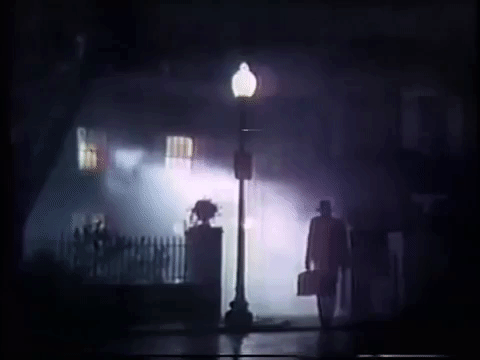
Let’s Talk About The Exorcist
Let me just clarify something: the exorcist is not the creepy, possessed ‘lil girl. An exorcist is a person that performs exorcisms - so here, it’s the priests.
The Exorcist was originally a book written by William Peter Blatty. Adapted to a film series (and a TV show) starting 2 years later, they both shared a close plotline. Well, to begin with, anyway.
A statue of a demon is found in an archaeological dig of northern Iraq. The discovery unleashes a mysterious spirit/demon/god called Pazuzu. On the other side of the world, a young girl begins exhibiting strange behaviour. Regan, a typical 12-year-old American girl, refuses to eat or sleep and becomes aggressive. All the while, strange things happen around the house.
The doctors provide no answers to her behaviour, so the mother of the supposedly-ill child turns to religion instead. She finds help in the form of a priest who is experiencing a crisis of faith and consequently doesn’t believe this is demonic possession. But a couple chats with the girl convinces him that yep, she’s bunged up with a demon. So, he asks the bishop if he can perform an exorcism. A priest fresh off that dig in Iraq is shipped over and they get to work. During the final exorcism, one of the priests opts to save the possessed girl by asking the demon to possess them instead. The possessed priest chucks himself out of the window and as he falls to his death, regains his faith in God.
The Exorcist is one of the most famous horror films - if not, the most iconic - of all time, from the traumatic FX makeup of a possessed Regan to sequences ‘80s America wasn’t ready for.
But The Exorcist was not a stand alone film. Contrary to popular belief, what followed was 4 (soon to be 5) sequels ‘n’ prequels that unravelled a deep, dramatic plotline. There’s a reason we don’t hear about them.
In the following films we see the aftermath of Regan’s exorcism and emerging doubts about whether she was in fact really possessed. Political and theological themes rise to the surface, looking deeper at the priests that conducted the exorcism rather than the victim. At the same time we take part in an archeological dig, meet a serial killer, and get a front row seat to a battle during WW2.
It’s a wild ride. But this ride is brimming with reality.
Blatty directly cited inspiration from a number of sources, most famously the 1949 demonic possession of Roland Doe that he first heard when studying at Georgetown University. But he has also claimed that many of the characters who navigated the possession of Regan were based on real people.
Take Father Merrin, the exorcist leading the exorcism: he was based on a British archaeologist that excavated the caves where the Dead Sea Scrolls (ancient manuscripts written in Hebrew) had been found.
But the nature of the exorcism that filled out a majority of the film were informed by the work for Father William S Bowdern, a Jesuit priest who exorcised Roland Doe himself.
However, it wasn’t just the mortals that were inspired by real, historic figures.
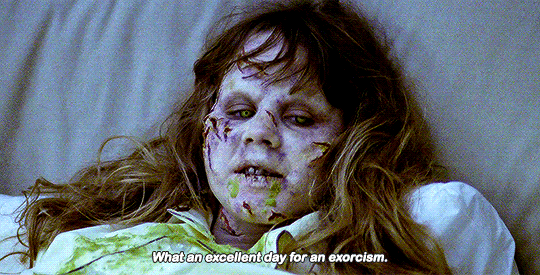
Pazuzu Is An Actual Worshipped Demon
Without Pazuzu, there would be no possession. Without Pazuzu, there would be no exorcism, nor the need for an exorcist.
We only see the demon in flashes - but these moments inherit a history that takes us back as far as 3500BC. Pazuzu was an ancient Mesopotamian or Assyro-Babylonian god that was the king of the demons of the wind. He brought storms and drought, and although recognised as an evil spirit, he also drove away other evil spirits. He strives to protect us from plagues and misfortunes, and his rival, Lamashtu, causes harm to mother and baby during childbirth.
He is known as both a demon and a god, but in The Exorcist is recognised more as the former.
We do catch a couple glimpses of Pazuzu, but we only see his face clearly when he begins to take over young Regan. The pasty white face and blood red eyes don’t fit ancient lore: Pazuzu is traditionally depicted as having the head of a lion, the body of a human, the talons of an eagle, a pair of wings, a scorpion’s tail, and a ‘serpentine penis’ (I can’t work out if this is the penis of a snake or a penis that looks like a snake and like I don’t wanna know k).
The Exorcism Of Roland Doe
It’s one of the most famous cases of possession - and we don’t even know who the victim actually was.
In 1949, American newspapers began to pick up on the story of an exorcism in Maryland. A teenage boy was at the centre of mysterious poltergeist activity after the death of his spiritualist aunt. She was the one that first introduced him to an ouija board.
After typical paranormal activity took place, priests were summoned to exorcism him. During these exorcisms, furniture began to move by itself, the boy began to attack priests with rogue bedsprings, he began to speak in an unknown voice, the mattress he lay on began to shake, and words like “evil” and “hell” began to appear in scratches upon his body.
It was a very similar state to the one Regan was in during The Exorcist.
Roland Doe (a pseudonym, obviously) to this day has remained anonymous, and - if alive - he would be 86 years old.
Despite this being the most known case of alleged possession - rivalling only that of Anneliese Michel - it has received a large dose of skepticism and debunking. The supposed location of the exorcism and some personal details of Roland Doe have been contested. Plus, many believe Doe was actually a spoiled, attention-seeking bully who simply repeated Latin phrases heard at school in order to create some elaborate prank.
Regardless of whether it was real or not, it is a landmark moment in paranormal history.
And 300 years before a 14 year old lutheran began to growl Latin at his family members, a group of women began to show similar signs of a haunting.
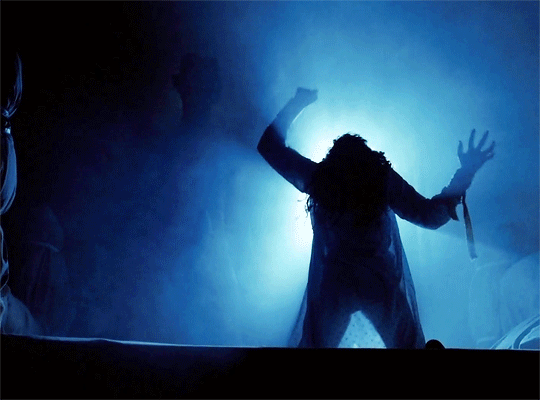
The Possessed Affair Of Loudon And Aix-en-Provence
I’ve already introduced you to the possessed nuns of Loudon. But it turns out The Exorcist also took inspiration in another French convent: Aix-en-Provence.
The nuns of Loudon pinned their possession on the demon Asmodai and gave a number of different answers as to who summoned it. Some claimed it was either a priest named Peter or Zabulon (a biblical figure). But a week after this, a man named Urbain Grandier who had amassed a lot of power and a strained reputation in the community was considered the culprit.
Soon after the nuns first exhibited strange behaviour, they were hidden away and the symptoms stopped.
The accusations levelled against Grandier were clearly inspired by political motives as he had publicly attacked the cardinal’s work and the taking down of the wall. But locals say he would appear at random in the convent with no one sure as to how he got inside. It was even claimed that he had made a pact with the devil - from which a physical contract was supposedly uncovered - and that he had attended witch’s sabbat.
The priest was executed for sorcery and given ‘the boot’ (a method of torture).
Loudon and Aix-en-Provence are considered cases that fit in well with wider witch trials taking place across western Europe in the 17th century. The possession of the Ursuline nuns of Aix-en-Provence were similar to that of Loudon - but were just a tad more mental.
20 years before Grandier was convicted, a young woman, Madeleine de Demandolx, confessed to the superior of the convent that she had been intimate with the local priest. She was sent away to Aix-en-Provence to get some distance but soon began to do some rather out-of-character things.
She would have convulsions and soon the other nuns began to do the same. It appeared to be contagious.
But things got hella weird when the nuns gathered together in a holy cave that Mary Magdalene was meant to have once lived in (Sainte-Baume) to be exorcised. Instead of just shaking, they all tried to outdo each other in symptoms of possession.
Once would cuss fervently; another would speak in a deep, demonic voice.
A political story soon unravelled full of accusations, executions, and even Madeleine being released from jail at 77 for her alleged witchcraft.
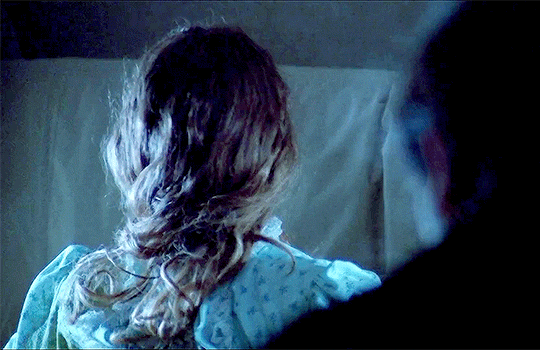
So - are you ever going to watch The Exorcist after this?
(Me neither.)
If you liked this post, go on and let me know with a like ‘n’ a reblog. And if you want to hear somethin’ spooky every Saturday, go on and hit follow!
#The Exorcist#exorcism#the exorcism of emily rose#the exorcist 1973#the exorcist 2021#roland doe#anneliese michel#the last exorcist#The Possession#demonic possession#spiritual#ghosts#demon#paranormal#supernatural#real ghost stories#based on a true story#true ghost stories#evidence of the paranormal#horror films#best horror movies#best horror movies 2020#scary movies#scary stories#the conjuring#ed and lorraine warren#loudon possession
32 notes
·
View notes
Text
Alive Again Part 2
Harry Potter AU
Link to Part 1
Pairings: Regulus Black x Reader
Rating: M- smut
_____
Gravity…
Regulus had always been your gravity and you weren’t afraid to admit it. He had been your favorite playmate as a child. Growing up as the prim and proper daughter of a death eater and his wife; you had always been pampered. Your father was different with Evan than he was you. They expected other things out of your brother. To your parents, you were their precious little pet. You were the jewel that one night of passion created.
Regulus as no exception to this rule. When Evan would tell you to go away and stop pestering him. Regulus wouldn’t. He would always protest to your brother and let you stay.
He was your first kiss (you wanted to count the fact that both of you were 8 but it didn’t matter.) You were outside in Walburga and Orion’s back garden with Regulus one afternoon. The two of you lay playing with a ladybug that Regulus found. When the bug had vanished, Regulus scooted closer to you.
“I want to kiss you.”
You looked up from your place searching for the M.I.A bug.
“What?”
Regulus smiled.
“I want to kiss you like my daddy kisses my mummy.”
You frowned, considering Regulus’ words. In your little word, boys still had cooties but Regulus was different. He had always been yours.
“Okay.”
You replied as he stood up and pressed an innocent little butterfly kiss to your mouth.
Again...gravity...your world had balance again. You smiled at the memory as you stood with your arms wrapped around Regulus’ shoulders, you didn’t care how long the two of you had been kissing. You had three years' worth of time to make up for.
“You don’t know how long I have been dreaming of this. It was such a punishment knowing that you were alive and I couldn’t get to you.”
Regulus said in almost a low tone as he stroked any part of you that he could get his hands on.
“I wanted to die along with you. There is no one else.”
You said, letting Regulus see that your wedding ring was still exactly where he left it. Regulus quickly lifted you onto the nearby table and took his place between your legs.
“My wife.”
You nodded, enjoying the possessive tone in Regulus’ voice. You moaned against his mouth and fought the urge to tug on Regulus’ hair. His wandering hands stopped the moment that he reached your stomach. It was as if the turned on and desperate for attention side of his mind stopped and sanity returned. Regulus had forgotten all about the fact that you were pregnant when he.
“Our baby...what happened to our baby?”
Regulus questioned. You felt instantly guilty that you had totally forgotten Astaria.
“We have a daughter. Her name is Astaria. Oh, Reggie, she is so adorable. She reminds me so much of you. Let me go get her. She has been with your mother.”
Regulus stepped back. He looked immediately concerned.
“My mother?”
You nodded.
“She’s changed. Your mother fell apart after your father died and you went away. She loves Astaria very much.”
“Is she unkind to her?”
Regulus didn’t have to elaborate on his feelings to let you know what he meant. He was worried that Walburga may hurt the child the way that she did Regulus and Sirius as children.
“No, not at all. I couldn’t leave her, Regulus. She isn’t well and needs someone.”
Regulus didn’t look too convinced as he considered your words.
“I would like to see my daughter.”
You smiled and stepped from the room and motioned Walburga in. The older woman had been sitting with Astaria on her lap sleeping. She stood and walked toward you with a frown.
“What is it, my dear?”
You smiled. Walburga noted that it was strange to see you smile. She had grown so used to your serious solemn expressions that a smile was rare.
“I have something to show you. This will be a bit of a shock. I would recommend preparing yourself.”
You carefully reached out and took Astaria into your arms. The little girl yawned sleepily and whined about going to bed.
Walburga didn’t like surprises. Anytime that she had gotten one before it never was something that she wanted. Storming into the room, she froze the moment that her eyes met her youngest son.Regulus. Walburga’s hands went to her mouth. This was something that she didn’t expect. To her, her favorite son was dead now he stood.
“Hello, mum.”
“Regulus, how are you alive?”
Walburga managed to choke out before having to find herself a seat.
“Later.”
Regulus replied, calmly. As far as Regulus was concerned, he did his part by protecting his family. That should have been enough for Walburga (but he knew it wouldn’t be).
Regulus’ attention wasn’t on his mother. In fact, he forgot that Walburga Black sat in the room. His eyes were locked on you and the small child in your arms. She was everything that he expected his baby girl to be and then some. The little girl had his curly hair and your dainty features. She had his eyes and they were focused right on him.
Guilt...it was the feeling that was plaguing Regulus. When he had gone on that death mission, Regulus’ every intention was to come back. He tried to ignore the memory of you pleading with him to stay home You were due in a few short weeks to give birth. Now, look what happened….Regulus missed everything. He was trapped at the bottom of that damned lake in a vegetative state while you carried on without him.
You, meanwhile, felt relieved the moment that Regulus smiled. He looked at the little girl with awe-filled eyes. His normal cold demeanor had changed. He reminded you of the little boy that you had fallen in love with.
“Say, hi daddy.”
You said, softly. Astaria smiled at Regulus before shoving her face against yours. Both Walburga and yourself had shown the little girl photo’s of her father from the time she was born. You wanted to make sure that Astaria knew who her father was.
“That little smirk looked just like Evan.”
Regulus said as Astaria poked her head up. She heard Evan’s name and automatically thought that her uncle had come for a visit. You were thankful that the one thing that Evan seemed to care about was your daughter. When Evan could pull himself away from the fire whiskey bottle and the ankle that he was constantly grabbing for Voldemort; he would baby Astaria senseless. If the little girl made a peep about something that she wanted Uncle Evan got it.
“Daddy.”
Astaria said, holding her hands out for her father. Regulus gently took the toddler from your arms. You smiled as Walburga who strangely looked close to tears. The only time that you had seen Walburga cry was when Regulus and Orion “died.” You would see a flicker of sadness on her face whenever Sirius’ birthday came around (she would never admit it though).
You turned your attention back to Regulus. He was talking softly to Astaria. The little girl smiled before laying her head on his shoulder.
“I’ll put her in bed.”
Walburga said as she stood. She gently took Astaria from Regulus.
“We’ll talk later.”
She said to her youngest son. Walburga knew that Regulus needed time with his wife. She wanted to, however, make it known that her son would have a lot of explaining to do very soon.
Once Walbugra was out of the room, Regulus locked the door before turning to you.
“No where were we?”
You put your finger to his lips.
“I want some information. I’ve been without you for three years. Don’t I deserve more than what I’m getting.”
Regulus’ scowl intensified. You did deserve the truth but the less you knew the safer you would be. Regulus also knew that if you didn’t get what you wanted out of him, the subject would never be dropped. You wouldn’t let him touch you and Regulus was desperate for some friction.
“I’ll tell you just a little. Time to see how brave you are, love. The dark lord...he isn’t who we think. Y/n, things are a lot worse than we ever imagined. I found out some stuff about Voldemort that he didn’t want anyone knowing. Me being the sass king that I am called him on it and that is why I almost drowned. Love, do you know what a horocrux is?”
You nodded. Regulus leaned forward and pressed his mouth close to your ear as if trying to keep some big secret under wraps.
“So does Voldemort.”
Regulus leaned back and waited until you put the breadcrumbs together. Your mouth dropped.
“Regulus…”
“That’s all that I am telling you. Everything we believed. Everything that we were taught as children….it's a lie. Y/n, I have to keep you and our daughter safe. If he finds out that I am alive and that you know the truth...we are…”
Regulus ran his index finger over his neck as if cutting his throat.
You were still trying to take all of this information in. The realization that your life had been a huge lie was sickening. Your parents...your brother...believed in some lie.
“What are we going to do Regulus?”
Regulus walked behind you. His fingers slowly unzipped your evening gown.
“Right now, I am unzipping your dress. I am going to let it fall to the floor so I can see what lingerie you have hidden under there then I am going to make love to you.”
“Regulus…”
His hand slapped your behind making your yelp.
“We are safe right now. You know the security measures my mother has on this place. Now...where were we?”
“My lingerie has gotten a bit boring.”
You confessed as the evening gown hit the floor. Regulus bit his lip as he looked you over and began to unbutton his shirt.
“Black push up bra and lace thong...these are my favorites. I wouldn’t consider this boring.”
You quickly spun around as Regulus threw his dress shirt on the chair that Walburga had once occupied.
“Now come here.”
Regulus sat back down on the velvet sofa. You took your heels off before looking your husband over. He was still the same handsome Regulus Black. You were thankful that his athletic build hadn’t changed.
“I know that you heard me.”
Regulus said as he reached down to unzip his trousers. He gave you a devious little smile before raising an eyebrow.
“Come here, pretty girl.”
You didn’t waste any time before quickly climbing on your husband’s waiting lap.
“There. Much better.”
Regulus said, leaning up for a chaste kiss. You sighed against his mouth before Regulus leaned back. Reaching out you stroked his cheek before trialing your hand down his chest. Your eyes fell down to the dark mark that was still clearly visible on his left arm.
Regulus knew that your thoughts were quickly going away from the task at hand. He pulled you back to him, by the cups of your bra. You gasped against his mouth as Regulus kissed you feverishly. His left hand tangled in your hair as he sat up enough to start tugging his pants down.
“Take me, Reggie.”
You whined against his mouth. That was all that Regulus needed to hear. He carefully laid you back against the couch before tugging knickers down.
“As you wish.”
You cried out the moment that Regulus pushed in. He gave you all of five seconds to adjust to his size before pulling out enough to leave you gasping.
“Always such a good wife.”
Regulus cooed. You, meanwhile, were trying to keep your moans and gasps under control. Neither Regulus nor yourself had bothered with a silencing charm. The last thing that you wanted was for any of Walburga’s friends to hear you moaning from your husband’s touch.
“That was nice.”
Regulus said with a satisfied smile as the two of you lay snuggled on the couch. Neither of you had much of a drive to move from your previous position.
“Neither of us lasted long.”
You said with a yawn. Regulus raised an eyebrow.
“Remind me of our first time. We both made it like 3 minutes.”
“We have plenty of time.”
Regulus replied, leaning back into the couch.
“Maybe we should apparate to bed?”
______
@fairywriter-oracle
@amelie-black
@velveteencurls
@swinginsoulbailiffrascal
@brokencasbutt67-writer
@authoressskr
@fandom-trash-worth-it
@summer-novak
@hankypranky
@li0nh34rt
@tas898
@marichromatic
@maggioli-m
@untoldshortsofthefandoms
@emiwrites3reads
@deanwherescas
@sprnaturallover
@deanwherescas
@shitfaceddaniel
@wontlookaway
@mycuddlycorner
@stuckinsaudi1
@knight-of-gleefulness
@shadows-and-padlocked-hearts
@shaylybaby2032
______
#regulus black#regulus black x reader#regulus black fics#harry potter au#walburga black#orion black#timothee chalamet as regulus black#evan rosier#The Black family#regulus arcturus black#the ancient and noble house of black#narcissa malfoy#lucius malfoy#draco malfoy#bellatrix lestrange#Alive Again#voldemort#the rosier family#Alive Again update
87 notes
·
View notes
Text
Using Magical Poppets and Dolls
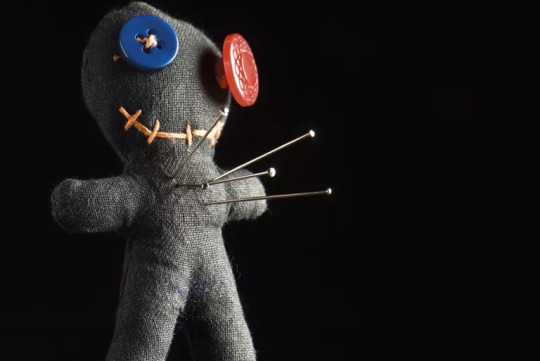
You're the only one who can decide what's ethically acceptable for you. Michelle Constantini/Getty Images
By Patti Wigington
Updated January 05, 2019
The magical poppet is one of the most commonly used implements in sympathetic magic, which follows along on the theory that “like creates like.” Although TV shows and movies typically show poppets as the stereotypical "voodoo doll," poppets have been around for a long time, and used in a number of different cultures and religious belief systems. There are many ways to create a poppet, and they can be used to harm or to heal; if you create a poppet of a person, anything done to the poppet will affect the person it represents. Bear in mind that some magical traditions discourage the use of poppets. If you're not sure whether or not it's okay for you to use poppet magic, you may want to check with someone in your tradition.
A poppet is usually made from cloth or fabric, but you can also make one from clay, wax, wood, or just about any other material. You can fill your poppet with herbs, stones, bits of wood, paper, or anything else that suits your needs. In addition to magical items, it's a good idea to include some cotton or polyfill as stuffing material.
Once the poppet is created, you'll need to connect it to the person it represents, which is typically done by using a magical link of some sort. Remember, the poppet is a useful magical tool, and can be used in a variety of workings. Use it for healing, to banish harmful people from your life, to bring abundance your way — the choices are practically limitless.
Poppet History
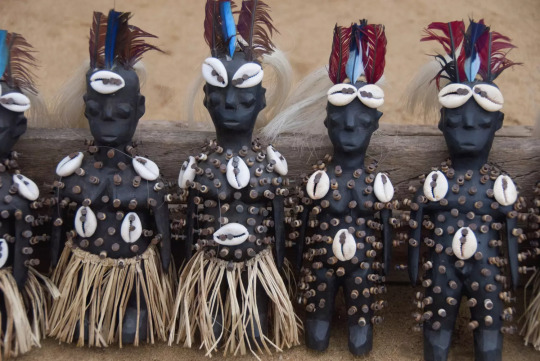
Fetish dolls on sale at a market in Togo. Danita Delimont/Getty Images
When most people think of a poppet, they automatically think of the Voodoo doll, thanks to this item's negative portrayal in movies and on television. However, the use of dolls in sympathetic magic goes back several millennia. Back in the days of ancient Egypt, the enemies of Ramses III (who were numerous, and included some of his harem women and at least one high-ranking official) used wax images of the Pharaoh, to bring about his death. Let's look at some of the historical uses of poppets in spellwork.
Greek Kolossi
It wasn't uncommon for the Greeks to use sympathetic magic in workings related to love or war. Christopher Faraone, Professor of Classical Languages and Literatures at the University of Chicago, is one of the foremost authorities on Greek magic today, and says that Greek poppets called Kolossoi were sometimes used to restrain a ghost or even a dangerous deity, or to bind two lovers together. In Idyll 2, The Witch (Pharmakeutria), written about 200 b.c.e., the tragedian Theocritus refers to melting and burning wax dolls. He relates the tale of Simaetha, rejected by Delphis, attempts to get her lover back with magic.
The Princess Who Played with Dolls
Wax dolls certainly weren't limited to the ancient classical world. The one-time Princess of Wales, Caroline of Brunswick, was married to the man who later became King George IV, and evidently couldn't stand him. She spent many hours forming wax dolls of her husband and jabbing them with pins. Although there's no concrete evidence as to what this may have done to George, when Caroline ran off to Italy with her young lover, George didn't object. The royal couple remained married but lived separately until Caroline’s death in 1821, according to Witchcraft and Evidence in Early Modern England by Malcolm Gaskill.
West African Fetish Magic
West African slaves brought with them a doll called a fetish when they were forced to leave their homes and come to the American colonies. In this case, the doll is not so much representative of an individual, but is in fact possessed by spirits connected to the doll’s owner. A fetish contains significant power and is typically worn or carried by its owner as a talisman. During America's Colonial period, slave owners were allowed to kill any slave found with a fetish in his possession.
American Hoodoo and Folk Magic
In American Hoodoo and folk magic, the use of poppets as a magical tool became popular following the Civil War. There is some dispute as to whether the dolls are used at all in Haiti, which is the home of Vodoun religion, and a few sources disagree on whether the use of poppets is truly a Vodoun practice or not. However, the Voodoo Museum of New Orleans does stock a variety of dolls in their gift shop.
Regardless of how you make your poppet — out of cloth, a chunk of meat, or a glob of wax, remember that poppets have a long tradition behind them, and that tradition is influenced by the magical practices of a wide range of cultures. Treat your poppets well, and they will do the same for you!
Make Your Own Poppet
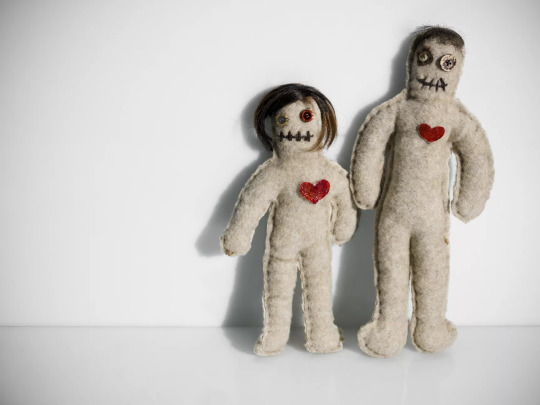
Photomorgana/Getty Images
A poppet can be as simple or as elaborate as you like — it all depends on how much time and effort you want to put into it. You can construct one out of just about any material — cloth, clay, wood, wax. Use your imagination! In some magical traditions, it's believed that the more work you put into it, and the more complex it is, the stronger your link will be to your goal. Because a poppet is a device for sympathetic magic, all of its components will be symbols of what it is you hope to achieve.
You can do your poppet-making as part of the working itself, or it can be made ahead of time so you can use the poppet later on. Which method you choose is really up to you.
Remember, your poppet represents a person, so figure out before you begin who it symbolizes. Is it you? A friend who's asked you for help? An un-named lover you want to bring into your life? A gossip you want to shut up? The possibilities are endless, but just like in any spell working, you'll need to set a goal before you begin. It keeps you from having to deal with "do-overs" later. These instructions are for a basic poppet construction, using fabric. Feel free to modify your design as you need to.
Selecting Your Fabric
There are no real rules when it comes to choosing your material, but it's not a bad idea to select fabric based on your goal. If you're doing a money spell, use a piece of green or gold cloth. If you're looking at healing, perhaps something in a soft blue or silver would be best. Check out fabric stores around the holidays, and you can find all kinds of neat patterns.
Valentine's Day designs are perfect for matters of the heart, and there are plenty of prints with dollar signs, coins, stars and moons, and other fun designs.
Another option is to use fabric that links the poppet to the person it represents. Doing a healing spell for a friend? Ask the person for an old t-shirt. If you're trying to draw love into your life, consider using a scrap from that sexy lingerie you wore last night. If you just can't find the right material, use a plain muslin or white felt. Here are a few ideas for designs and colors for poppet magic.
Animals: Brown or green fabrics, patterns with cats or dogs, anything pet-related
Banishing: Black fabric, designs such as swords or wands, dragons or fire
Creativity: Orange or yellow fabric, prints of suns or other fire symbols
Healing: Silver, white or blue, with designs of clouds or other air symbols
Love: Pink or red material, designs like hearts, roses or other flowers, Cupids
Money: Silver, gold or green fabric, or designs of dollar bills or coins, cups or earthy symbols
Protection: Red or white material, with patterns of shields, keys or locks, fences, mistletoe
When it comes to types of fabric, use what's easiest for you to work with. Cotton prints are easy to sew, but if you've never used a needle and thread before, you might want to try something stiffer like felt — it comes in every color you can imagine, and will hold its shape as you sew. If you're an experienced sewer, use anything you like.
A poppet represents a person, so ideally it should look (sort of) like a person. Give it a head, two arms, two legs, a torso. You can make your own outline or you can use the ultimate poppet pattern — a gingerbread man. If you're doing a spell for an animal — such as a healing spell for a sick pet — make the poppet shape accordingly. Your poppet doesn't have to be huge, but it should be big enough that you can stuff it with your ingredients later.
Take two pieces of your fabric, and place them right side together on a flat surface. Place the pattern on top, pin it in place, and cut it out. Leave a little room around the edges for a seam allowance — usually a 3/8" margin is good. Remove the pattern, and there are your two poppet shapes. Time to start sewing!
If you've never sewn anything by hand before, don't panic. It's not hard, but it does require some patience. You could always use a sewing machine if you're pressed for time, but most experienced poppet-makers agree that it's worth the effort to do it by hand. Pin the two pieces of material with the right sides together, and stitch around the edges. Leave an opening somewhere, wide enough to stick a couple of fingers in. Turn the poppet inside out, and begin stuffing.
Personalize Your Poppet
Fill your poppet with something soft, like polyfill or cotton balls. Old pantyhose work nicely too. Work the stuffing all the way into the nooks and crannies of the arms and legs, and then fill the torso and head.
This is where you'll place your spell components — herbs, stones, whatever. In some magical traditions, something from the person represented goes inside the poppet. This is alternately referred to as a taglock or a magical link — it can be bits of hair, nail clippings, body fluids, a business card, or even a photograph. Once everything is inside, sew the poppet completely shut.
The more you can customize your poppet, the better. Even if you've placed a magical link, or taglock, inside, you'll want to decorate the outside too. Draw or paint or sew a face onto your doll. Add yard or string for hair. Dress your poppet in something that looks like the person's clothing. Copy any tattoos, scars, or distinguishing features onto the poppet as well. Add magical or astrological symbols if you like. While you're doing this, tell the poppet who it represents. You can say something along the lines of, "I have made you, and you are Jane Jones."
Your poppet can be used for any number of things—love, money, protection, healing, to get a job. Anything you can imagine, you can make a poppet to bring it about. Simply figure out your goal and the means to achieve it. The only limits on poppet construction are your own creativity and imagination.
6 Easy Poppet Projects
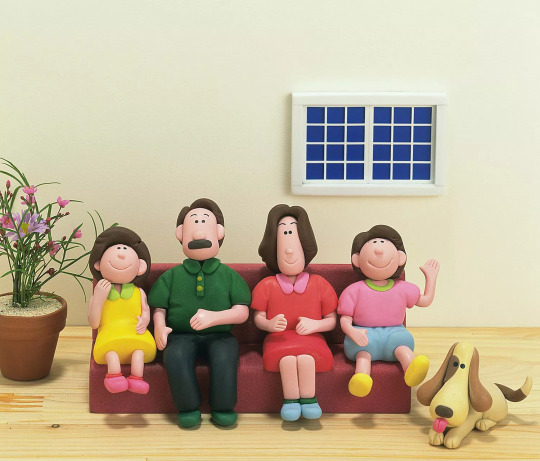
Make protective poppets for each member of your family with modeling clay. amanaimagesRF/Getty Images
Not sure what sort of poppets to create, or how you can use them in a practical application? Try one of these six easy ideas for making and using your own poppets.
1. To Get a Job You've Applied For
Material: satin, green or gold or silver
Herbs: clover, chamomile, ginger, cinnamon
Gemstones: snowflake obsidian or sodalite
Create a poppet to represent yourself. As you make it, focus on the positive attributes that you possess which will make you appealing to a potential employer. Another option is to create the poppet in the image of the employer (include business cards or letterhead inside, if you can get them) and tell the employer poppet why you're the best person for the job.
2. To Protect Your Family
Material: Modeling clay
Herbs: Basil, patchouli, coffee
Gemstones: Hematite, amethyst, black onyx.
Create poppets that represent each member of the family, blending herbs and stones into the clay. Put them in a safe place in your home, such as near your hearth, and utilize magical shielding or cast a circle of protection around them. This is actually a fun project you can get your kids involved in as well — let them each make their own poppet person!
3. To Heal a Sick Person
Material: White cotton or unbleached muslin
Herbs: Lemon balm, feverfew, ivy, and pine.
Gemstones: Bloodstone, turquoise
When you make this poppet, be sure to indicate what you are trying to heal, whether it's a case of tennis elbow, a chronic infection, or even a broken heart. Focus all of your energy on the ailment in question.
4. To Bring Love Into Your Life
Material: Red or pink silk or cotton
Herbs: Rose petals, parsley, and peppermint
Gemstones: Barite, jade, rose quartz
Make a poppet to represent the object of your affection — remember that in some magical traditions it is frowned upon to make a specific person the target of your working. If you are simply trying to attract love to yourself, but you don’t have a specific person in mind, focus on all the desirable qualities you want to see in a potential lover.
5. Silencing a Gossip
Material: Ground beef or other squishy meat
Herbs: Horseradish, pepper, rue, yarrow, valerian
Shape the meat and herbs into a person, and create a "meat puppet" in the same way you'd make a fabric one. As you make the doll, tell it that it's time to be silent, and tell no more gossipy stories. Remind it that people who can't say nice things shouldn't say anything at all. Dispose of the doll by either burning it on your grill and burying it someplace far away, feeding it to your dog, or leaving it out in the sun to rot.
6. Emergency Poppet on the Fly
Material: Aluminum foil
Perhaps something has come up in a hurry, and you feel it needs immediate magical attention. Use a piece of aluminum foil to whip together a quickie poppet — shape it into the figure of a person. Fill with any magical components that might be handy — bits of wood, dirt, grass, even a name scribbled on a piece of paper — and personalize the poppet.
Need additional poppetry ideas? Try making a magical gingerbread poppet, or put together a portable poppets kit to keep in your magical arsenal!
https://www.learnreligions.com/what-are-magical-poppets-4072783
10 notes
·
View notes
Text
Prompto’s Brotherhood Arc is Fatphobic 2, Electric Boogaloo: Haley’s Back and She is Pissed
This essay is going to be an even deeper dive into the fatphobia that permeates Prompto’s character arc, and is going to handle the issue with more grace and nuance than I did the first time. This is also going to explore the effects the arc had on me as a player, and on other players who share my experiences. It is going to be very organized, long, and methodical (word count: ~5300). It’s a bit of a doozy, but it is something I feel it is very important. I have been wanting to elaborate on my previous Prompto essay for a long time, and for reasons I will detail below, I feel that I am ready to do this now.
Consider this a sequel to my earlier essay, and I will be referencing it throughout.
Stand back everyone; Haley’s about to get mean and personal.
Under the cut for safety and length, please avoid if the subject is triggering to you! Take care of yourselves!
Thank you all so, so much for hearing what I have to say.
TW: fatphobia, eating disorders (both in terms of Prompto and of the author)
Intro
All right everyone, buckle in. Last time I think I was a little bit too nice about this. Last time I think I let a little too much go. But I’m a full three years older now and I’ve seen a few more things. And now I think it’s time that I really just let loose and criticize the fuck out of Square for something they have consistently done wrong, and that is the way they have handled issues with weight in regards to one Prompto Argentum.
Many of you may know that Prompto is one of my favorite characters in anything ever. This very sideblog, in fact, used to be named for him (old url was promptoisbi). It’s because of this that I hate that he’s so consistently shit on by the narrative, but right now we are talking about the out-of-universe insidiousness of the fatphobia that completely permeates this story.
The first essay is right here but the TL;DR version of that is essentially “the way that Prompto’s weight loss in Brotherhood is portrayed as a moral and positive good and in fact necessary for him to be a protagonist is immensely fatphobic. Because the game refuses to problematize this, I am going to, and I’m going to contextualize that with my own experiences to help explain why this is so fucked.” At that time, I was recovering from long-term anorexia, and I think that permeated a lot of what I wrote. I don’t regret this, and I still think the essay is pretty solid. But I’m not a woman who won’t admit her own limitations, and one of mine at the time was that a lot of my fatphobia was internalized. Now that I am healing, now that I have talked to other people with experiences that mirror my own (notably @chubbyargentum), I think I am in a better place to articulate what upsets me.
The rest of the essay will be divided into six parts, themed as follows:
A redux of my central criticism in the first essay, that the narrative treats Prompto’s weight loss as a positive, moral good. In fact, it’s necessary for him to be seen as a protagonist.
Detailing that Prompto’s weight loss was directly motivated by another character, and this other character does not apologize to Prompto at all for his previous behavior. We are in fact supposed to believe that him saying what he said was a good thing.
Evidence that Prompto still legitimately has an eating disorder from his trauma. This goes unexamined by the story, and in fact seems to be actively encouraged by other characters, notably Ignis and Noct. This isn’t to bash the characters, but the way they are written.
Points 1 and 3 combined produce a genuinely triggering experience for players like me; this is where I detail some of my own history with weight and eating problems.
Anticipating pushback, I propose two alternative scenarios that avoid the problems outlined in parts 1-4: one where Prompto doesn’t lose weight, and one where he does but it’s handled a lot more sensitively.
A personal look at what (and who) actually motivated me to do a Part 2 to my essay.
Followed by a TL;DR conclusion if you want to jump right to the heart of things. I know this is a long essay, and I don’t apologize, but I do want to make it accessible to those who might have a harder time reading something so long.
Time to knock down these points, one by one:
Part 1: Equating Weight Loss to Morality
Prompto’s episode in Brotherhood, “Dogged Runner,” serves as our introduction both to Prompto as a character, and pulls double-duty to show us how he becomes involved in the life of a prince. Gladio and Ignis’ episodes did not have to do this double work because they are in Noct’s life by occupation, but Prompto, being a commoner, needs this introduction. Unfortunately, this episode is not twice as long to handle the double workload it gave itself, and the plot clearly suffers for it. For those who don’t remember, Prompto seems to be a child who more or less raises himself--a shy boy who is in the same grade as Noctis. He is quite obviously overweight, and the episode in fact chooses to focus the bulk of its attention on that rather than how he met Noctis (this will be explored in Part 2, below). This is what I take issue with.
Due to....an encounter, we’ll call it, with his royal classmate, Prompto becomes motivated to “improve himself to become someone worthy of a prince,” as described in Episode Prompto. Right off the bat, this description is implying that in order to be worthy of Noctis’ companionship--even independently of Noctis’ own actions, which will be problematized in the next section--he must be different than the way he is.
This...doesn’t make sense. We already saw that Prompto was a kind and generous soul, if rather shy. He took in “Tiny” of his own accord; he fixed her up and fed her and made sure she was healthy, solely out of the goodness of his heart. What else could this literal child need to “improve” about himself to make friends with Noctis? Well...the episode focuses on this in a way I would almost argue is objectifying. We see in excruciating detail how this literal child (I feel the need to mention again that Prompto is 12 years old and doesn’t seem to have consistent parents) approaches the world with a black-and-white mentality….that is, he seems to focus exclusively on eating salads and running an excessive amount (we’ll get to this more in Part 3). Further objectification occurs when we are shown repeatedly that a minor is taking “progress shots” of himself in his underwear.
A bit of a tangent, but the way that last one is drawn...y’all did remember Prompto was 14/15 at that time, right? Extra H points for Square, right there.
So yeah, once all of this happens, Prompto is finally deemed by the narrative to be acceptable enough to enter the life of a prince. Basically, if you’re fat, get a goddamn eating disorder and you can be a protagonist!
And I’m actually gonna take a second right now to address the more common, and generous, interpretation/criticism I am anticipating. I know what SE was trying to do here. They were trying to show us that Prompto’s “self-esteem” was the problem. That he needed to gain more confidence, and losing the weight didn’t actually solve that problem. I know this is the intent because the hotel scene exists. But...answer me this. Why is losing weight treated as an analogue for Prompto’s internal character growth? Why is losing weight an analogue for literally anything? If the issue was Prompto’s insecurity and shyness, there are a dozen other ways to show that. I can think of one right now: maybe have Noctis try to make friends and Prompto runs away because he gets nervous and tongue-tied and that’s the source of their lingering awkwardness. There you go, much better episode.
Part 2: Noctis is a dick
And I say this as a Noct stan. Y’all know I love him. With all my heart, I do. But...I don’t think he starts the game as a good person, in this respect at least. I do think he becomes one. And I think that his growth and maturation over the course of the game is absolutely a treat to watch.
I’m gonna immediately qualify this by saying I do not think Noct is a dick on purpose. Noctis is, in fact, unfailingly kind in most situations and this is one of his greater strengths. I just think he is just as much a victim of internalized fatphobia as Prompto is, despite not having the experience of being fat. I think two things contribute to this: biases that went unchecked by any of his caretakers, and genuine social difficulty brought about by his upbringing.
But now it’s time to get to….the incident. The reason these two know each other. After Prompto takes care of Pryna, she runs to deliver her letter to Noctis and eventually returns to Luna, as was her original mission. Luna, noticing Prompto’s name on a bandana tied around Pryna’s leg, tasks Gentiana to help her find this kind soul so she can thank him. Luna does, and Prompto receives a letter that soon becomes his prized possession. The princess operated on the assumption that Prompto and Noctis were friends, seeing as Prompto encountered Pryna, and asked that he remain “ever at [Noctis’] side.” Prompto takes these words to heart, and resolves to introduce himself to his royal classmate.
Here’s where the problems begin. We know that Prompto is shy because we have seen him before. He kinda kept to himself, away from the other kids, content to take his pictures. To Square’s credit, I was really expecting Prompto to be a target of bullying because of his weight and he wasn’t….yet. This actually makes his interaction with Noctis a lot worse, however. We all know what happens next: Prompto does try to introduce himself to the loner prince (who, by his own admission later, was also kinda shy), and he happens to trip. Noct goes to help him out because he’s kind at heart, and a confused Prompto thinks that Noctis means that he wants to see the camera. Noct is baffled and says something along the lines of “I meant you, dummy!” and goes to help Prompto up.
Honestly, end the scene here. They become friends because Noct is unexpectedly kind to someone he didn’t even know, and that sticks with Prompto, and they’re childhood best friends. Right? RIGHT?
If Square had had a modicum of decency, yes, this would have been how the scene closed. But then Noct had to open his fucking mouth. When trying to help Prompto up, he remarks that the poor boy is “heavy,” something that quickly and immediately impacts Prompto. Noct, also being 12, seems none the wiser and jovially heads off to meet Ignis. But Prompto? Prompto is….affected by this. He decides then and there that he has to not be heavy anymore if he wants to be Noct’s friend.
“But Haley!” I can hear y’all saying, “Isn’t it Prompto’s fault for internalizing a harmless comment in such a way? Why are you so angry at Noct because Prompto took it too seriously?” Or alternatively “Noctis was also a child, he didn’t mean it!!”
Well, it’s all about how the narrative treats the situation. I mentioned this before in Part 1, but the reason I’m mad at both Noctis and Square is because the narrative treats him as though he is in the right at all times. If the issue really was with Prompto as a character, then we wouldn’t have been shown his journey in such excruciating detail. We wouldn’t have been subjected to the downright harmful avenues he goes down in pursuit of this goal (see Part 3 for elaboration). We would have just seen Prompto trying to work on becoming more outgoing--maybe talking to his neighbors more often, for example.
One small scene in particular gets me here: we do see Noct return to the place where they met and he seems to be baffled by the fact that Prompto will not talk to him. We in fact know this to be the case because in the hotel scene, Noct explicitly says Prompto “should have said something sooner” in terms of starting their friendship. Now, this pisses me off for two reasons:
That this wasn’t addressed in Brotherhood itself. We see that Noct kinda wants to approach Prom again but doesn’t seem to know how. If we are assuming he messed up on accident, this would have been a great time for Ignis to tell him so, maybe motivate Noct to apologize.
That Prompto doesn’t immediately call Noct out for this line, or say something along the lines of “Well you kinda straight up insulted me when we first met.”
So, because neither of these scenarios is the case, I have to assume that Square wants us to think that Noct was correct to insult Prompto, and that him losing the weight is a good thing, in a narrative sense.
Finally, it’s straight up out-of-character for Noct to be this way. Not the misspeaking part, that is perfectly in-character. It’s the fact that this bias of his goes unchecked by Ignis or Gladio, and he is never made to apologize for hurting another person’s feelings. Part of growing up is realizing that sometimes your actions can hurt other people, even if you don’t intend for them to. The fact that the intent wasn’t there doesn’t mean the hurt wasn’t real. Since Square is so convinced that Noct needed to “mature” in this story...I am immensely disappointed that the opportunity wasn’t taken here for him to learn. And even more disappointed because I am pretty sure this is intentional. Every single one of Square’s fat characters is used as a side character or comic relief. In order for Prompto to be a protagonist, he had to lose weight, and to have Noctis--the central protagonist--be the character to directly motivate that is a slap in the face.
Part 3: Don’t Recover, Buddy!/ It’s actually good that you have “obesophobia”
So I know I put the trigger warning at the top of this, but I’m doing it again, because now I’m gonna talk about eating disorders. So this is your last chance to back out if that stuff is legitimately triggering, which I understand.
I’m gonna say it right now: Prompto has anorexia
[several people are typing…. .jpg]
I don’t think this is subtle, and I do think this is intentional, so let me break it down. Prompto exhibits a lot of the symptoms, and yes I am speaking from personal experience. He’s exhibited all of these from the moment Noct made that comment when they were kids, and, notably, only from that point on (hence why I wrote Part 2 the way that I did):
Prompto has an obsession with fixing meals. He’ll be the one that helps Ignis the most often. In Prompto’s case, this is a sign that he loves preparing the food, not so much partaking: classic hiding of symptoms. There is also the fact that most of the salads are his favorite meals, which yes, is a deliberate callback, but I don’t think it’s a good one.
Prompto runs a genuinely stupid amount. I think that exercise is well and good--I’m something of an exercise buff myself--but it’s the way that Prompto does it, to the point of exhaustion, that is a problem.
Despite being borderline underweight, Prompto legitimately still seems to think that he is still fat. This is supported by his reactions to multiple dialogues, which I’ll get to in a second, and the “obesophobia” thing on his character profile which….yeah I shouldn’t even have to explain that one. Prompto is legitimately afraid that he will gain weight--specifically, that he will be fat again.
The fact that according to that same profile, Prompto’s photography habit started when he took progress photos of himself!! So he’s also got some legit body dysmorphia going on.
These are the ones that are most obvious to me, anyway.
“Now okay, Haley,” y’all are furiously typing, “so what that Prompto has anorexia? That’s a relatable character flaw!”
Well….one, no it isn’t. A disorder of any kind is not a character flaw. I’d be willing to let that slide if the following were not also true: other characters seem to reinforce these behaviors of Prompto’s, and I am looking directly at Ignis and Noct. Let’s start with Ignis. I’m sure we have all gotten the random dialogue of
Prompto: All right, let’s hit up the Crow’s Nest! Ignis, for no fucking reason: If you wish to put on weight? Certainly. Prompto, defeated: Yeah, I know…
Every time I get this dialogue I want to yell and also want the option to kick Ignis out of the party. Also the fact that no one steps up on Prompto’s behalf (notably, you know, his goddamn best friend!!) is a bit of an Issue too. Another one involves Ignis, but I have only gotten it once, so I can’t remember it exactly, but Ignis says something to the effect that he can make “whatever [Prompto] wants” for dinner and Prompto says “Yeah, it’s the wanting that’s the problem.” That’s...that’s horrifying and y’all should be concerned for your friend.
To turn my attention back to Noct, objectively the most important person to Prompto, we need go no further than “Why is your face so fat?” in selfies.
This one legitimately made me mad. Prompto panics and retaliates with “What?? I’m not fat!!” (notably, he said “I” and not “my face,” which is a bit of a slip), and Noctis is supposed to be his best friend. I was somewhat okay with Noct being passive in the earlier incidents, because maybe he wanted to spare Prompto the group drama that would ensue, but Noct directly engaging in it actively pissed me off. I also want to say this isn’t me bashing on the characters in the slightest, I am simply calling attention to the way they are written. Because they are not called out by anyone else, because this behavior is treated as acceptable, I have to assume the narrative wants me to agree with them.
The only conclusion I can gather from this is that not only are the bros aware of Prompto’s disorder, but they actively encourage it. Which would only further Prompto’s assumption that they only will love and accept him if he looks a certain way. No wonder the poor kid was so freaked out about his barcode!
Part 4: This shit is triggering to players
The subtitle for this section should be “Haley talks about how deeply “Dogged Runner” affected her in a PTSD kind of way” because that’s what I’m going to be doing. Second trigger warning for eating disorders and weight talk, because that’s what this is gonna be. This also is not going to be nice. I have strong language for Square:
Here’s where I come clean about why this issue matters so fucking much to me, and why I am now freely and openly saying “fuck you” to Square every chance I get. When I first saw Brotherhood, I was at a stage in my life where I was not coping well with my body image. I had my first brush with anorexia in high school, but it was coming back because I was in a new place, and I felt like that was the only thing in my life that I could control. So I had been eating less and falling back into the habit, except...this time I had my support system. So I thought. I went into the anime wanting to learn more about the characters I had come to love, and I walked out of it thoroughly triggered and horrified that Square would stoop to such shoddy, lazy, and harmful storytelling.
I had...a moment, here. I won’t detail the breakdown too much but I was genuinely not okay. To see behaviors that I had ferociously clawed my way out of, and was violently resisting once more, portrayed not only as not unhealthy, but as desirable for people like me...it genuinely felt personal. And, I imagine I wasn’t the only player who felt that way. In fact, because I have talked to other people like me, I know this is the case.
Let me take you on a trip, for a moment. Humor me. Imagine you’re in your early 20s, and you’ve put a lot of ugly, horrible coping methods behind you. Imagine your best friend in the entire world, @nonbinary-recipehs, recommends this game they are playing, and you play it together and start to consume its media. Imagine the horror and dread that settles on the both of you watching this episode, which rings so similarly to the times you passed out from lack of food, from over-exercising, from over-straining yourself to be this idealized version of thinness. Imagine seeing that the outcome of this episode isn’t Prompto getting the support he needs from his friends, but that the narrative legitimizes his suffering. In fact, this brutal suffering and rapid loss of weight was necessary to justify this character’s relevance to the narrative! Imagine how that must make you feel. Maybe those coping methods that were so horrible actually weren’t. It worked for Prompto, maybe it’ll work for you!!
Perhaps that little thought experiment will help you understand what this whole situation can feel like to players like me, to people who have struggled with internalized fatphobia and with eating disorders, who have been called heavy, who have been made to feel as though their worth is in their thinness. Fuck you, Square. Fuck you for not having an ounce of consideration for how this might possibly look. Fuck you for not considering people like me as complete people. Fuck you for making me watch a character I love suffer, not to tragedy, but to an illness that could have been avoided if anyone had shown him even an ounce of respect or care or decency or decorum--
…
I did warn y’all I was angry, this time.
Part 5: Two Alternative Scenarios that would Avoid All This
“So Haley,” you’re saying, somehow having read past the rant in the previous section, “if Square did it so horribly, how would you have done it?”
That, my dear reader, is an excellent question. In fact, I’ve got two solutions, which I will explain and elaborate upon below:
The first is rather simple: Prompto doesn’t actually lose the weight and becomes a canonical fat character. Absolutely nothing else would change about the story or Prompto’s character except for the following:
Noctis would become curious as to why this new friend of his was avoiding him. He then has the opportunity to open up to Ignis or Gladio and reflect on what he said, and realize that he actually hurt Prompto’s feelings. This motivates him to apologize, and the two become Actual Childhood Friends.
Prompto just Has This Body Type Now and nobody says dick about it, that’s just the Way He Looks
You could explore internalized fatphobia I suppose but I don’t actually trust Square to do this sensitively. You know who I do trust? Liam ( @chubbyargentum ), who writes the Nighttime Sunshine AU and fic.
All of the previously mentioned fatphobic comments are completely removed because all the bros love and support him.
Prompto isn’t the comic relief because of his size, he just happens to be both. Yes, there is a difference, and no, I am not going to derail the essay by explaining that.
Prompto would still absolutely kick ass, take names, shoot people, love chocobos...all the shit he does in canon. But now, you have a character who didn’t have to be completely humiliated to get to this point. Now you just...have a guy who happens to be friends with the prince, because he is kind and caring.
But okay, let’s take another approach. Let’s say Prompto does still lose weight. How, then, do we accomplish this without being fatphobic or debasing Prompto’s character like canon did?
That leads me to solution 2: Prompto does lose weight, but it’s incidental. Let me explain what I mean here:
Let’s have a situation in which the apology does still happen as I outlined in the first solution. Childhood friends is a thing.
As such, Prompto becomes...increasingly curious at all the cool training Noct does.
Noct is….embarrassed about this, I think. Because Prompto doesn’t like Understand What It All Means...and they’re still pretty young. Noct doesn’t want him to understand.
But Prompto? He wants to be able to Do Cool Shit, especially if it means defending his best bro who also happens to be the prince. And he doesn’t want Noct to do any of this alone. He asks to train with Noct, no special treatment (except for like the fact that he legit can’t do magic).
Gladio...allows this, begrudgingly. Then, permanently, when he notices Noct tries harder as a result of showing off.
Prompto starts to learn how to take care of himself from Gladio, and from Ignis, who has...gathered that Prompto doesn’t exactly have parents, and becomes invested in helping him learn how to cook healthy meals for himself. Who knows? Maybe the healthy eating will rub off on Noct!
The result is that, over time, Prompto does lose some weight...and starts to bulk up as Puberty Happens. However. This is all incidental. Prompto never set out to lose weight because he hated himself or felt unworthy, like in canon. He set out to become strong and train with his best bro. This is absolutely critical.
With this solution, Prompto does lose weight, but doesn’t become the borderline underweight young man with an eating disorder we all know and love. Instead, he’s been brought up around healthier traditions, which makes him immensely more suited for the role of Crownsguard when that time comes. In fact, he might have entered it at age 18 just like Gladio and Ignis did, despite Noct’s protests. Another thing I like about this solution is that it shows how Prompto is friends with Ignis and Gladio; how those relationships developed independently of Noctis, and why these four really are the family unit the game wants me to think they are.
And with these two solutions, I believe I have laid out some much stronger backstories for our beloved boy that avoid all of the...unfortunate implications of his canon backstory. I only wish that Square had thought about their implications just a little bit more, and done Prompto some true justice.
Part 6: What motivated this essay, and the power of shared experience
This isn’t really a proper conclusion, that’ll be in TL;DR, but I would be remiss to not include what actually motivated me to write this massive essay, and also share it with all of you. The sharing part, I think, is super critical. When you inhabit marginalized identities, and in this case I specifically mean having a fat body, it can be...difficult to share and discuss your experiences. Harder, still, to be public about them, and to criticize media that perpetuates these harmful ideas. But here I am, doing that. Here’s why that is.
About a month ago, I met @chubbyargentum, who is called Liam. I was cruising through the promptis tag, as you do, and found his Nighttime Sunshine AU, and his blog is filled with excellent art for it as well. The premise of this AU, on its face, is very simple: it’s a story where Prompto and Noctis did not actually become friends in high school, and two very important things are different: Prompto is still fat, and Noctis is a closeted trans man. While I can’t speak to the trans experience, I can indeed speak to the experience of inhabiting a fat body. And this AU….spoke to me. I don’t want to spoil too much but there is a rather emotional scene that just...confronts everything I wanted Square to confront about this that they never did. He approaches the topic with so much sensitivity and nuance, something that is so rarely seen in fandom.
I’ve talked with Liam every day since, and my brain has consistently been enlarged. A lot of things I let slide before...felt so egregious to me that I had to say them. I’ve been confronting my own internalized prejudices towards certain kinds of bodies all the time, and I am learning every day. He’s become a very dear friend of mine, and I care deeply about him.
This also came at I guess you could say the “first climax” of my journey with weight loss, which I had never had success with despite the trauma I described in Part 4. I’ve lost...a significant amount of weight since March, and I think the reason I’ve had so much success is 1) the support of my friends (notably @nonbinary-recipehs, @pocket-prompto, and @chubbyargentum), and 2) not feeling like I hated myself anymore. I approached it as a journey to become more strong, not less fat. As I outlined in Part 4...Prompto’s Brotherhood episode and character backstory were and are legitimately triggering to me, and, I imagine, to many others. Liam had the confidence to put the content in the world that he wished to see, and this essay is helping me do the same.
Having other people who share your marginalized experiences and validate them...well, I’m sure many of you know. It’s a feeling like no other. And I’ve never really had this feeling explicitly about the experience of being fat until now. Now, I understand that my anger is in fact, righteous. And I am not afraid to say so. The power of shared experience motivated this essay and, in fact, everything that I do on this blog. I have come away from this AU with the bravery to say aloud what I have always known to be true.
So thank you, Liam. Thank you, big brain group. And thank you, readers, for listening to an experience that may or may not mirror your own, and for opening up your heart enough to hear the roughly 5000 words before this point. Thank you for making the effort to understand, and the effort to learn and grow.
TL;DR
I did promise to provide an easily digestible version of the…(checks word count) ~5000 words before this point, so here we go. The central thesis of this essay is something like “the way Prompto’s weight loss arc was portrayed in Brotherhood is horrendously fatphobic for a number of reasons.” I then broke it down into six major pieces: the first four being the fact that weight loss is treated as moral by the narrative, the uncharacteristically dickish actions of Noctis, the fact that Prompto’s disorder is encouraged by other characters, and the out-of-universe triggering effects the story has. In the fifth piece, I outlined two alternative scenarios: one where Prompto doesn’t lose weight at all and remains fat, and one where he does lose weight but healthily so and fleshes out his character. In the final piece, I explained the motivation behind writing this essay, namely interacting with other fat fans like @chubbyargentum. I explained all of these points in great detail, being careful to stress that my issue with this isn’t any of the individual characters, but the bias that motivates the writing.
So...what now? Well, I’m not really sure. But this was something I really had to put into the world. I think it is important and necessary to speak up and criticize media that harms you. And you know what? Final Fantasy XV is still my favorite game. It is because I love it so much that I was motivated to write this, and by sharing it, I hope to contribute to a greater discussion about fatphobia in gaming, and in life.
#final fantasy xv#ffxv#tw fatphobia#tw eating disorders#prompto argentum#please be respectful with this one#i feel like this is an unpopular opinion#but it is incredibly necessary that i say this#because it is something i believe#and because I don't want square to continue to get away with it#thank you for read#haley.exe#haley writes ffxv#haley has opinions#i'm preparing for so much hate
63 notes
·
View notes
Text
Fear Street Part 3: 1666 Ending Explained
https://ift.tt/3etXAqp
This article contains Fear Street Part Three: 1666 spoilers.
It never could be as simple as reuniting an ancient skeleton’s hand with its wrist, right? That became obvious last week when the Fear Street trilogy’s ostensible heroine Deena Johnson (Kiana Madeira) attempted to break the curse of Sarah Fier by attaching all missing appendages in the alleged witch’s grave… only to be warped to Shadyside’s early days in 1666.
Now in Fear Street Part Three: 1666, we’ve learned the full unholy breadth of Shadyside’s curse, as well as their sister township Sunnyvale’s good fortune—and it’s dark. Involving a perversion of all that is good(e), the curse that has taken so many beloved characters over the centuries turned out to be more twisted than perhaps anyone expected… but not for Sarah Fier, a victim of superstition and misogynistic zealotry. And in the end, Sarah got the last blood-curdling laugh. Here’s how.
Goode Men, Wicked Slaves
For all those who became suspicious last week of the recurring Goode family, your paranoia has been vindicated: that cop really is the Devil. Or at least he’s in service of the Dark One.
By traveling to 1666, Deena was able to walk around in Sarah Fier’s shoes and get a taste firsthand of what it’s like to be wrongfully accused of witchcraft by a Puritanical community (even if she inaccurately later describes them to be Pilgrims). As it turns out, Sarah was not a witch; she was merely the young woman who’s secret love for Hannah Miller (Olivia Scott Welch) caused a spurned suitor named Solomon Goode (Ashley Zukerman) to take umbrage. And as it so happens, Solomon was the one actually dabbling in the dark arts….
Aye, it was Solomon Goode who spilled his blood on Satan’s stone, beginning the process of offering “one name” and soul for demonic corruption in turn for good fortune for the Family Goode. When Sarah rejects his offer to join his unholy bargain with Black Phillip—and more vexingly takes offense over his severing her hand—Goode accuses Sarah for the black magic that’s bewitched Shadyside: the curse which caused a murderous minister to blind children!
Sarah hangs, but not before offering a curse of her own: She will get back at Goode one day and reverse his damnable curse. In the meantime—and at a cost of more than 300 years of functional blood sacrifices—Goode and his family profit from their deal with Old Nick. From father to son, the mainline of the Goode family tree teaches the dark ways to each successive generation, who every decade or so offers a new name and a new soul. The person selected for damnation then goes on a killing spree, spilling blood that the Devil apparently feeds on. Beelzebub in turn grants the Goode family and their Sunnyvale town ongoing prosperity. Hence why by 1994, Nick Goode (also Zukerman) is a corrupt police sheriff and his brother Matthew Goode is the mayor of Sunnyvale.
Meanwhile, Shadyside persists in squalor until….
Magic Blood?
The most satisfying twist of Fear Street Part Three is that halfway through, it becomes Fear Street: 1994 Part 2! To be honest the accents in the 1666 portion of the film were a little dicey, as was the, uh, lack of Puritanism in a film set amongst Puritans. So best to go back to the era of flannel and overalls!
When Deena returns to the ‘90s, she realizes that Sheriff Goode has offered the soul of her girlfriend Sam Fraser (also Welch) to the Devil so she’d kill Deena and keep the secrets of Sarah Fier’s shallow grave buried. And since they have Sam locked up at Ziggy’s house, that means all the Goode family’s damned minions are soon going to be after them. But our heroes come up with a pretty nifty plan.
Thanks to how they saw Shadyside’s collection of nightmares pursue Sam in Fear Street Part 1, Deena and her brother Josh (Benjamin Flores Jr.) deduce that the ghouls will be strictly after Deena’s blood—which low-key makes me wonder how the monsters have such genetic precision to distinguish Deena’s DNA from that of her brother’s. In any event, they team up with adult Ziggy (Gillian Jacobs) and Martin (Darrell Britt-Gibson) by offering the movie-stealing line of the night:
Josh: Wanna help us kill Sheriff Goode?
Martin: Let me get my coat.
The plan for getting it done is also initially pretty solid. They sneak into the Shadyside mall after hours—which just so happens to be built on the site of the Camp Nightwing massacre, which in turn is above where the Goode family’s Satan’s stone is buried beneath the earth—and have Deena cut her hand, dripping blood into a bucket. Then by combining that blood with green paint, they’re able to create cursed blood trails throughout the mall, with each trail leading into a different department store. When four of Deena’s pursuant boogeymen show up, our Scooby gang locks the monsters into their department stores and waits for Sheriff Goode to arrive and inspect the remains of his handiwork. Instead of mangled bodies, he finds his teenage crush Ziggy, now ready to dump blood on his head like Carrie references never went out of style.
It’s an elaborate plan which was built on the idea of unleashing all the ghouls intended to kill Deena on their own master. However, it might’ve just been simpler to shoot him. Oh well.
This final flourish of course goes horribly wrong but at least we get the fun sequence where the hapless heroes figure out they can delay the monsters by spraying each in Deena’s green blood, allowing for proxy fights between pseudo-Jason Voorhees and pseudo-Ghostface.
All Goode Things Come to an End
The actual resolution to this centuries-long terror turns out to be pretty simple. Deena follows Goode beneath the mall and to the Satan’s stone, as well as the literal unholy beating heart of the Goode family’s power. While she fails at stabbing the much bigger evil copper, she at least succeeds at running a knife through his power’s beating heart. It’s apparently as easy as that to undo the curse. It also allows the vengeful spirit of Sarah Fier to return from the dead and finally stab a Goode boy in the eye, sending him to Hell and Shadyside’s curse with him.
The plot’s mechanics are simple, but the implications are much more interesting. Because who else follows Nick and Deena toward the mouth of Hell but Sam, still possessed and now conveniently free of her restraints. She also attempts to thwart Deena and nearly kills her, yet Deena is able to make simple eye contact with her one great love and break through, shattering Satan’s grip.
It’s intriguing since, technically, we’ve seen Goode’s curse divide lovers before, with Tommy Slater (McCabe Slye) in Fear Street Part Two: 1978 not even hesitating to swing his axe into girlfriend Cindy’s heart. But then Deena and Sam’s love is strongly hinted at as being of a greater emotional purity. After all, Sam is clearly a descendant of Hannah Miller, the young woman whom Sarah Fier loved and saved from the noose by insisting that she alone was the witch of Shadyside, even bewitching poor Hannah into impure thoughts.
Are Deena and Sam the reincarnations of Sarah and Hannah? It’s possible, if even on a spiritual level since Sarah doesn’t appear to have any direct descendants. In any case, unlike so many slasher movies released between the 1970s and ‘90s, a lesbian romance is prominently featured at the center of this story, and is even the one redemptive light in Shadyside’s darkness.
Read more
Movies
The Netflix Fear Street Part 2: 1978 Easter Egg You Might Not Have Spotted
By Rosie Fletcher
Movies
Fear Street Part Two: 1978 Breaks Friday the 13th’s Darkest Rule
By David Crow
It also makes a striking juxtaposition next to Nick Goode’s dead body. This man might have been the current beneficiary of his ancestor’s bargain, but he represents something grimmer: the predatory nature of a society’s affluent feeding off the suffering and annual tragedies of their community’s underclasses. Sunnyvale flourished as a home for the wealthy while Shadyside wallowed in blood and trauma.
Kind of cuts deep the longer you think about it.
So… Who Took the Spell Book?
Of course this wouldn’t be an old school horror movie if it didn’t set up a sequel. Fear Street Part Three definitely offers resolution for its current narrative: Nick Goode is dead and exposed in the press as the Sunnyvale serial killer; Josh, meanwhile, may yet have his first girlfriend; and Deena and Sam are together, honoring Sarah Fier, if no one else will.
But beneath the reopened Shadyside Mall, we glimpse the book of black magic that Solomon Goode first used to make his pact, and a pair of hands belonging to an unseen face snatch it. Who stole the book and what are they up to?
Well, it’s worth noting that the Goode family has grown quite a bit in the 300-plus years since Solomon Goode accused Sarah Fier of witchery. Nick Goode appears to be the eldest son in the direct line. He’s the one taught the spells onscreen, and the boy who reads out Thomas Slater’s name—ironically in a bid to wrestle him away from Ziggy. However, just because Nick Goode is the one who damned Tommy and Ryan Torres in the last two Fear Street movies, it does not mean he was working alone.
Despite what Mayor Goode told the press about his brother, he almost certainly knew about his father and forefathers’ good work, as would the rest of the extended family. And here’s the thing…it will be so much harder next time for Deena (or, say, a new generation of millennial Shadysiders in the 2000s) to fight city hall. There’s also the likelihood that there’s more than one curse in that book of spells.
The Fear Street trilogy is over. The Fear Street shared universe may have only just begun.
cnx.cmd.push(function() { cnx({ playerId: "106e33c0-3911-473c-b599-b1426db57530", }).render("0270c398a82f44f49c23c16122516796"); });
The post Fear Street Part 3: 1666 Ending Explained appeared first on Den of Geek.
from Den of Geek https://ift.tt/3wMeGX0
1 note
·
View note
Text
Riverdale 5x06 Thoughts.
So I did a part one of a review when the episode first aired focusing on the Barchie elements of the episode and I said I was going to post a second half to the review covering the rest of the episode the next and well I didn’t. Truth is my mental health has taken a bit of a dip, lets say, the last couple of weeks so I wasn’t as active on here. I’m still not feeling 100% so I’m not really up to a whole ass review but I figured I could manage some general thoughts to share with you whilst waiting for the next episode as I can’t watch until tomorrow. Obviously there are spoilers and as always these are just my own opinions.
1) Jughead, Tabitha and The Mothmen.
I am still loving the dynamic between Tabitha and Jughead and I love that she is being supportive of his writing. Like when she said to him that as the diner was empty he could work on his writing, how she tracked down Old Man Dreyfuss and talked him into telling Jug about the Mothmen, She let him interview her for the book too. I said before that one of my issues with Jughead was that he often used other peoples stories for his novels without their permission but he seems to have learnt from this as here he is getting permission from the people that he is talking to and they know that he is going to be writing a book about them. I think its ok for Jughead to draw inspiration from others stories so long as he those he is writing about are in the know and are ok with it.
Another thing that I am really happy about but which might be an unpopular opinion to some but I am so glad they didn’t go the same route they did as Lucas in OTH where Jughead can finally write again because he’s around Betty. As much as I loved Leyton in OTH I did think that was a very unhealthy representation/ aspect of a relationship. A person should have to depend on another person to be able to do the thing they love. Like I get that it’s suppose to be romantic but its a bit too co-dependant in my opinion and don’t think that’s healthy, you should be able to be your own person, with your own talents and skills that aren’t going to be taken away from you just because you are no longer with that other person. What I do love is that it was coming back to Pop’s, to his roots essentially and writing about something that means something to him (Pop Tate) that helps him get back into writing as oppose to a love interest.
Speaking of love interests though I do think that Jughead and Tabitha’s relationship will likely develop into a romantic relationship. To me I did get very flirty vibes coming from her. He also seemed very impressed with her when he found out she left a six figure job to take over Pop’s I think Jughead appreciates the passion that Tabitha clearly has for the business which we know that Jughead himself has a special bond with Pop’s so I think that gives them a bit of a connection that they both love this diner. I do hope though that if they do take it to the romantic level that they take their time with it and not rush into it too quickly. I also hope we don’t end up in the same pattern as before either where Jug is only interacting with his love interest. So far Jug hasn’t really had many other scenes with characters other than Tabitha so I am hoping we will see him interacting with others soon.
As far as the Mothmen mystery goes I am actually intrigued by it. It is really bizarre that all of Dreyfuss’ friends died from cancer and how he was talking about how his friend would be taken up on the ship. I am curious if they are actually going to go the whole alien route and introduce supernatural elements into the show or whether it’ll turn out to have a wacky human explanation. But so far I am enjoying that mystery.
2) Veronica and Chad.
Ok this really is probably an unpopular opinion and I do want to just say that I am not hating on Veronica here I do still love her as a character but there are some things she does that I just don’t understand/agree with. Like this whole jewellery shop idea. I mean the main plot of the time jump so far has been about how Riverdale is dying and how nobody in Riverdale has any money, that they are all poor and suffering and Veronica gets the wonderful idea of opening a high end jewellery store. Who exactly does she think is going to be buying this high end jewellery exactly? The residents of Riverdale very obviously can’t afford to shop there. So the only other place she could get patrons from is SoDale who we know are rich and are near enough to give her a steady stream of business. Here’s my issue with that, it would once again mean that Veronica is saying she doesn’t support her Father’s schemes whilst also profiting/ benefitting from them. I do think this issue is covered a bit in this episode when she says she needs to decide if she’s more of a Pop’s girl or a Mia’s girl, or a bit of both. Well I can tell you right now the answer to that at this moment in time is a bit of both. Veronica has always had one foot on either side of the fence when it comes to her Father’s schemes and the family business. To be honest this has always bothered me a bit and I do hope one day she just picks a side instead of balancing between the two. I mean I could be totally wrong and the writers could have Veronica reveal an elaborate business plans for the jewellery shop that is going to bring in a ridiculous amount of revenue for Riverdale without including SoDale, I mean I don’t know much about how business works.
I did feel like Veronica was a little bit all over the place this episode and to be honest pretty much all post time jump episodes so far. I do want to make it clear that this isn’t a criticism I do think this was intentional by the writers to show how confused and undecisive Veronica is feeling at the moment. I mean she clearly wasn’t happy when Chad first showed up in her class, which by the way was so inappropriate. Like I understand how it might be sweet to surprise your wife at work with flowers and cupcakes but wait in the staff room until she goes on break and surprise her there not when she’s trying to work. It was very obvious that Veronica did not feel comfortable with him sitting at the back of her class. Especially as we see him there again later in the episode so this seems to be a recurring thing. It’s very worrying behaviour. However she is then very warm with him and is making plans with him after they sing Shallow together. You know this scene was lowkey really cute until you remember that Chad is controlling and possessive and then I was kind of mad at myself for being tricked even for only a blip into thinking he was a sweet guy. He and Veronica actually seemed to have it together for a moment there were they had worked out a plan for when they were going to spend time in Riverdale and when they would be in New York and they both seemed happy with the compromise. However Veronica then found out that Chad had spoken to her Dad and was upset by this. Now I’ll be honest this part annoyed me a little. Not because I don’t think she was right to ask for space, I think she was 100% correct in asking for that if space is what she felt like she needed I just don’t think it was that well written. It was painted like Chad had betrayed Veronica and talked to her Dad behind her back when it seemed to me more like it was Hiram going behind Veronica’s back and approaching her husband with the job offer. I mean if Chad was intentionally talking and making plans behind V’s back with Hiram then I don’t think he would have mentioned it so casually to her. I wouldn’t be surprised at all to find out that Hiram either approached Chad because he wanted to control Chad or he was aware that finding out he had been talking to Hiram would upset and Veronica and so Hiram did it deliberately to drive a wedge between Veronica and Chad. I do wish we could have actually seen the conversation between Chad and Hiram I don’t know that scene just seemed a bit off to me it didn’t seem as dramatic as it was probably intended to be. I just didn’t get the sense that on that occasion Chad had really done anything wrong. I mean her Dad offered him a job and then he brought up in conversation with her to see if it was something she would be ok with/ get her thoughts on. To me it seemed much more like Hiram was the one being sneaky as oppose to Chad. Also more of a side point here but I do find it ironic that las episode she was practically begging her Dad to talk to her husband and this episode it’s the fact the her Dad spoke to her husband that makes her decide to send him away again, I just found that kind of funny though I know they are very different situations but still. But like I said I do completely support Veronica’s decision to say that she needs space from him so that she can figure out what she wants and who she is without the pressure of him hanging over her shoulder. Sometimes the best thing for a relationship is some space. I just hope that she maintains a steady conversation with him during this time if her marriage is still something she wants. I mean she didn’t technically break up with him, or at least it didn’t seem that way. She hasn’t ended their marriage. If its a case of she knows she doesn’t want to make the marriage work then I think she does need to end it completely and be clear that its over as at the moment it does seem a bit like they are in limbo.
Also again this is another thing where I am in complete support of Veronica deciding she wants to change her name back to her maiden name but I again think it kind of came out of nowhere. Like I understood her not being happy about where her relationship was at and that she was confused and trying to figure out what she wanted and so needed some space from her husband but she hadn’t really made any indication that she wanted to change her name back before then. I again I just think it could have been slightly better written. Like even something as little as her having a conversation with a friend about how she wasn’t sure she liked being called Gekko. Instead it just seemed a bit random. Also again she didn’t have a conversation about this with Chad her husband. Now I’m not saying she needed permission from Chad to change her name back but I do think it is something that warrants a conversation with them even if its a ‘I’m changing my name back to my maiden name and this is why.’ It’s not about a woman asking a man for the right to do something its about a married couple having open and honest communication between them and that is something that Chad and Veronica very clearly struggle with. Again just to reiterate I am in full support of Veronica changing her name if she wants I just feel like whilst the writing this season has been heaps better I still think they are struggling to write Veronica’s storylines well. It doesn’t help that I don’t have a whole lot of interest in her storylines. I don’t like her husband so naturally I don’t enjoy that storyline. I’ve seen her go up against her Father and yet still want in on the family business more times than I can count so any disagreements she has with her father don’t really interest me either and I also don’t particularly care about this whole Jewellery store plotline either but who knows maybe it will surprise me. I think my main gripe is that I feel like they either have Veronica’s storyline’s this season revolve around the men in her life or they use her as a plot device in the shape of a financial aide to move the plot along when they need it, like her funding the football team or funding the fire station and personally I think Veronica deserves better than that. I just wish they would give her a meaningful plotline about what a strong independent business savvy woman she is. Like I said I am hoping this Jewellery store plotline might have some intrigue to it so fingers crossed.
3) Back To School
I was actually pleasantly surprised by this storyline. I honestly thought I would hate it but it makes sense to the story as far as Riverdale logic goes anyway. I also think each subject the characters teach fit them perfectly, English for Jughead yup perfect makes sense, Shop for Betty again I can see that we’ve seen her work on cars in the past so we know she has that knowledge, economics for Veronica again makes sense she’s a business woman and then Archie running the RROTC which was what he was assigned to Riverdale to do it also looks like he’s going to become a coach to the football team which again makes sense for his character. Also I loved how relatable the students were. Like the one who asked Betty if her dad was the Black Hood. Typical and accurate teen behaviour there. Also the students who were trolling Jughead for being a waiter was very accurate to me but more than that I loved Jug’s reaction them he just was so over it. I especially liked how he was just like not going to co operate fine pop quiz, this was very in line with his character in my opinion.
One thing that did bother me a little was, well it wasn’t Toni bringing back the Vixen’s I loved that she did that but more that she didn’t tell Archie that’s what she was doing. Like I get it was so they could have that big entrance but I felt bad for the students who wanted to be on the football team and had just been told there was no funding for sports teams and then they see that the Vixens are back. This is as much Archie’s fault as well because he should not have approached the students before securing the funding but again that is in line with his character I love Archie with all my heart but sometimes he is definitely more heart and less brains when it comes to the things he’s passionate about and he does get a little carried away sometimes without thinking things all the way through. But I do feel like Toni could have said something to Archie when she realised he was looking for funding for the football team and that there were students who were looking forward to being apart of the football team, not for Archie’s sake but for the students so that they weren’t blindsided. I mean they are both teachers at the school so I feel like they both should have looked out for those students instead of letting them get let down. It wasn’t a big deal but I do feel like it could have been avoided. I just don’t get what the secrecy was about like why couldn’t Toni say when Archie came to her about the funding that there wasn’t enough for the football team because she had set the money aside for the cheerleading team. I mean that conversation that happened in the hall in front of the students should have happened in that office when Archie came asking for funding and then the whole situation of Archie telling those kids that there was no funding for any sports teams or clubs only for them seconds later to find out that the Vixens were back could have been avoided. I don’t know it just seemed like unnecessary drama. Also it meant that whilst I wanted to celebrate the return of the Vixens I just felt bad for the other students who were clearly feeling let down. Like I said I don’t think it was all Toni or all Archie’s fault but I do think they both made mistakes that could have been avoided though I also appreciate it’s not as dramatic that way.
Speaking of the football team I love Britta. Like we don’t know much about her but I already love her so much and I love how accepting it was that she was part of the Football team like yes break down those gender barriers, girls can play football too. I just love how it was a non issue there was no but you’re a girl you can’t play football. I am looking forward to seeing more of Britta and watching her hold her own against all the boys because you just know she’s going to slay.
Also going back to the Vixens I love that Toni just knew that bringing back the Vixens or ‘stealing’ the Vixens as Cheryl put it was going to bring Cheryl out of Thorn Hill and bring back her fire so to speak. I was so happy to see that red lipstick back. I mean Toni knew exactly what she was doing and I loved her little smirk at the end of that scene. I am hoping that this is the beginning of their reconciliation and I am looking forward to seeing where their story goes. I just hope that Cheryl’s side project of Art fraud isn’t going to cause too much trouble.
4) Polly and the Trucker Mystery.
Well things aren’t looking good for Polly right now. What I will say though is I don’t think that the body they found in the bog is Polly’s I reckon it is Squeaky. Mostly because I saw some audition tapes showing a woman whose daughter had gone missing and who she said was hanging out with the truckers and Betty reveals to her that they have found her daughter’s body. I don’t know for sure if it is in reference to Squeaky/ Lynette but I feel like it probably is. I also feel like its too early for them to be finding Polly I think it’ll be another few episodes before that happens. It might not even be until the mid season finale that we find out what happened to Polly. But Betty is on the case and she tracks down that truckerboy69 dude and flashes her FBI badge at him. I have no idea how the FBI works but do trainee’s really have that much power, like she behaves like a full agent. Can they arrest people and what not or are they suppose to be like supervised on the job at all times because it seems like Betty works her own cases but that doesn’t seem like that would be an accurate representation of an FBI trainee. Also I’m pretty sure she wouldn’t be allowed to work a case that involved her own family member but like I said I don’t know anything about the FBI’s workings so who knows.
What Betty does find out is that apparently Polly suddenly and inexplicably freaked out jumped out the cab and took off running and so the guy after failing to get her back in the truck just left her there. Here’s where I am a little confused was the truck with the skeleton on it the same truck that truckerboy69 was driving because they looked different to me? And if no then who was driving the skeleton one and did he kill Polly? I must admit I am intrigued by this mystery. I do think that at some point the Mothmen and the trucker storylines are going to converge and are related in someway. I also wonder what Polly’s freak out was about, did she see the Mothmen, was she on drugs at the time was it a combination of both? I am also curious to know if TBK is involved in this at all or if they are two different serial killers. I saw some theories that Glen is TBK and all I can say to that one is god I hope not just because we’ve already had one FBI agent turn out to be a serial killer we don’t need another and I am still so annoyed about that whole Charles is a serial killer storyline.
I am really happy that Betty and Kevin are having scenes together I have missed their friendship and so its nice to have them interacting. I also like the investigative team of Betty, Kevin and Alice. But I also feel so bad for Alice life sure does like to throw a heck of a lot of lemons at her.
5) Random Points.
So just some random things I liked/ thought here.
The Kevin and Fangs scene in the beginning was super adorable and I really can’t wait to see more of them, I also liked the dynamic between them and Toni living together from that little bit that we saw. Absolute yes to Kevin referring to Toni as Queen T.
I still hate Hiram no surprise there but I am so disappointed in Reggie. I mean setting fire to Archie’s house is one thing but doing it by blocking both exits that’s just straight up attempted murder like he legit planned on burning down the house with both Jughead and Archie inside. It’s something I expect from Hiram I mean lets be real this isn’t the first time he’s tried to kill them both but from Reggie nope not ok with that. I was hoping he was going to have a redemption arc but it looks like they might take him full villain instead because that was dark.
Now that his house is even more damaged than before where are Jughead and Archie going to stay? Or will they get the fire under control before it burns the place down completely? I mean at the moment its contained to outside the house on the porch but we also know there’s no fire department and that looked like a pretty big fire so I can’t even see how they are going to get out of the house let alone how they will put the fire out.
Anyway I can’t think of anything else right now so I am going to leave it there. Looking forward to seeing episode 7 specially as we were left on a bit of a heated cliff hanger.
1 note
·
View note
Text
Tales of Arcadia: Three Rules
The first two installments of Tales of Arcadia explore similar themes, but they do so in almost opposite ways to the point that they become complementary.
It is, in fact, easy to see that the premises of the two shows are basically opposite.
On one hand, Trollhunters has a group of normal kids discover the magical and the strange. On the other hand 3 Below has three aliens trying to blend in human society. Both shows explore what it means to be humans, but the trollhunters do so by comparing their humanity with something different only to be enriched by it, whereas the akiridians do so by by underlining the weirdness of humans, but also by finding value in it.
The complementarity of the two shows appears evident thanks to multiple aspects and details which I will try to highlight in the meta. However, before starting I would like to underline that both shows have their protagonists follow three rules.
In Trollhunters the three rules are as it follows:
1) Always be afraid.
2) Always finish the fight.
3) When in doubt, always kick them in the gronk-nuks.
In 3 Below there are different rules:
1) You must prepare for change.
2) You must embrace your mistakes.
3) When in doubt, play with your phones.
It is obvious that these two sets of rules share a common function in the two stories which is to shed light on some of the main themes. In Trollhunters the themes explored are about living with and accepting what are considered by society negative or repressed emotions like fear and violence, whereas in 3 Below the themes are about understanding the strength of society like communication, the possibility of making mistakes and being forgiven and the ability to change.
Since we are at it, I really like that both lists have the third rule be apparently played for laughs and then have it be extremely important in key situations. As a matter of fact kicking people in the nuks in Trollhunters and using cellphones in 3 Below have been useful more than once. In short, the third rule of both lists is a practical application of the more abstract themes presented by the other two rules.
I will try to better elaborate both this point and others in this analysis.
THE TROLLHUNTER: WHY A TROLL WHO HUNTS TROLLS?
In Trollhunters our protagonists who are a group of normal teenagers discover that under their feet, in the underground of their apparent normal town, there is a world full of strange creatures who can be both extraordinary and dangerous.
The world of the trolls could be a representation of the jungian shadow.
Here is a definition taken from wikipedia:
In Jungian psychology, the "shadow", "Id", or "shadow aspect/archetype" may refer to (1) an unconscious aspect of the personality which the conscious ego does not identify in itself, or (2) the entirety of the unconscious, i.e., everything of which a person is not fully conscious. In short, the shadow is the unknown side.
Trollmarket is what lies beneath Arcadia, so it is a part of the city its inhabitants are unaware of and initially don’t want to face. What is more, trolls themselves are creatures which can’t stay in the sun and so they are beings who can only survive in shadows. They are also characterized by attributes like strength superior to the one possessed by humans and, generally speaking, their world is a very violent one and this is proven by some of their traditions:
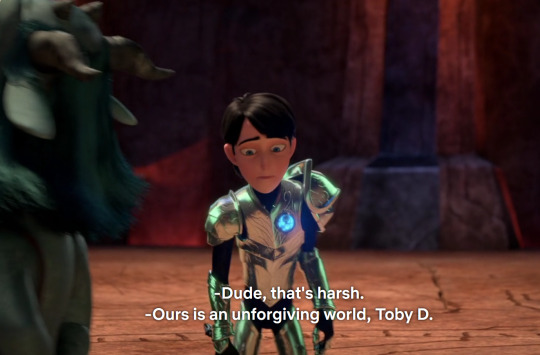
In order to become a good trollhunter Jim must learn to live with fear and to finish his fights.
What is good about these rules is that they are not accepted as always true and there is no black and white view:
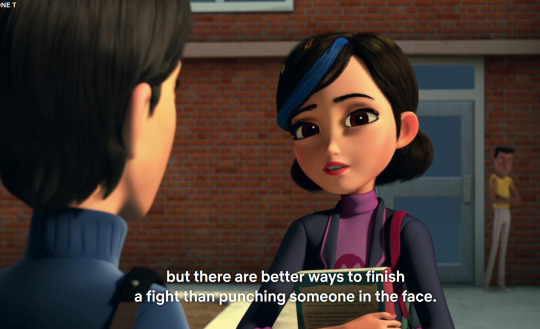

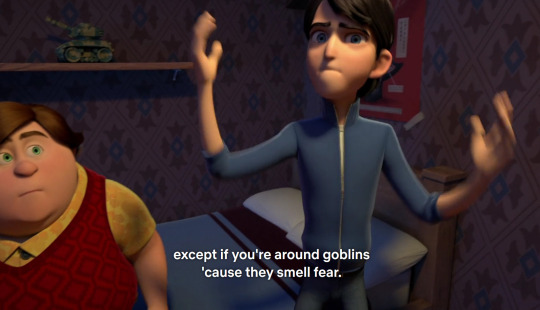
Fear is necessary and Jim must not block it out completely like he did in Young Atlas, but at the same time he should also control it since if he doesn’t he risks to be overcome by it. The idea of not being frozen by fear is explored also in 3 Below:

In this series as well, the idea is not that one can stop being scared, but that they must live with fear and insecurities. However, 3 Below’s approach is far more traditional than Trollhunters when it comes to fear, since the former simply underlines the necessity to overcome it, while the latter spends time showing its usefulness other than it being unavoidable.
The same could be said about the rule of finishing the fight. We see Jim discussing this rule and refusing to apply it blindly. For example, he doesn’t kill Chompsky and Draal and this leads them to become precious allies. However, as the series progresses it is made clear that Jim can’t hope to solve all his conflicts this way:
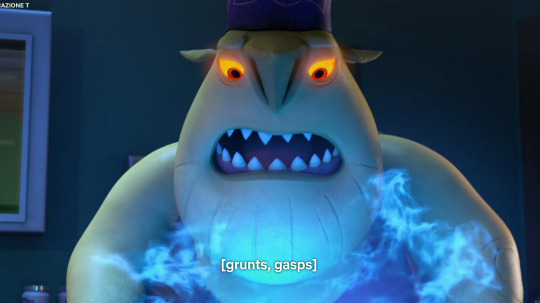
Jim’s first kill is not something which is glossed over, but it is given enough focus to make it clear that this is something Jim is not used to and something he will have to struggle with in his journey to become the trollhunter. Once again, killing enemies is something which happens in 3 Below as well, but it is not given the same focus and Aja doesn’t think about how she should finish a fight.
This is because Trollhunters is a story which deals with the shadow much more than 3 Below is.
This is proven by many details, like the amount of episodes which explore this specific theme (Young Atlas, Where is my mind?, Hero with a Thousand Faces, Mistrial and Error, The Exorcism of Claire Nuñez, A House Divided and Jimhunters are just some examples) and also by its hero and heroine’s paralleled journeys.
Jim and Claire have very similarly structured arcs.
First of all they have a similar flaw:
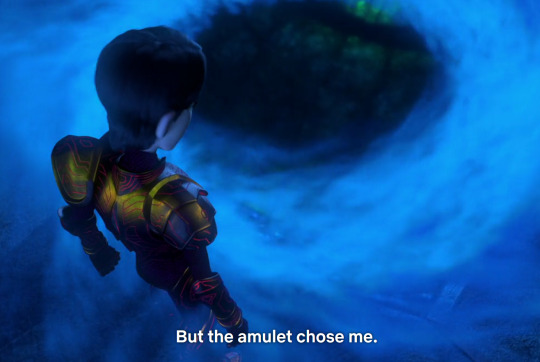
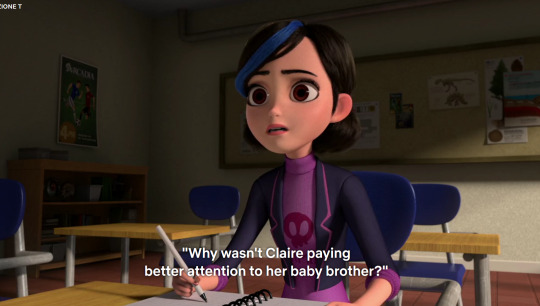
They think that it is all on them and this leads them to try to shoulder too much responsibility in an attempt to help others. For example, Jim thinks that, as the trollhunter, he should enter the Darklands alone to save Enrique, whereas Claire thinks it is her fault Enrique was kidnapped in the first place. Of course both ideas are wrong and this sense of wanting to shoulder it all alone actually creates bigger problems.
Jim entered the Darklands alone to avoid putting his friends in danger, but in the end they had still to enter that dimension in order to save him.
Similarly, Claire’s willingness to sacrifice herself for the trolls let Morgana possess her.
The two situations are clearly paralleled and Claire herself mentions Jim’s previous sacrifice when she is about to make hers:

The parallelism between their two arcs becomes even more obvious if one thinks about it in the following way.
At the end of a season (season 1 for Jim and season 2 for Claire) they sacrifice themselves ignoring their comrades’ prayers not to do it:

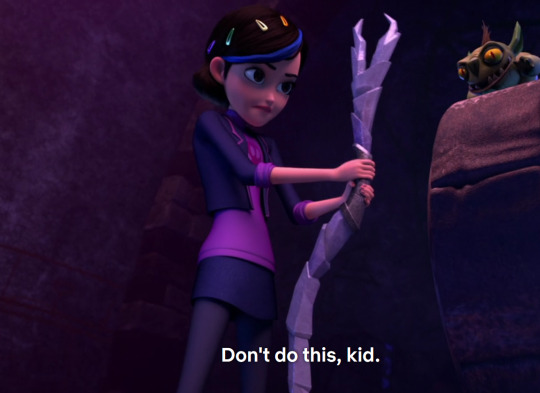
As a result, they both end up trapped in a reign representative of the shadow:

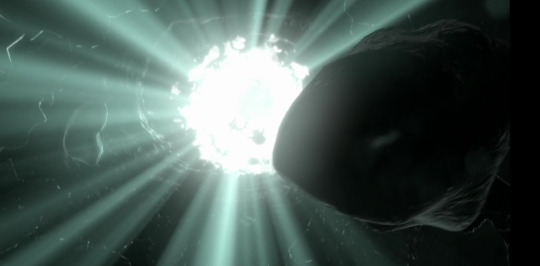
And they need to be saved by their comrades in episode 5 of the following season.
What is more they both integrate symbolically with their shadow:
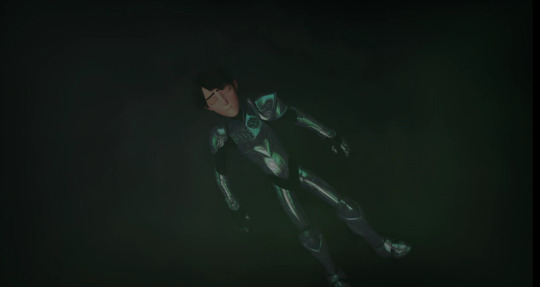

And once they do they defeat the character representative of their darkest side (Gunmar for Jim and Morgana for Claire).
I would like to explore some of the above mentioned situations more.
First of all, it is interesting to highlight that Claire and Jim’s weapons are associated respectively with shadow and with daylight. After all, we are talking of a weapon called Shadow Staff and of an amulet which works with the words daylight is mine to command.
Because of this, Claire’s arc being connected to an integration with the shadow appears obvious.
First of all, her power is not simply called after the shadow, but it works by channelling negative emotions to open up portals. The first negative emotion Claire uses is rage, but later on she changes and starts using fear:
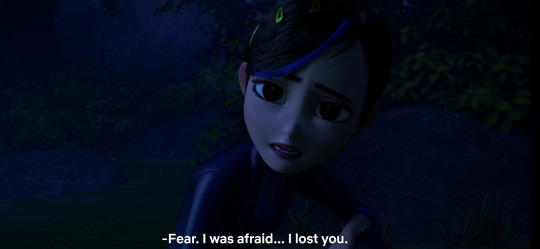
Once again, the first rule is at work here and Claire’s powers are an example of negative emotions being used in a positive way by the person who has them.
However, it becomes clear that indulging too much in negative feelings can let the person be engulfed by them which is what metaphorically happens to Claire when she is possessed by Morgana.
It is interesting to say that while she is possessed Claire refuses to aknowledge the problem:
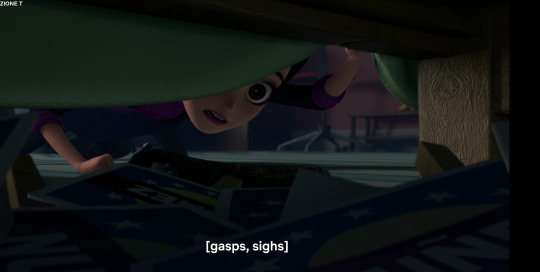
The above frame of her finding the missing signs under the bed is especially telling imo. The idea of having monsters under the bed is something strictly associated with childhood fears:
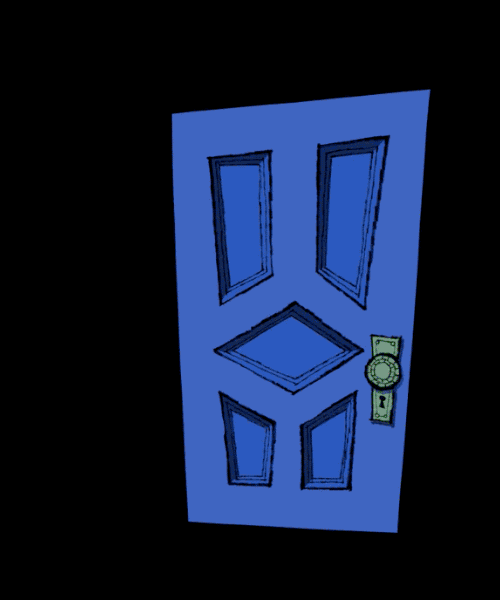
Like the movie Monsters Inc shows perfectly, once a child faces it, their nightmare disappears. In Claire’s case however, she refuses to face what is happening to her and chooses to metaphorically hide it under the bed. She does so because she prefers to maintain the strong and independent persona she has rather than showing vulnerability and ask for help. This makes so that the situation gets worse and she ends up trapped in the Shadow Realm:
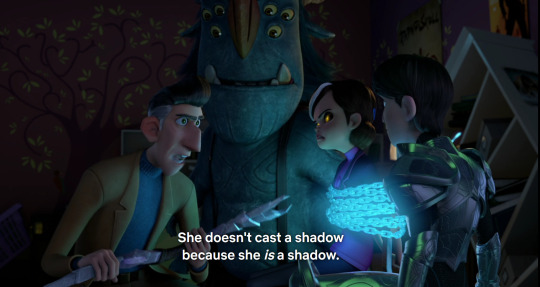
Here, Claire doesn’t have a shadow because her own shadow (which is symbolized by Morgana) has taken over.
So, Claire needs to be rescued by Toby and Jim. It is interesting that Jim and Toby find Claire in an illusory house while she is busy attending her daily chores as if nothing happened. All in all, this is the same behaviour she assumed about her problems after having opened the portal in Trollmarket. However, Toby and Jim are able to communicate with her and to make her snap out from this way of coping with her current situation. Once she does, she is able to fight Morgana herself:
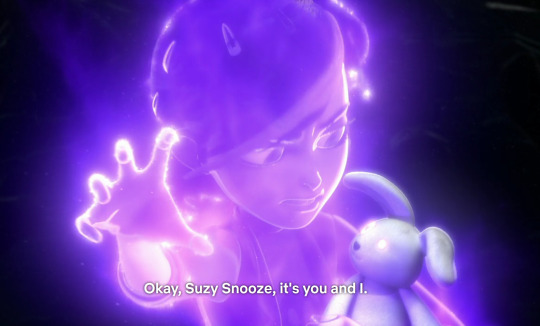
It is interesting that she does so with Suzy Snooze which is an object strictly intertwined with her (it is what Toby and Jim use to find her) and her childish side (which is a vulnerable side of the self by definition and so one she tries to ignore).
After all, Morgana refers to Claire as her child many times, so, in the above scene, Claire freeing herself can be seen as her growing up and conquering her shadow at once.
After defeating Morgana, Claire is able to acquire some traits of the sorceress and to make them her own:

Not only she becomes the true master of the staff, but she is able to remember some simple enchantments and has some visions about how to reach Merlin. This shows that she has successfully integrated with the dark parts of herself acquiring new abilities, but she has managed to avoid being controlled by them.
Jim’s journey is very similar, but it takes longer and it might appear less obvious since, as stated above, his amulet is not associated with shadows, but rather with daylight, so the opposite.
However, I would like to underline some things.
Firstly, Jim is able to kill Bular who is his first major enemy thanks to him being a human:
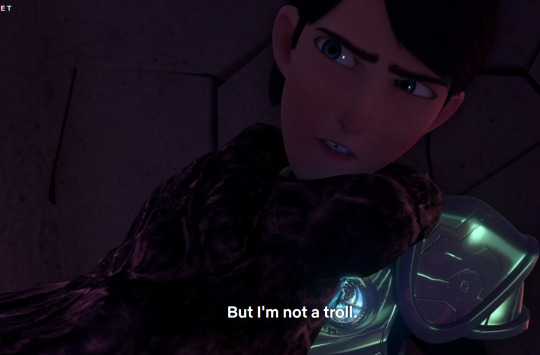
He succeeds where his predecessor failed because of his humanity. Similarly, there are other situations where Jim uses unusual approaches because of his human nature. He avoids killing enemies, insists on working with others and so on. This leads to great results to the point that trolls start appreciating Jim and humanity more. However, at the same time, Jim slowly realizes that he has to embrace the trolls’ traditional ways of thinking more.
This is why he goes to the Darklands alone, for example. The Darklands are a place without sun, so they are perfect to symbolize an immersion in one’s shadow.
What is more, when Jim goes there he wears the Eclipse Armor which is made thanks to the three triumbric stones. These stones are linked to Gunmar himself, so it is as if Jim is assimilating a part of Gunmar in order to become strong enough to kill him.
However, Jim’s journey in the Darklands ends with him needing to be saved and Gunmar is freed as a result. This is probably because when Jim faces Gunmar (a symbol of his shadow) the first time he is still not ready. He forces himself to fight him before the time is right. This is basically the opposite of what Claire does when she ignores Morgana’s presence in her.
However, he will still have to integrate with the shadow when the time comes:
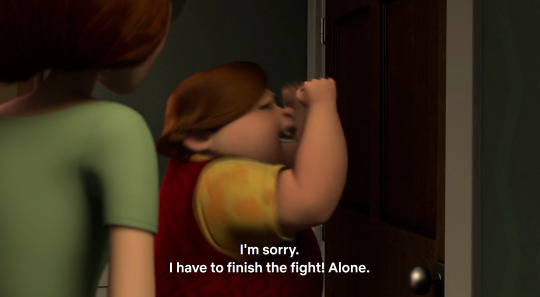
This scene is a direct parallel to when Jim repairs the bridge and goes into the Darklands. Both times his friends are calling him from behind a closed door and both times Jim ignores them and acts on his own. However, Jim’s final choice is framed as necessary to win against Gunmar, whereas him going to the Darklands alone is presented as a mistake. Why is that so?
It has probably something to do with Jim needing to mature and to find a better equilibrium between who he is as a human and his role as trollhunter. As a matter of fact it is made clear in many situations that deep down Jim has always known that his mission as trollhunter would have required him to sacrifice his normal life as a high school student:

After all, the episode Hero with a Thousand Faces is precisely about this. In the episode Jim faces different sides of himself and the most antagonistic one is the one embodying his trollhunter duty. His trollhunter personality represents his fear of having to sacrifice who he is to fulfill his role and Jim’s challenge is to reconcile this side of himself with the others.
Another instance which seems to support the idea that, at least unconsciously, Jim had always known the kind of choice he will be asked to make in the finale is what happens in the Deep:
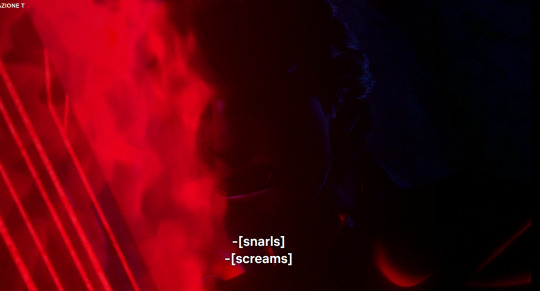
It is explained that the Deep shows you your worst fear against which you have to fight. It becomes clear after rewatching the episode that the one Jim is fighting against is nothing more than himself as the Eternal Knight. In short, Jim is fighting his troll-part which is nothing more than his shadow. This interpretation can be used to explain some things.
3 Below offers us an explanation of what the Deep actually is:


If Krel’s hypothesis is correct and if Jim had actually conquered his fear there, then he should have found Gaylen’s core and broken the curse of the Deep. However, when Krel enters it, the Deep is still working properly. This may mean that Jim did not really conquer his fear, but simply fought it and managed to remain level-headed enough to escape.
This would also clarify why we never see how the battle with the mysterious individual ends. As a matter of fact, in the next episodesJim meet his friends after he has already escaped from the Deep and no more explanation is given. This is odd, but it makes sense if the battle had actually no real end.
This reading would also fit thematically since one of the points of Jim’s arc is to learn how to deal with fear. Sometimes it is not possible to completely conquer one’s fear and the person must learn to consantly struggle with it.
What is more, it would have made no sense to show us a resolution between Jim and his shadow in the Deep since the aim of the narrative was to have him reach that resolution at the very end:
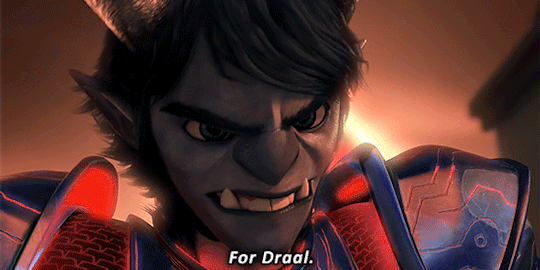
In the series finale Jim becomes half-troll and wears the Eclipse armor for the first time since the Darklands. This is Jim’s second attempt to integrate with his shadow and this time he succeeds because he manages to find an equilibrium between the different parts of himself:
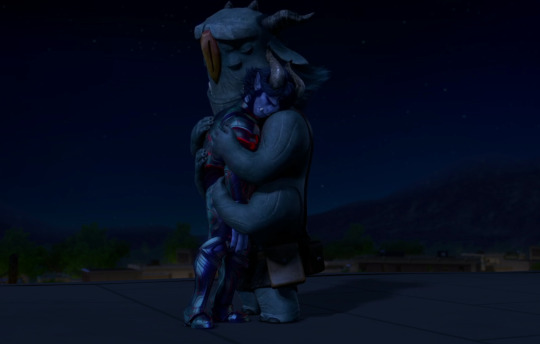
He has to face some responsibilities alone, but this doesn’t mean that the people who love him are gonna leave him behind. In the end, the battle is won because of everyone’s help even if Jim had to make some personal sacrifices and individual choices.
In conclusion, we can say one of Trollhunters main themes is the necessity to face unknown and dark parts of one-self the individual who lives in society usually avoids. In order to do so, the protagonists have to enter a world which is magical and less bound by society rules.
All of this, as anticipated in the introduction, can be summarized with rule number 3. This rule is a rule which must be applied during physical confrontations in order to survive. It is a very instinctive thing to do and implies that the one who does it is fighting for their life without any kind of regulations like the ones in sports.
So the characters must learn to survive in such a world and to adapt to it and at the same time they must show this world the value of humanity.
Here comes another joke which has been repeated a couple times in the series. The trollhunter is someone who hunts trolls, but at the same time it is usually a troll. Why does he have this name then?

The answer is here. It is because he has to protect two worlds. As a matter of fact, it is obvious that if humanity’s shadow is represented by trolls, then trolls who are creatures who can only live in shadow needs to integrate with the “light” aka with their more human parts. This is why the trollhunter is given the amulet of daylight even if all the trollhunters before Jim could not be in the sun. The trollhunter duty invites the one who must accomplish it to understand both humans and trolls and to be an in-between.
As Merlin puts it:
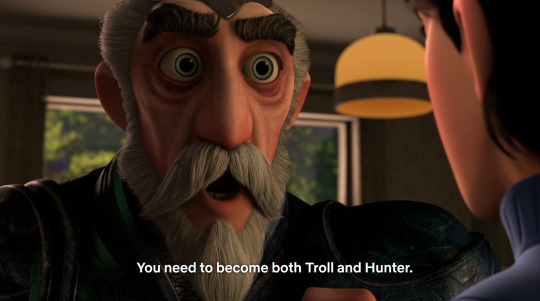
The trollhunter is both a hunter and a troll. So, he is one who hunts trolls, but also a troll himself because each individual must both embrace and control their instinctive parts to become a full fledged adult.
So, in a sense, the trollhunter must hunt himself:

3 BELOW: THE IMPORTANCE OF FAMILY AND SOCIETY
Akiridions are representative of the “other” and of the “stranger” even more than trolls are.
This is made obvious in 3 Below.
First of all, there is the fact that many Akiridions talk with different accents which strengthens the idea that they are not from Arcadia.
Moreover, the series is full of jokes meant to compare the protagonists to members of different minorities:
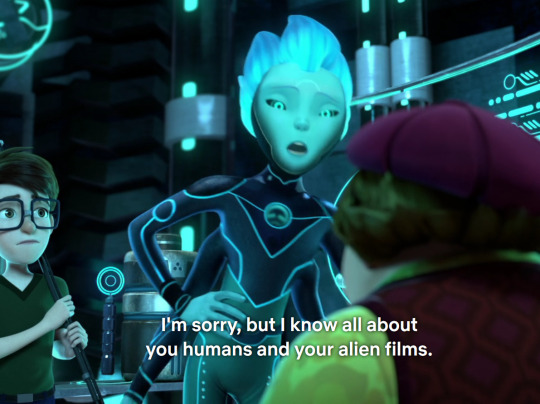
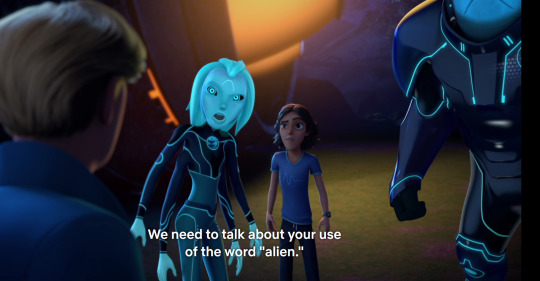
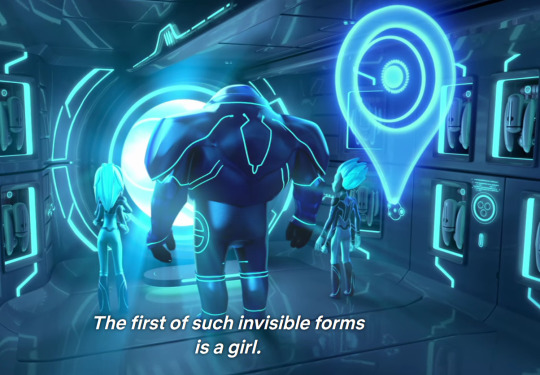

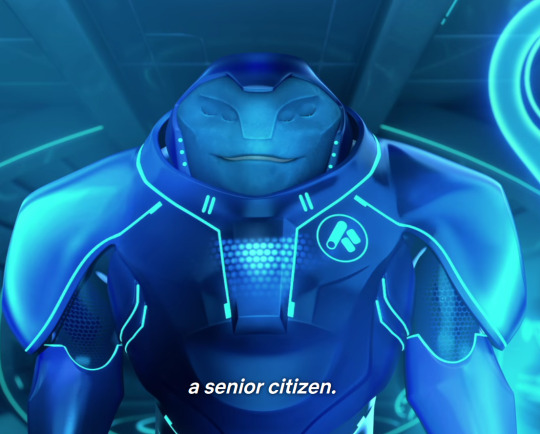
That said, the main characters exhibit prejudices too:
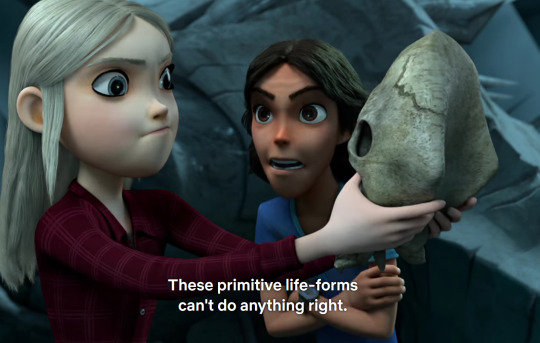
In short, their story is nothing more than a story of integration between different cultures.
What is more, this theme of different cultures integrating or choosing not to is something which goes beyond just the royals’ experience on Earth.
Let’s consider, for example, an important part of Aja’s arc i.e. her struggling to become a queen in waiting who would use her power to help others:
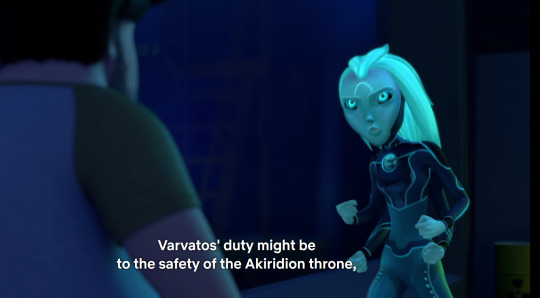
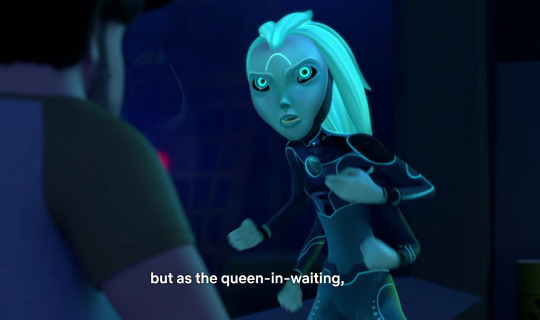
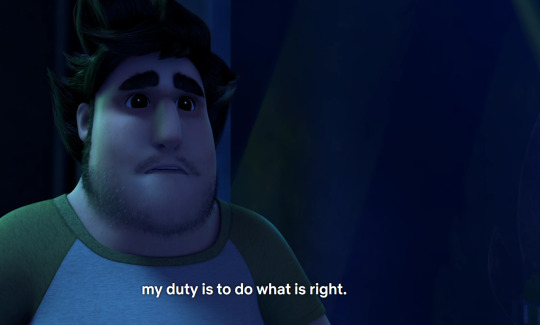
This specific part of her arc is explored by her foiling with Kubritz.
Kubritz is immediately set up to be Aja’s foil since their first fight when she comments that Aja is not the only woman trained in combat. However, their foiling is not about their physical prowess, but about them being two women in a position of authority who want to protect their planets.
Kubritz wants Earth to be safe from invaders who have a much more developed technology than humans. It is because of this inferiority that Kubritz is so scared of other life-forms and chooses to dominate others through strength and fear as her treatment of Tronos Madu especially shows.
Her approach is completely different from Aja’s who tries to communicate with people:
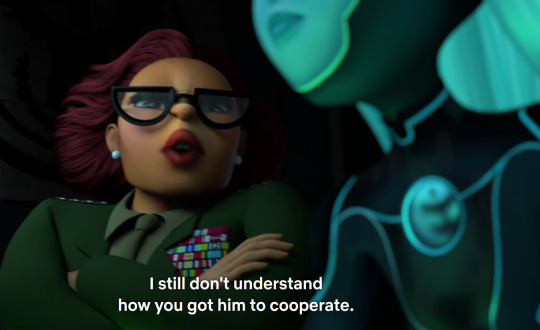
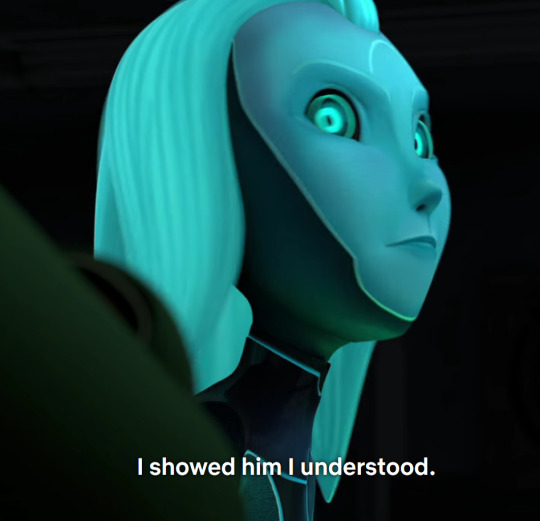
What is interesting is that Kubritz’s behaviour can be compared to the King and Queen’s. Aja and Krel’s parents are surely different from Kubritz and they are positive characters and beloved royals. However, in order to preserve Akiridion’s peace, they chose not to help other planets and not to stop dangerous criminals despite having the means to do so. This is also what it is implied to have led to their downfall:
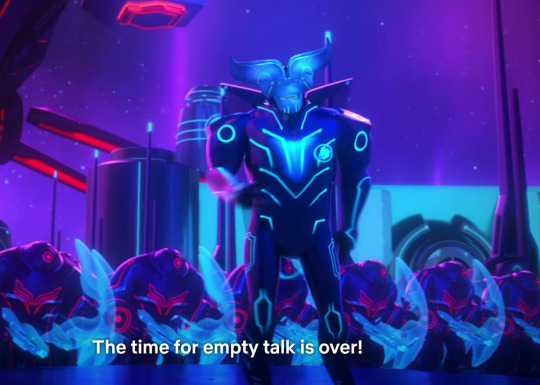
Aja is trying to be better than her parents:
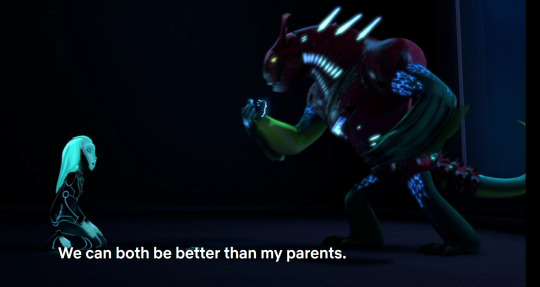
She has repeatedly chosen to help others even when it was not beneficial to her. For example, she refuses to listen to Zadra’s advise not to engage in the fight against the Gumm-Gumms, frees Buster even if that puts both her and her family in danger and so on. It is probable Aja will have to struggle between taking care of the interests of her planet and her generous nature which leads her to be willing to help others. However, I think it is made clear that her rule will be different from the one of her parents and something might have already changed:
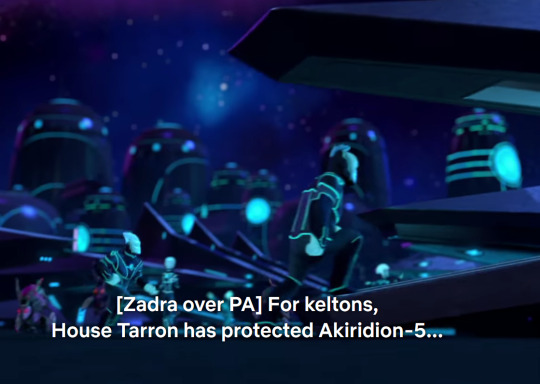
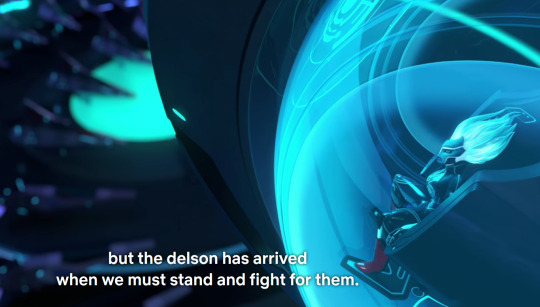
Because of Morando’s coup, the Akiridions have become more active and have taken part in the final battle against him. In her speech, Zadra underlines that the King and Queen protected Akiridion’s peace and that now it is the people’s turn to protect them. In short, it seems to me that we might assist to some change in Akiridion-5 policies now that Aja is the queen.
At the same time, the theme of the “other” is something which is explored also on an existential level:
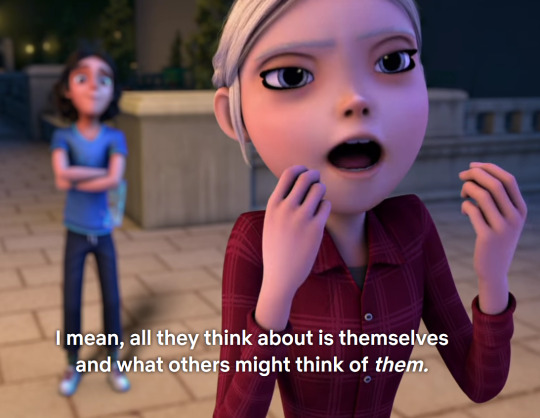
Krel’s mind reading glasses are here used to represent empathy aka the ability to understand others and to relate to them.
This is also why Krel is not able to pick up as many voices as Aja does. It is because, according to Aja, he has got the signal range too low since he is scared of breaking the device. This can be seen as a small detail which sheds ligth on what Krel’s main problem is.
Krel’s initial discriminating behaviour towards humans or his acting superior are nothing more than a defensive mechanism born by the fear of not being accepted. This is made clear by Krel being overjoyed whenever someone shows him even the smallest appreciation like Seamus in season one and later on when Toby and Eli tells him they are already friends:

In short, the story makes clear that it is not that Krel isn’t generous or caring or lacks empathy, but that he is probably scared of being hurt by interacting with others. This has probably something to do with him not having had many chances of interacting with peers on Akiridion-5 because of his status as a royal.
In short, Krel, just like Aja, desperatly needs to be normal, but, differently from his sister, doesn’t aknowledge such a need and assumes a somehow arrogant behaviour which ends up putting distance between him and others.
His arc is essentially about overcoming such a defense mechanism and being more honest with himself when it comes to his feelings towards others.
This ties up nicely with Krel’s passion for technology. As a matter of fact technology plays a huge role in 3 Below as the third rule makes clear. In this series, the possibility to use new technologies to bring people together is explored. For example, they use social networks to promote Dog Fight to save the planet, the siblings are saved from Kubritz thanks to the threath of having a video of the woman making racists remarks going viral and so on. Even in the finale the cannon is built thanks to a picture Toby took with his new phone.
So technology is something which is depicted as useful and fundamental to promote a more open society and it is not by chance that in the end Krel is able to create a wormhole to connect Earth and Akiridion 5 despite the two worlds being extremely far away.
When it comes to Krel, it is also shown in season 2 that his passion for technology is not seen as something completely positive by his father:
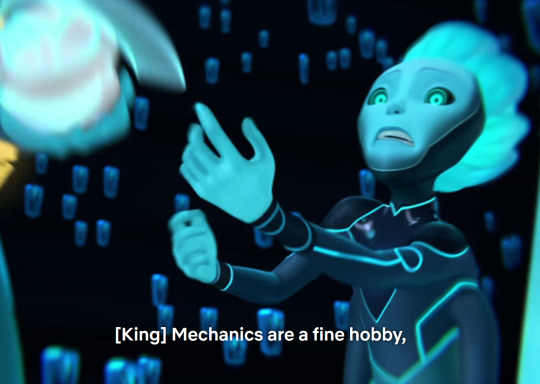
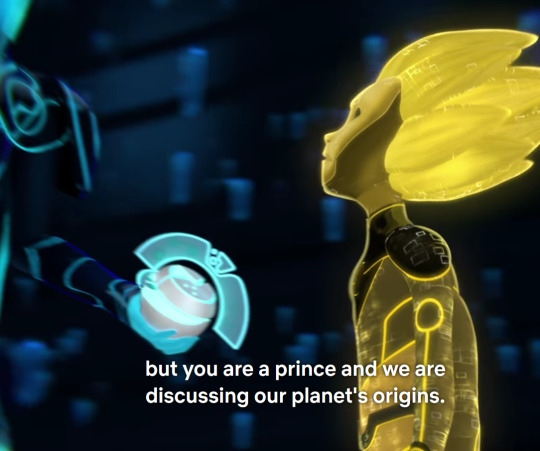
And tha Krel felt belittled for it since his father gave more importance to traditions and considered technology a hobby.
Throughout the series, we also see advanced robots becoming more human. I am talking of the Blanks and of the Mothership especially:

Mother starts becoming more human the moment she is damaged. From that point on she becomes less perfect in terms of performance (she can’t fly anymore and also makes mistakes), but in exchange she learns the importance of human emotions and human connections and becomes a real mother.
In short, we are shown society and community developing thanks to technology, but also technology becoming more human. This is because technology should never be separated from humanity in order to remain something positive.
We can say, in synthesis, that the series is about “otherness” both in how we react to someone different by being at the same time intrigued and scared and in how we are able to develop as individuals only thanks to interactions with others.
When it comes to this, let’s consider Aja and Krel’s two biggest moments of realization:

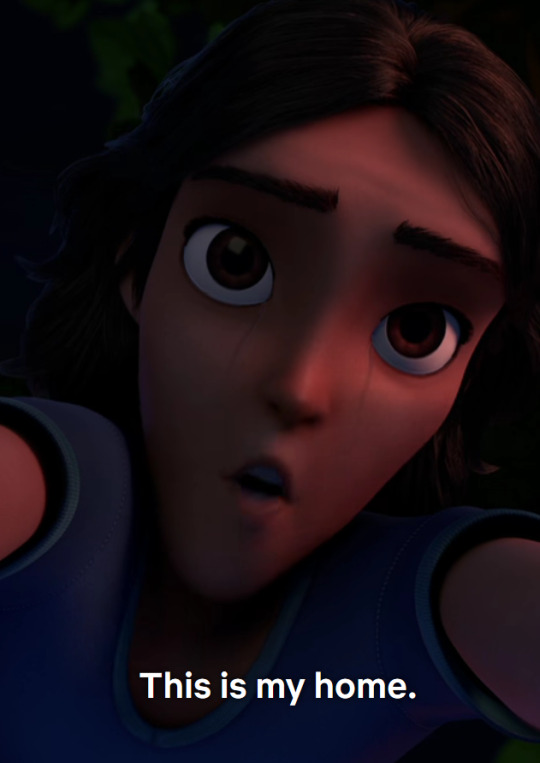
Both siblings have them while they are in a dimension symbolic of the subconscious.
Aja has it while she is in her parents’ subconscious, whereas Krel has it while he is in the Deep which models itself after a person’s interiority. In other words Aja realizes something about herself thanks to observing another person and Krel realizes something about his feelings for others thanks to a journey in his own mind.
As a matter of fact Aja has come to realize what she herself wants. She wants to be a warrior and her main problem with her title of queen is that she thinks a queen can’t be one:
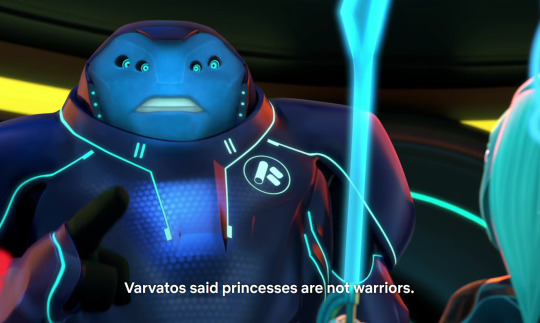
However, by seeing her mother being an excellent fighter she realizes she doesn’t have to give up this part of herself to rule and that she can actually be a wonderful queen and a fighter.
Krel is instead stuck because he refuses to be honest with himself when it comes to his feelings for his friends on Earth. Throughout the series it is made clear that he is slowly growing fond of the planet and of its people, but he doesn’t want to admit it. This is why facing the Deep is so important for him. He grows not just because he overcomes his fear of Morando, but also because he finally accepts Earth as his new home.
These two situations are complementary (like the siblings are on many levels) and they show how the self and the other are strictly intertwined on different levels. Others can be mirrors on which we project sides of ourselves and at the same time understanding one-self better is useful for our relationships with others.
Moreover, when it comes to the royal siblings, their arcs embody the first rule (you must be prepared for change) perfectly. As a matter of fact they have inverted arcs in which each character discovers that what they wanted in the beginning is not really what they needed.
In the beginning Aja wants to be normal and her development makes so that not only she comes to accept that she has responsibilities to fulfill, but she realizes that doing so is really in her own nature and not something which conflicts with it as she thought in the beginning.
Krel is presented as more responsible than her sister and more obedient when it comes to his role as king in waiting. Moreover all he wants in the beginning is to go back home. However, as time passes he starts to exhibit a more childish side and he comes to the realization that he prefers staying on Earth rather than going back to Akiridion as King. Similarly, in the beginning he keeps highlighting his own superiority compared to humans, but by the end he chooses to live on Earth as a normal teenager.
Aja and Krel are also a play on the red oni and blue oni dynamic.
Quoting from the page I linked:
This trope is about two individuals (or occasionally, factions or civilizations) that are significantly linked together somehow (such as through a rivalry, friendship, being siblings, co-workers, competitors, etc.) that have differing personalities and, with it, often different approaches to the world in general, especially whatever they might be competing in/for/over.
The Red Oni is associated with passion, wildness, and defiance. A Red Oni character is often more brawny than brainy, extroverted, enthusiastic, determined, and filled with a zest for life. They are also much more likely to break conventions and rules than their counterpart.
The Blue Oni is associated with serenity, control and observing authority. A Blue Oni is more intellectual, proud, traditional, introverted, and cultured (sometimes more spiritual, although that's not guaranteed). Blue Oni personalities are often respected by others, but also likely to puzzle or confound their peers because they are difficult to read and have a mysterious quality to them.
Aja and Krel fit these descriptions and can be easily associated respectively to the red oni and to the blue oni as their respective colours in human form make clear.
However, as the series goes on it becomes obvious that the attributes listed above are nothing more than the surface of Aja and Krel. As a matter of fact Aja, despite how she appears in the beginning, is actually more mature than Krel under certain aspects and Krel has a very sensitive side which can manifest itself very strongly.
Let’s consider these two scenes in season 1:
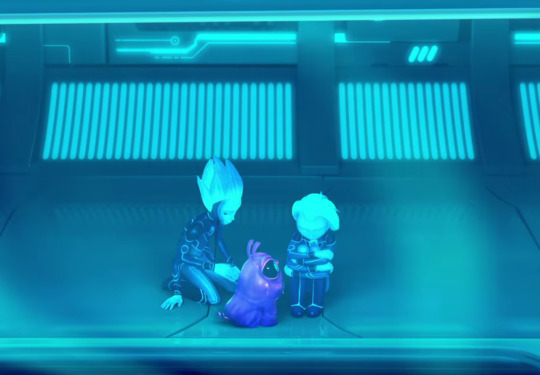
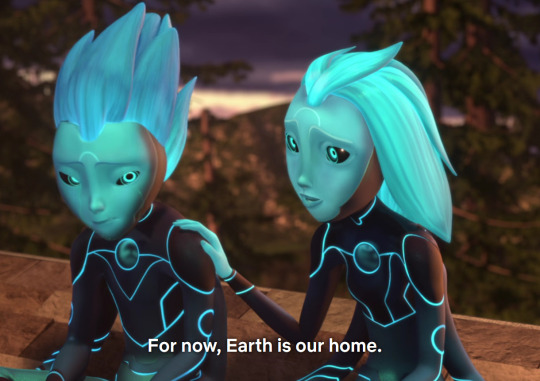
They are parallels and inverses. At the beginning of the season Aja is the one who appears the most lost and is encouraged by Krel, whereas by the season’s end Krel shows insecurities and how the responsibility of repairing the ship is getting to him and Aja is the one comforting him.
By the end of the series Aja and Krel have acquired attributes which in the beginning were more strongly associated to the other.
For example, at the ending os season 1 Krel is the one improvising a speech and is said to be better than Aja in formal situations. However, in the last episode, he encourages Aja to speak for the both of them:
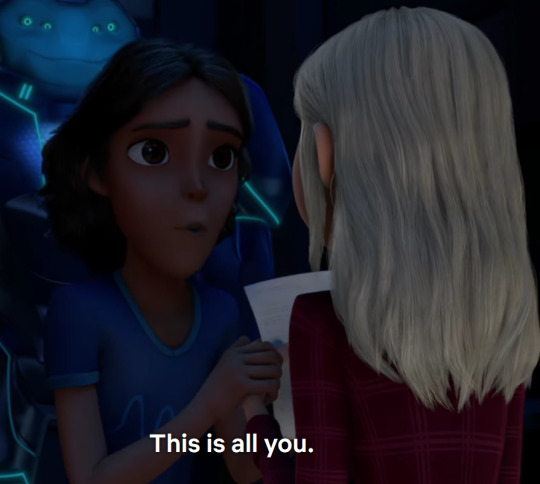
In this way, he shows to have overcome his little jealousy for her by letting her take the spotlight and at the same time he encourages her to speak in public and so to become better in a thing she feels nervous about.
Similarly, Aja accepts his brother’s feelings for his new found home and respects his choice to be on Earth and in this way she gives him the chance to pursue the normal life she once wanted.
In conclusion, it seems obvious that the two royals have changed and have reached endings which are the opposite of the ones they would have wanted in the beginning.
While Aja and Krel’s arcs are perfect to represent the first rule, Varvatos’s is perfect to embody the second one which deals with the necessity of accepting one’s mistakes:
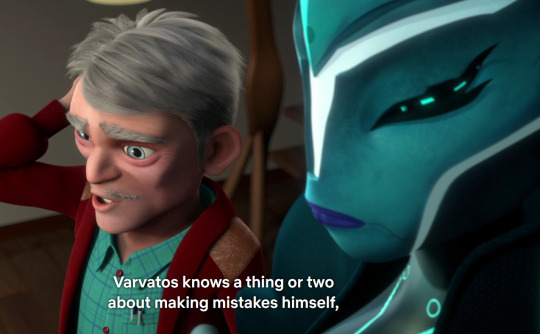
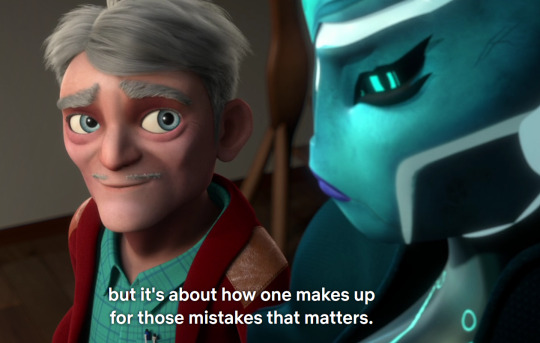
Varvatos’s arc is an arc of redemption and at the same time it is a redemption arc which is a deconstrution of the trope according to which a character has to die to redeem himself:
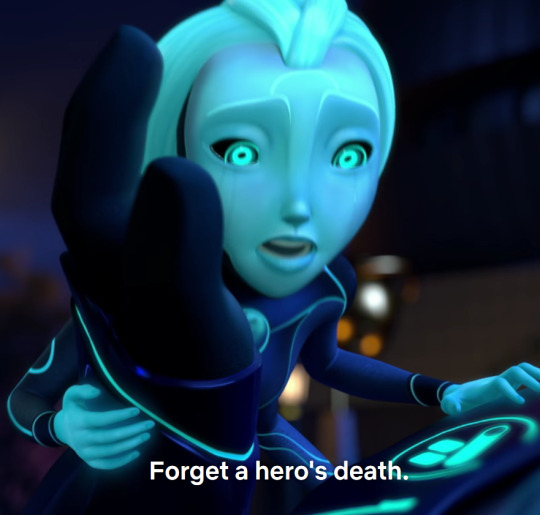
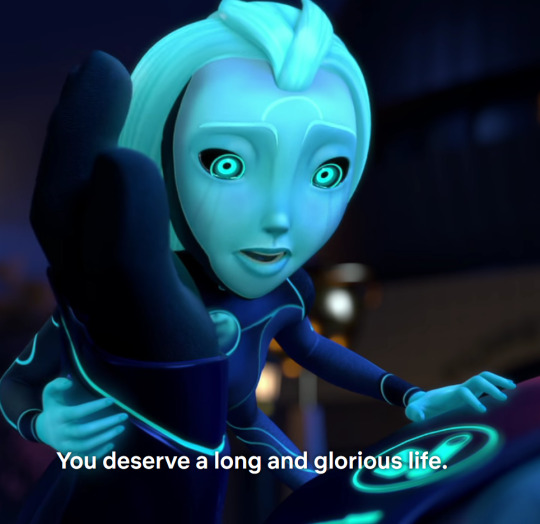
As the scene above shows, Varvatos’s way of having his honour restored is not to die a glorious death which would be very painful for his young lieges, but it is to care for them as their new family.
This is not only something which he must do to help them, but also something which can help him to overcome the sadness for the loss of his family.
The series makes clear that Varvatos’s love for the siblings grows as time passes and he becomes a proper guardian for them to the point that he has no hesitation to suggest using the King and Queen’s cores to spare the two kids. Basically Varvatos repeats what he did in the beginning (he is ready to sacrifice the royals for his family), but this time his choice is framed as the right one and it is confirmed to be the will of the King and Queen themselves once they wake up.
As a matter of fact it is as Mother says:

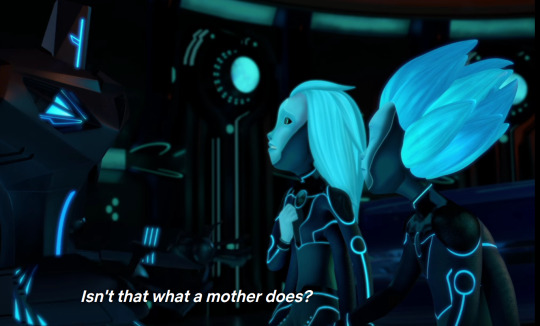
3 Below is the story of two children losing their parents and finding a new family all in once:
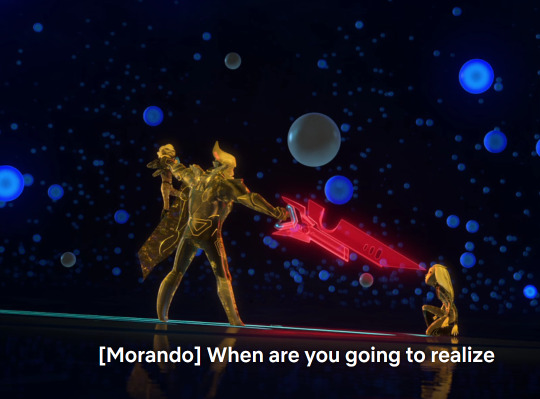
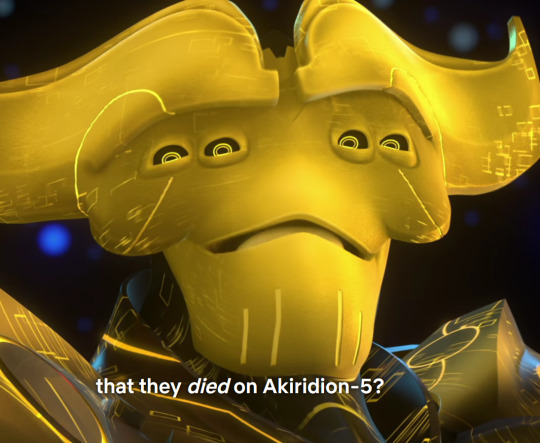
What Morando says here turns out to be the truth since the two siblings will never be able to go back at being a family with their parents. So, we can say that the entirety of the series is a way to let Aja and Krel deal with the loss of their parents and build a support system.
Because of this, their family ends up incorporating many dynamics representative of many different family situations.
First of all, Aja and Krel have to deal with the deaths of their parents, but also with the discovery that they were not perfect. Realizing one’s parents’ limits is a necessary step to grow up.
This is something they must deal with also when it comes to Mother:

Realizing that a parent is not perfect means the child is starting to see that the world is more complex than what previously thought. At the same time, the parent stops being seen as someone perfect and is accepted as a person.
It is interesting to note that Mother parallels the royal parents in the general way her arc is outlined.
At the end of season one, Aja and Krel must fight an omen which has eaten their parents’ cores and a brainwashed Mother. This is symbolic of the two children’s struggle to overcome their parents and to grow up. This can only happen through some kind of conflict which in this case is symbolic and not a direct one. At the same time, the kids are taking their parents’ roles as protectors of the family.
However, even if it is right for the kids to become stronger and able to live by themselves, this doesn’t mean they should be the ones to protect their parents and to shoulder all the responsibility. This is why in the end Mother and their parents are the ones who sacrifice themselves for their well-being in a direct inversion of the season 1 finale.
Other than having to grieve for their parents, Aja and Krel finds themselves in a new family dynamic with Vex who becomes their guardian and later on with Zadra.
Vex and Zadra’s relationship is similar to the one two divorced parents have. Even if there was never romance between them, they still find themselves in disagreement on how to take care of the kids and keep fighting. However, in the end they are able to overcome their problems for the sake of the children and reconcile.
Finally, I would like to talk briefly of the two Blanks. They are basically a parody of a stereotyped American family and it is not by chance that they first appear when Aja and Krel needs to be accepted in school. It is a failed attempt to conform. At the same time, them feeling completely off to others can be seen as a joke about what a “normal” family should be like. In the end there is not a normal family and all family dynamics can be equally beautiful.
In the end the Blanks stay on Earth with Krel and become his guardians. This is a good way to end their story since this means that they have finally settled in Arcadia with a kid who, after some initial struggle, managed to fully integrate. Them being robots also tie with the role of technology both in the series in general and in Krel’s character which has been discussed above.
In conclusion, 3 Below is a series which shows both positive and negative aspects of human society. It explores how society treats the different, but it also shows that integration is possible. Finally it offers a view on multiple family dynamics present in modern society.
CONCULSION: TWO DIFFERENT PERSPECTIVE ON HUMANITY
Both Trollhunters and 3 Below are about exploring humanity, but they do so from two different point of views.
In Trollhunters humans find their humanity challenged by something different and an equilibrium must be found between the trollish and the human.
In 3 Below the weirdness of humanity is shown thanks to the eyes of people who come from a different world. At the same time, these aliens also discover what is good about humanity and what they have in common with it. This shared part is obviously the core of human beings.
At the same time, the two stories are coming of age narratives and it is interesting that their protagonists growing up happen in different ways.
Jim grows when he leaves home together with Claire who is his companion. By doing so, he separates from his mother who build a new life together with Strickler.
Aja and Krel grow when they manage to go home:
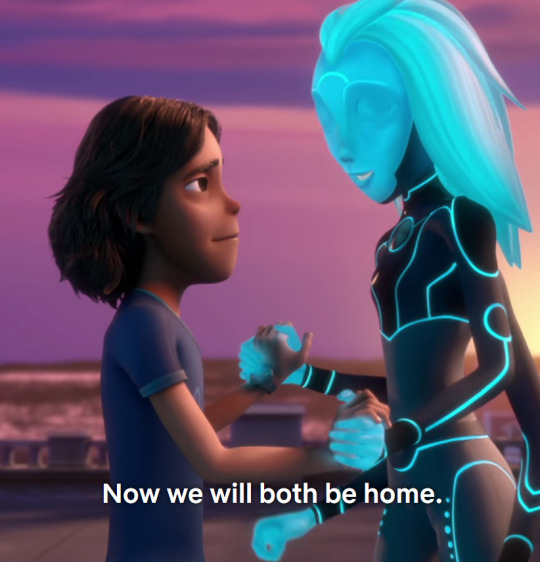
This is fitting for a series where the main characters keep running away. After all, Aja is introduced while she is running to avoid a ceremony and after that they run from Morando and hide. Krel too, in a sense, is running away from his growing feelings towards Earth and his friends which he comes to accept in the end.
At the same time, the behaviours of Claire and Steve who are the MC’s love interests are also opposite. Claire chooses to invest on her relationship with Jim and to follow him in his adventure, while Steve chooses to stay on Earth with his family.
There is not a right or wrong choice, but simply different people who want different things and are taking care of their respective romantic relationships in different ways.
This is something which happens with Barbara/Strickler and Varvatos/Nancy as well.
Barbara chooses to let her son go even if it pains her and embraces a new life with her new partner, whereas Varvatos chooses to postpone his relationship with Nancy to when both Toby and Aja will become self-sufficient and won’t need their help anymore.
These are two different situations a parent might find themselves in and they are both shown as equally valid choices by the series.
#tales of arcadia#tales of arcadia meta#trollhunters#trollhunters meta#3 below#3 below meta#jim lake junior#claire nuñez#aja tarron#krel tarron#varvatos vex#mothership#colonel kubritz
439 notes
·
View notes
Text
Possibility of an Eren vs the Devil final showdown
Okay so I saw @marley-warriors-of-demon-blood's post and I pondered over it for a few days. I finally had the time to write it all down. What I have to say draws a lot from the original post. I'd just like to mention some more hints that I picked up while doing my research along these lines.
First off, I'll elaborate on the recurring mentions of "devil" we get throughout the anime and the manga (also talk a bit about Paths) and secondly, on Isayama's subtle inclusions of numerous other Judeo-Christian references. All of it directly hints at a dramatic ending that may involve Eren, the protagonist, and the main antagonist- the Devil.
1. The Devil : We have had an eerie account of direct or indirect references to the Devil.
• One of the earliest comes from Bertholdt in Season 2 Ep 36 when we first hear him addressing Eldians as "spawns of the Devil"
• The next time we literally get to see the Devil is in Season 3 Ep 43 when Historia revisits her past and the book she reads show us the picture of the Devil and we also see Ymir Fritz for the very first time.

She's present in the story under the alias of Christa, who Freida points out to be a kind girl, always thinking about others.
However, this unsuspecting nature also makes her dangerously gullible and thus, the Devil tricks her into consuming the fruit which'd vest her with incredible powers that could be used to do some potential good work but also wreak havoc on Earth. The illustration was already a foreshadowing of the immediate future event whereby Rod Reiss would try to beguile Historia and get her to eat Eren but she'd see through the ploy and stand up against him. But, that's a different topic and I don't want to digress from my primary point. However this illustration carried an even darker foreboding as we'd realize in the course of the manga.
• The next implication comes from Floch, quite shockingly, during the Serum bowl, also in Season 3. We find him referring to Erwin as the "devil" out of nowhere, that too twice.
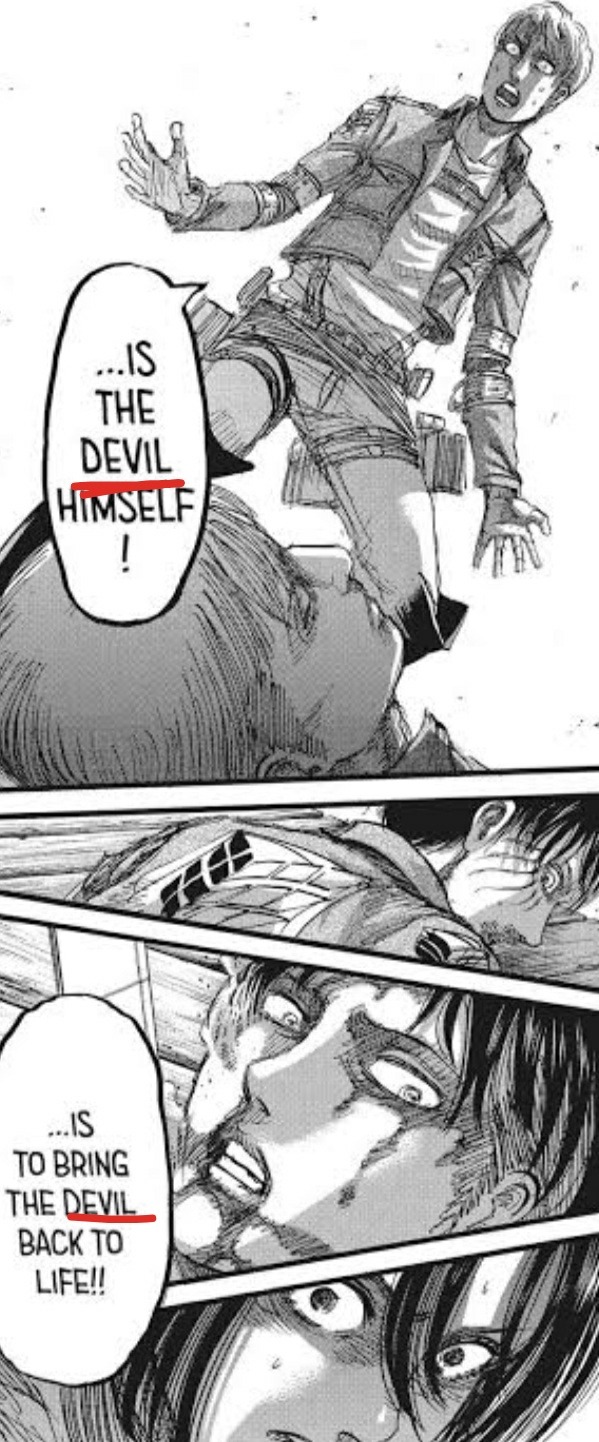
It was horrifying yes, but could it be a darker message for events yet to unfold? Surely Isayama wouldn't drag in the word "devil" out of nowhere. Also, another thing I want to point out here is Levi's decision of finally using the serum on Armin. No, not the usual why (because by now it's clear that he wanted Erwin to rest) but whether or not this action of his, that earned him hard opprobrium from almost half the fandom, had some underlying meaning for us. Maybe more than the shock factor, the serum bowl was allegorical of future events- that the Devil, like Erwin here, is not dead yet and has been playing the strings since eons ago; that the character who is following in Levi's footsteps, i.e., Eren will have to make a difficult choice (which is why Isayama had been stressing on how he'll hurt the fans in the conclusion) and bring an end to the Devil who is still at large. Choosing Armin over Erwin seems to be an absurd decision from a logical pov and Levi's action maybe more than just "letting him rest". Isayama loves foreshadowing. Killing off such an important character could very well be an indication of something more than what's visible on the surface. Perhaps, it was symbolical of how, in the near future, the actual devil, who shares the same caliber as the Commander in plotting, will be forced to rest by Eren, who was trained by Levi to make difficult choices by himself.
• After this , Eren Kruger mentions how "anyone can be the God or the 'Devil' " in Episode 58, while also explaining how everything is connected by PATHS.
• The final and the clearest reference to the Devil is found in Wily Tybur's speech where he informs us of his devilry and we also come across Ymir Fritz, the girl who fell into his trap, and apparently consumed "the source of all organic matter".

There couldn't have been a more prominent Biblical allusion than this one. Now, endowed with such power, Ymir Fritz sets off with beneficial work but, as per the Curse of Ymir, she dies in a few years and we learn that her power is eventually divided into Nine Titans.
• The Devil and PATHS : Only, in chapter 115, do we realize that she hasn't died or at least her spirit hasn't (I'll elaborate on this later). She's STILL very much functional in PATHS - this another universe or another place (whatever term you deem fit for it). When I say functional, I mean how she has to tend to and help her subjects respawn as per the contract with the Devil.

However, notice the rather dark shading on her face? Those are similar to Isayama's signature stress lines that indicate Ymir Fritz is in pain or at least, she doesn't look like she's willingly up for kneading soil to help her subjects reincarnate. Now, if Ymir Fritz from Tybur's tale is still active, how can we rule out the possibility that the devil is active too? PATHS connects the future and the past. Eren Kruger can send words of advice to the future via PATHS, every shifter who's endowed with powers of the past has access to PATHS. In short, PATHS could be the place of any probability. PATHS is the place that warps time, history and even reality. If Ymir Fritz has indeed digested 'the source of all organic matter on Earth', then PATHS, where Ymir Fritz is struck, could be what supports this source or more clearly, it is what nourishes the root of the Titan Power. We know that Ymir Fritz obtained the source from the Devil and now, if PATHS is like nourishment to the source and is sort of a massive energy center (where even the concept of time is lost) it might very well be the Devil's residence or the physical manifestation of the Devil's will. The Devil, as part of a greater ploy, intended to do away with mankind and wreak havoc and that's why duped Ymir Fritz, a naive young girl, into consuming something that'd bind her and her progenitors to his evil will forever by genetic alterations, making it susceptible to his wilful morphing. With this, the main plot that revolves around slavery can finally reach an end. And breaking that tie to the Titan DNA, by destroying the Devil or PATHS (which helps the Devil to enslave Eldians/Subjects of Ymir no matter the era) could resolve the main issue and pave the way to freedom. If Eren does that, it'd be poetic given that Eren Kruger said that the Attack Titan and it's owner has always chased freedom. It's only fair that the Attack Titan (the embodiment of freedom) destroys PATHS (the embodiment that allows slavery). It all sets out beautifully and maybe this is the reason why Isayama even ensured that we get to see PATHS animated as early as in Season 2 Ep 10. Thus, we get a sneak peek of it in Ymir's memory.

It just gives more corroboration to my hunch that PATHS is THAT important and can possibly be the abode of the Devil and hence, be crucial in the endgame. Also, isn't it ironic how Ymir says "I saw freedom spread out before me" in this scene? Or could Isayama be hinting at a possible conclusion that Eren would finally achieve freedom once he is also in PATHS dimension and destroys it? That this scene would be included so early in the anime but not carry some deeper meaning just doesn't settle well.
2. Other Judeo-Christian references : The manga is brimming with those but I'd just point out to a few as some interpretations may seem too far off and I have the habit of snowballing every minute detail.
• Violets : These flowers keep popping up time and again and is even there in the very beginning of the show. Eren wakes up crying from his 'dream-vision' and we find those violets right beside him.

We again see these flowers very briefly under Armin when Eren consciously transforms for the very time in Season 1 Episode 10. This was not in the manga but Isayama wanted this to be animated. He wouldn't have stressed on the importance of including the violets if he didn't have a motif.
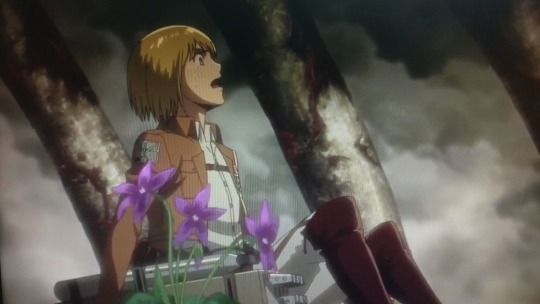
Violets have strong religious connotations in Christianity. They blossomed when Gabriel told Mary of her son's impending birth. Now, Gabriel is the Angel who communicates with humankind and thus stems the potential meaning associated with violets - connections. The symbolism is a very important one as it could be a allegory to how PATHS connects the future to the present, connects all the Subjects Of Ymir. Isayama even canonically included the violets in PATHS dimension in Chapter 115, when Zeke meets Ymir Fritz.
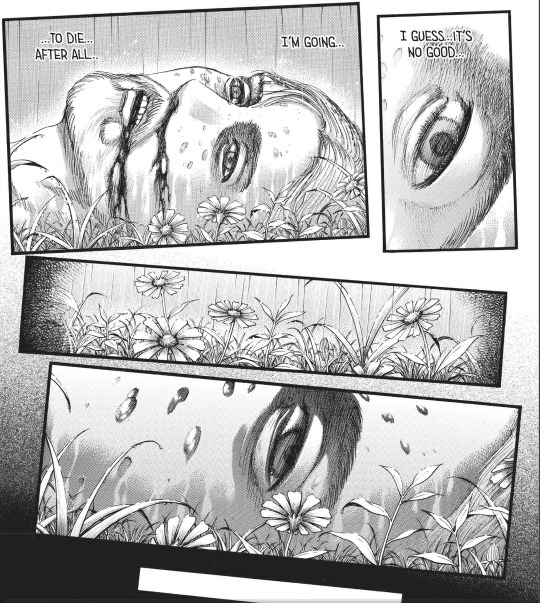
Isayama's emphasis to add violets in the anime and also later, to draw them in PATHS couldn't be for naught. The flowers and what they stand for must be crucial in the final resolution. Also, just as violets blossomed when the birth of the Saviour was prophesized, here in the the SnK universe, violets pop up when Eren is in the frame in the very beginning and when he first reveals his power, indicating he'd be the eventual saviour. If Eren is an allusion to Christ it also justifies what Isayama said : that he wants to 'hurt' the readers. We all know about Christ's sacrifice and perhaps Eren is also going to do something similar which will leave the readers hurting.
• Allusions to literary classics : There are a lot of allusions to Dante's Inferno and even to Milton's Paradise Lost, both of which borrow heavily from mythology and the Bible. But, I'd discuss the ones that I found the most suggestive-
1. Nine : The power of the Devil that Ymir Fritz inherited was split into Nine Titans. In Inferno, we get the Nine Circles of Hell that will eventually lead the poet to Satan. And like we have discussed before, the Devil has striking semblances to Satan. Satan lies below the Nine Circles of Hell and the Nine Titan Powers combined is equivalent to the power the Devil possessed. Uncanny similarity, eh?
2. Ymir and Virgil : Like @marley-warriors-of-demon-blood mentioned, Ymir Fritz is currently caught in a Limbo. She was just a naive little girl and hence, what ensued from her making a deal with the devil wasn't technically her fault. In Inferno, Virgil is distraught similarly- fated to remain trapped in Limbo forever. Now, like I said earlier, PATHS is connected to everything. And Limbo, the first circle of Hell, is also connected to the later circles. I hypothesized in a previous post how I think Ymir Fritz and Eren will meet next in the manga. (with Eren being decapitated and everything) Virgil was the one that guided Dante in his journey in Inferno and Ymir Fritz, currently just a lost spirit in another dimension, may become Eren's guide. She can advise the holder of the two most powerful Titans (the Attack and the Founding) on ways to resolve Eldia's problem by killing it's source, i.e., the Devil, considering she's really a girl with good intentions. This would also resolve her character arc properly. She'd get a stance in the story and not just be someone who was used by the Devil for his conspiracy. After all there's no one more suited for the task than Eren. I'm probably taking it too far but I do think Ymir will have a similar role like Dante. Both are caught in the Limbo, both are not at fault, and both are destined to meet the protagonist.
3. The Crystal : Annie enclosing herself in impenetrable crystal, which outwardly looks very much like ice, could be an allusion to Satan again. In Inferno, he's trapped in ice at the centre of the Earth. Annie is being held captive 'underground'. A very similar process is applied for Satan. He's held underground too and he's enclosed in hard, impenetrable ice, akin to Annie's crystal.
4. Paradis : The name itself could be suggestive of Paradise, i.e., the Garden of Eden, which is mentioned in the Bible as well as in Paradise Lost. The place is described as magical. The 'Paradis' in Isayama's story is not far from being extraordinary and is peppered with rare resources as Kiyomi points out in Chapter 107.

It has "the forest of giant trees", a plethora of resources, and is teeming with diversity. It's equivalent to a biodiversity hotspot, a very rare place on Earth. It has an aura of supernaturality and extravagance, much like the Paradise of Milton. Also, the whole Satan luring Eve with the apple thing (and the Devil's likewise conniving) is also mentioned in Paradise Lost.
So, in conclusion, with this many underlying religious motifs it's highly possible that the Devil is the ultimate villain, like Satan is in Christianity, and Eren's final confrontation is going to be with him- the one who is the root cause of all evil. Even the final exhibition gave a lot of importance to the Devil tricking Ymir Fritz scene. It definitely has much more significance than is apparent.
One of the key themes in SnK has been gray morality. All the characters have their own reasons to justify their commiting the most horrible atrocities they inevitably had to, as per orders. Marley is not exactly on the wrong for torturing and ghettoing Eldians. They fear power that can actually trample on the whole world. Eldia is, of course, not at fault. Their genetic make up may spell impending danger but that doesn't make them any less human. They're cursed alright but that doesn't automatically strip them off their humanity. They have as much right to live as Marleyans. In fact, as we have seen Eren reinforcing from time to time, "Nobody has the right to take that away from us".

Here, Eren also expressed his denial of any plan that even remotely suggested using this probability of turning into a Titan as a weapon to fight. Thus, we can trust that what Eren aims will cause the eradication of this possibility altogether. He will make it so that such a cruel way of fighting doesn't exist ; that nobody will have to be forced to turn into a Titan and die no matter the cause. And the only possible way to do away with this is to kill it's source : the source being the Devil or his instrument, the PATHS.
But, even if nobody is at fault, one cannot veil the truth that Titans exist or rather, the Titan DNA and the inadvertent possibility of an Eldian turning into a Titan exists. It still looms in the SnK universe like 'the grim reminder' we have heard over and over again in the anime. The reminder of humanity being caged and the humility of living under constant fear of Titans popping up suddenly called for invariable Fighting since the very beginning and had also inspired the chase for Freedom. So, how will Isayama bring the main plot/theme revolving Fighting for Freedom to a close? Of course, the answer is by ending slavery in all forms, including Eldians being a slave to the Devil via their fundamental genetic constitution. The Devil is the one responsible for making them Titans, for making the world see them as dreadful enemies. He is the one infringing on their right to freedom and right to live. Thus, Eren WILL face off with the Devil, the cause of all slavery in their world, and finally bring Freedom to humankind. After all, hasn't Eren's character always been all for freedom and for detesting and aiming to do away with every possible form of slavery? If the Devil's very existence is the cause of Eldians being a slave to devilish power, it's only fair that the one character, who has reasserted the importance of Freedom more noticeably than any other throughout the story, is the one that brings the curtain down on the Devil and all his ploys of enslavement and wreckage, consequently freeing his men.
#snk#snk meta#my meta#aot#aot meta#snk theory#snk thoughts#shingeki no kyojin#attack on titan#my theory#eren#eren jaeger#eren yeager#the devil of all earth
302 notes
·
View notes
Text
The Charming Empire - Otome Review (Soshi Amazaki Route)

I was going to hold off on doing this because 1. I wanted to play more routes to have a more comprehensive look at the game and 2. I don’t really have free time yet. Promptly ignored the above logic mostly to get this out of my system.
Before we begin, a disclaimer - While I do have pretty extensive knowledge about the otome genre in both longer “proper” VNs as well as the shorter, bite sized mobile VNs, I’m able to derive enjoyment from most anything (I feel the need to point this out because I see a lot of reviews that get hung up on stuff I can easily brush off even if I do understand where they’re coming from).
This is going to be a spoiler-free review based on Soshi Amazaki’s route alone.
Firstly, I must note that this is a mobile otome game. If you’re looking for something as long and substantial as, say, Hakuouki, Alice in the Country of Hearts, Dandelion, etc. this is probably not the game for you.
Now that that’s out of the way, I’ll be rating it based on usual points with a more... comprehensive and personal look at the end (feel free to skip to that if you know our tastes align and/or just want to see me losing my mind).
Prologue - 1/10
Normally I wouldn’t separate prologue from story. However, as this game started as a mobile game, there is no general route in which one gains points toward a love interest as is standard in full-length otome games. However, even by mobile game standards this game’s prologue fails in that it you meet exactly 0 love interests. Indeed, the prologue is the bare-bones introduction of the setting. This flaw is further complicated by the fact that, because it started as a mobile game, routes are bought individually. This means that there is no way to gauge the love interests except by the game’s straightforward summary on the buy screen. Luckily for me, I was sold at “Kenjiro Tsuda voices a love interest who is both a big brother and a lord” so this wasn’t as knee-capping as it could’ve been, but normally you’d have to simply take a leap of faith because if a love interest doesn’t actually end up being your type, you’re out of luck since you’ve already paid for the route.
This is an aside, but translation for the prologue is... questionable. It isn’t unreadable, like some translations I’ve had the misfortune of reading, but it does create some confusion regarding the MC’s family situation which I can’t help but clear up here. MC is the daughter of the previous lord whose mother moved with her out to the countryside. Her mother is died of illness, and MC now lives with an elderly couple. It’s simply when I say it here, but in game the family situation isn’t actually explained until well into the route and the narration refers to the couple as the “old man” and “old woman,” while the MC calls them “Grandpa” and “Grandma” (ojii-san, obaa-san in Japanese, which is a literal translation of what someone would call any older folk with the degree of familiarity MC has with them) while they call her “princess” (literally, hime-sama). The closeness of referring to them as grandparents vs the distance of the narrative’s “old man/woman” + calling the MC princess in a literal sense (vs. a nickname) is jarring especially because, again, they do not clearly explain the MC’s family situation.
Story - 7/10
Soshi holds the most powerful seat in all the empire. Only trusting himself, he rejects the opinions of others as he continues his dictatorship agenda -- breeding animosity amongst the people. He’s a cold man who sees even his own sister as a political tool.
This is the official description for Soshi’s route. Unfortunately(?) for some this... doesn’t really hold true for most of the route and I find it an odd way to bill it.
The initial conflict/relationship growth in the game stems from the MC wanting to be closer to Soshi - not necessarily in a romantic sense - and his distance due to his position. If you’re expecting a more haughty/sneering/pragmatic Kenjiro Tsuda more along the lines of his role as Kazama Chikage and/or a villain archetype who treats MC as a tool (no judgment, we all got our otome types) he’s by and large not that. Things get more complicated around the 10th chapter, but that’s 2/3 of the game in.
The writing is competent. Again, if you’re looking for complex worldbuilding and something deep, you will not find it here. But, while it isn’t poetry in motion, there was at least no point where I actively cringed or asked myself why I was playing it (this is compared to my experience with Voltage Games and Playchoices).
The MC is tolerable. There’s nothing special about her, but she avoids being a literal faceless protagonist with zero presence while also not having such a strong personality as to be polarizing. She shows more competence and restraint than I expected of her (the bar was nearly floor level, but still).
The pacing is... odd. I get the distinct feeling that it’s a longer otome shoved inside a mobile otome, if that makes sense. I’ve seen other reviews call it rushed, but that isn’t necessarily the feeling I get. For a game to feel “rushed” to me, it has to show a lack of care and attention to detail; scenes are had just to have them and either don’t contribute to the overall plot/theme/feeling of the game. I feel like this game does take care, especially in it’s early bits, but some developments happen later on which don’t get the development time they necessarily need. Which leads me to-
The plot kind of goes off the rails around chapter 10 or 11. It returns to form in chapter 14ish. This... plot twist, shall we say, is predicated on hiding obfuscating knowledge from the reader that should be apparent due to being from the MC’s PoV. Whether or not this is a dealbreaker will depend largely on the person. Personally, I was loopy off resisting sleep medication while reading this part so I just sort of accepted it and the return to form/explanation in later chapters made it worth it, but your mileage will definitely vary. I have Thoughts on this, but this is all I can really say while still maintaining a spoiler free review.
Playtime if ardently listening to the voices is ~3 hours. Playtime can be cut down significantly if you’re a fast reader and don’t overly care about the voice acting.
I haven’t tried all alternate options, but there doesn’t seem like huge variations regarding the choices. The 16th chapter, however, will change based on whether you get the Normal or Happy End.
Art - 7/10
The art isn’t anything special nor is it terrible. It’s much less stiff and has more style to it that most mobile otome’s I’ve played, but is lacking when compared to, again, full length otome games.
The MC has a face, which gets points from me (I dislike faceless MCs a lot especially when included in CGs). The fact no one but love interests even get sprites is somewhat jarring.
As far as CGs go, they’re standard fare and about the number you’d expect for the length of a route. The game isn’t raunchy like... at all so don’t expect anything too scandalous.
Voice Acting - 10/10
What can I say? It’s Kenjiro Tsuda.
To elaborate, however-
Kenjiro Tsuda does an excellent job. I’m not sure if I’d call it his best work, but even if it is voiced, I think there’s some expectation for a mobile otome’s voicework to be phoned in. This is not the case and Tsuda’s acting gives a lot of life to the character and scenarios. I’ll, uh, save my gushing for my line-by-line dissertation, and leave it at that.
What was unexpected was, despite not having sprites, minor characters do get voices! They also have some rather nice performances, and there was no VA I disliked listening to or whose performance was noticeably lacking compared to the others (the actual sound quality was consistent overall as well).
Overall - 8/10
Aside from the prologue, this is a solid performance from a mobile otome game. Compared to full-length otome games it’s lacking, but it’s still one of the better mobile otomes I’ve played. For the $6 you can get individual routes for on the mobile app, it’s a fun, quick romp that was perhaps not necessarily what was advertised (regarding the actual summary), but instead met the expectations I dared to dream of. While I can’t vouch for the game in its entirety, I can, at the very least, vouch for this route.
Comprehensive Overlook + Personal Rating - 10/10
Okay, I’ve been objective as possible despite this being a very subjective topic and now it’s time for me to shill my little heart out.
Writing a standard fare review for this game was really really hard for me because against all odds, logic, and my own taste preferring shit like Hakuouki, I’m in love with this game. Obsessed with it. Half the reason why I’m doing this is because it is a totally unremarkable (though, again, fun) otome game so of course it doesn’t have, like, a community, but I need to fucking gush about it somewhere.
Why?
Because Soshi Amazaki literally hits every single husband trait I so dearly love. This route is the equivalent of if someone took my taste buds and analyzed each and every one of them, then cooked a meal precisely on my most loved things. It isn’t necessarily fine dining, but it feels like it was scientifically engineered to appeal directly to me. It’s like I was possessed and ghostwrote it. It’s like someone peered into my heart and teased out the essence of everything I’ve ever wanted, then told me to eat shit because the shell it’s rammed into is that of a bite sized otome game. I have never had such a feast before me. I’ve never been served such an exquisite palette of flavors. I have never been so thoroughly outraged that this is the form my heart takes.
And yet, I’m... pretty much satisfied, despite its flaws and shortness, with my only real outrage stemming from the fact there is literally nobody I can talk about this with (the morning after I binged the entire route I made my boyfriend play it just so I could rave like a lunatic to someone about it) as well as my shame for being so enamored with what is essentially a mediocre otome game.
I talked about how the story kind of went off the rails 2/3rds of the way through, but honestly? I didn’t care because the payoff was incredible. Was I scared the game wasn’t going to end up where I wanted it to while it was happening? Was I prepared to be immensely disappointed because I felt, briefly, like I was baited and that of course nothing would never let me have my cake and eat it too? Yep. But you know what? I don’t know or care if it’s because I set the bar so low or what, but my expectations were thoroughly blown out of the water.
I’m still committed to making even this part of the review spoiler free, so I won’t be going into depth about what I loved (I’ll save that for another post because this is long enough as it is), but I’ll add this apart from just character archetype and themes being what I loved.
That is, shockingly enough and even considering the pacing and, ahem, weirdness - this is a route where everything seems to serve a function. Again, the story isn’t necessarily deep, and while perhaps I would’ve gone about certain things a different way (and had there been space allotted for greater development), there are many, many, many things that are called back to or that seem insignificant, but serve as thematic backbone and create delicious implications.
As a big brother connoisseur, I give this route 3 Michelin Stars.
If you followed me for/like Fire Emblem’s Marx/Xander, I highly recommend this route.
13 notes
·
View notes
Text
lost at sea
you know, i have died a lot sooner than you or i might think. the thing is, you haven’t found my body. you’re not going to be able to. im describing the area and what i remember when i woke up outside of it being carried by a floating hospital bed, as if i were just as weightless within a dream, but you will never be able to find it. i will elaborate for you on that later.
my body is locked inside of a lighthouse tower, and the rainfall that occurred two days ago has dried out the landscape back to its barren core. the sand doesn’t even glisten within sunlight, it’s dreaded and nearly gray from what looks like centuries of being untouched. there are only two palm trees with wilted leaves and black roots that carry no life, no fruit to bare.
i can see fine out of the lighthouse window to what it looks like, just as i could without a window. its clear enough to feel like you’re not dreaming, but unconscious enough to feel like you are. it looks like it would’ve been populated long ago. the ocean still whispers, lush and loudly with its waves. there is no sea life though. no seashells or the echoes of a baby dolphin.
it looks like what once would’ve been a beach that i’d have been to with my family before their bodies too started decaying, now with the scenery of sand and ocean losing colors. it symbolizes my entire being - the memories are in front of me now, but they’re more dull and lifeless than before. this is where i always wanted to be.
i may have never been here, but i miss it anyways, you know? i feel like if i were here before what i assume would be the civilization fallout and the erasure of all humanity, it would be happier. i wouldn’t feel dead here - like one gravestone among a century spanning miles across earth. that’s where this is, and that’s what it is - but i’ve been given my own place to rot. the solitude i’ve always wanted is right here. its not exactly what i bargained for, but it’s the rules of the monkey’s paw. i felt no need to elaborate further on my anguish, i just wanted to be alone - to die alone.
now that i regret it, however, i wasn’t told that there was going to be another path - that this was a trap for the animal who dared follow the trail of alluring nutriments. i was too naive in my own pain to remember you. and i’m sorry. i did bring myself to my dying place, so technically, this is a suicide letter? i’m still not even sure. it’s not that i wanted to die, you know. i just wanted to disappear. but when i got what i wanted, i didn’t anticipate everything being ripped away from me except the memories of them. starving for them - like the meal in front of you that you just can’t reach through a wall and you’ve been malnourished for so, so long. and it’s all you have to look forward to before you die. its so cold out there, and its so warm in there with the fireplace, and oh god, why did i lock myself out? i don’t even remember what hunger feels like anymore.
i don’t remember what anything feels like anymore, really. i know this probably isn’t where my child self wanted to go to in the future - she would’ve been praying to some god out there that her soul wouldn’t be damned to purgatory so it wouldn’t lead up to this. now that i’m here though, and i have all the time in this timeless, grey dimension that lacks any appealing scenery, isn’t this what i deserve? all those times i’ve spent my life living just as a human would, taking more than i ever give out, taking advantage of anyone in my way, crying tears for nothing when i should’ve sucked it up - should’ve been stronger. all of that potential was wasted. i wish i went to where all my potential could be, dumped in the trash. not stranded in the midst of a nostalgic memory bucket - but then again, i’ve spent most of my life doing that.
so this is where i am now. i don’t physically feel what the steel floor of the lighthouse feels like. the light that populated it simply passes through my eyes like its not even a light - that its just part of the scenery. i don’t know what light or dark even is, because time doesn’t change here. the storms are occasional, but the lighthouse is never touched or budged an inch. nothing ever toppled, nothing ever moved, i never moved. i don’t want to move.
i wanted a dream i could never wake up from, and i got what i earned. i’m not allowed to fly with the birds above our overarching Mother Earth. no. i’m allowed to be buried more than 6 feet under. i don’t even have the luxury of a spider crawling on the back of my hand to keep me company. not a cockroach - not a scent, or a sensation, any new sights or anything new to hear except the same 3 sounds of the weather. thunder hardly even strikes here, not even on a blue moon. its just a feeling of numbed pain in different intervals. not even the memory of you brings any life to me anymore, because all i’m going to have are the memories of you.
where i live now isn’t with you anymore. that time where you came home from a long day of work to pet our 2 year old dog who was happy to see you on his hind legs and then laid in bed with me for the rest of the evening? neither of us knew it was gonna be our last. i just remember the warm sensation of you, but the shit i took for granted was wishing that i were dead and to free you of your burdens. i didnt a god was out there was analyzing all of my sins that would bring me to the perfect ‘resting place’.
you see, you can’t come here to save me. because this place does not exist, and i long to be where i don’t exist. this isn’t how i want to die particularly, but this is a glimpse into the future - and it looks like its the only way my bastard soul is headed towards. what is with you now physically is laying her head at the dinner table, the gaze that of a dying person in a ward who wanted to be deceased long ago. but maybe she was. the point is, you cant get her back, because this is what her mind and soul are accustomed to from now on.
the body is still with you, making dinner, but staring at nothing - because nothing is possessing her except fragmented memories and regurgitated speeches with you. my spirit lurks in the spirit of our childhood beach 20,000 years later in a grey wasteland that is no longer human, trapped like rapunzel but never able to be free. its my status quo where i feel null and devoid of everything to ever want to feel again - to lose you first and to suffer any more heartbreak than my fragile soul is ever able to handle.
i’m sorry that i can’t hear your thoughts, that i don’t know where you are now or how you’re coping, but i’m gone now, and staying gone is all i feel like i want to be. i love you, darling. i love you and the rest of the family that lives with us or checks in with us, who maintained their happy and healthy lives as they should. i hope you’re still able to in your materialistic and beautiful earth, while i’m stranded beyond our mortal plane where no soul has possibly ever gone, unless they were as bad as me.
i’m in the doubling point lighthouse, and i won’t come back.
#writing#tw: depersonalization#cw: hospital#cw: suicide#depression#anxiety#rsd#avpd#bpd#bipolar#idk i could tag this with a lot??#trigger warning#my first writing vent on this blog i think lol#the message of this was actually not what i initially had in mind so thats interesting
4 notes
·
View notes
Text
Sothis, Remembering
Thank you for the support as always, @xpegasusuniverse! This topic is so interesting even I’M at the edge of my seat aksçdlmkasd
Summary: After conjecturing what the Heroes’ Relics were made of, Byleth and Hanneman narrow down their search to the similarities of Byleth’s pulse to a Crest Stone’s. They would need to physically look inside the Professor’s body to find out, though what Byleth would see amounted to much more than answers to those questions...
Commission info HERE and HERE!
______________________________
Part 1 - Part 2 - Part 3 - Part 4 - Part 5 - Part 6 - Part 7 - Part 8 - Part 9 - Part 10 - Part 11 - Part 12 - Part 13 - Part 14 - Part 15
The days passed as though in a blur -- Byleth and Hanneman were barely away from each other after school hours, noses deep in their research. Of course, they tried not to be seen together as often so as not to arise suspicion, changing their meeting places so often Byleth needed a second mind (a.k.a. Sothis) to remind him of where they would meet next.
During a particularly busy morning, the two professors hoarded the Heroes' Relics in their possession at an unused storage room, far from the main halls of Garreg Mach monastery.
For the hundredth time, they tested each and every one of them: they all shone in a shimmering red when at the hands of a crest-bearer, be it Byleth or Hanneman. However, as always, only in Byleth's hands did the Sword of the Creator shine, despite its insides being hollow.
Hanneman shuffled his own hair in frustration. "It's precisely because of the Crest Stones imbued within each weapon that anyone who bears a crest can wield them." He huffed, gripping at the legendary sword until the nodes of his bony hands turned white. "Of course, only those whose crest matches the stone of the Relic can take out the weapon's full potential -- but it is completely different with this." He raised the weapon overhead, as though looking through the hole would make an idea dawn on him out of nowhere. "However, only this- only the Sword of the Creator is different; in anyone's hands but yours, it is just an elaborate pile of bones. Perhaps I could injure someone by whacking their heads with it, but that's about any use I can find for it." He narrowed his eyes, mostly forgetting Byleth was there, though still directing his speech towards the younger man. "But it should be impossible! Unless you yourself are a Crest Stone, it makes absolutely no scientific sense that only your Crest enables you to wield it -- the magic has to go both ways! From the weapon," he rested the sword over his legs, moving his fingers in the directions of the magical flow was supposed to go should a Crest Stone exist, "to the stone, and from it, to the wielder's Crest. Yet, it does not happen this way with-"
It took Byleth a brain hiccup to digest what Hanneman was saying. Him and Sothis exchanged glances -- the floating girl hovering around the room out of sheer boredom as usual -- and widened their eyes at the same time. "Wait, slow down. Back up." Byleth placed one hand over his forehead as though to slow down the rush of thoughts cascading through his mind, lifting the other one to stop Hanneman from talking. "You said 'unless I'm the Crest Stone itself'?"
The older man looked to the younger one as though speaking of something obvious. "Why, yes. You are a unique case -- you possess a power that makes so little sense it is yet to be documented; so it is not far from the truth to say that you are 'unique' in the very essence of the word. Somehow, the flow of magic that should go through the Stone to your own Crest is completely reversed when you wield the Sword -- instead of your Crest resonating with the Stone and, as a consequence, imbuing the weapon with power, you yourself feed it with the energy it needs to be considered a Hero's Relic. Hold it like this," he shoved the sword on Byleth's chest, forcing the younger man to hug it.
The Relic shimmered in red immediately, but Sothis was able to catch what Hanneman was talking about -- something that could only be able to be noticed if one was paying attention: the sword started shining from the parts that Byleth touched first, as opposed to how any other Relic behaved -- through the Crest Stone.
"My! For someone who blabbers all day long research this, research that, Hanneman is actually a competent observer!" Sothis mused as Byleth looked at the bright weapon.
"Hanneman, what if-" Byleth placed the sword on the floor with a tunk. He slowly widened his eyes, watching it fade in color first at the places the tips of his fingers were.
Unless he ‘were’ a Crest Stone. Voices of a distant past; memories that willingly dug themselves deeper and deeper into his mind, eluding any who tried to uncover them.
High quality 'materials'.
The faint pulsating each Stone radiated.
His own chest.
"What if I- what if I actually have a stone inside of me?"
"Preposterous!" Hanneman replied immediately, slapping Byleth's shoulder. "Magical item it may be, it is still a physical object! A human being cannot truly function with a foreign object inside one's body. First and foremost, it would need to hold actual space within the flesh -- and I assure you that no part of the human body is there by mere coincidence; all parts have their roles."
Frowning, although understanding the nonsense he was speaking of, from a biological point of view, Byleth couldn't help but feel this- this yearning deep within his chest. The silent, void chest that had never uttered a sound.
Yet, at that moment, he could practically feel at the tips of his fingers -- feel the phantom thumping his heart was supposed to sound; the beat that should've been a constant throughout his life.
Hanneman kept talking despite Byleth's inner turmoil, deafening even Sothis' exasperated plea for the younger man to stop this line of thinking at once since it was making her feel sick. "As such, even if it were possible to actually insert it into one's body, the stone would need to occupy the space of an organ -- even take over... its... role..." Realization dawned in Hanneman midspeech, his eyes widening as they searched for Byleth's, mirroring his surprised expression.
"My heart!" Byleth looked at his own chest as though he could see its silent inhabitant. "Hanneman -- the stone- it's in my heart! It would all make sense if-"
The older man couldn't stop a large grin from sprouting up, his eyes losing their focus as he completely turned into research mode. "It- as mad as that sounds, it does make sense! However, even if it IS true, what -- or who -- could've inserted such magical, one-of-a-kind item inside a mere child? You've never had a heartbeat as far as you remember, yes?"
"Yes, but that's not the problem right now." Byleth sprung up to his feet. "You need to open my chest, Hanneman. I have got to know if this is true, or not. We can't start conjectures on 'what ifs'."
"My word!" Hanneman also shot to his feet, ignoring the protest of his old joints. "As eager as I am to open up a test subject, you are very much alive, Professor! I do not have the medical license nor the knowhow to keep a subject alive once I start poking at its insides-"
Both Byleth and Hanneman blinked, their minds set on this mad experiment. "Manuela!" They said in unison, snapping their fingers. They looked around at the mess around them, nodded and stormed off of the room, not bothering to lock it behind them.
Manuela had just taken a sip of her tea when the duo exploded into the infirmary with their mad idea, making her sputter and choke on the beverage. "You want me to do WHAT?!"
"It is for the sake of science, Manuela -- for the sake of uncovering the secrets of this world!" Hanneman puffed his chest, seeing the entire world glimmering due to the potential scientific breakthrough he was about to witness.
However, the healer was more than used to her colleague's research mode, so she blatantly ignored him as she dried her mouth with her handkerchief. "I don't think you understand how complex a heart surgery is, dear Byleth! I'll need to quite literally SAW through your sternum, you know? Open up your ribcage and risk you getting an infection just for what? Curiosity? I'm sorry, but I can't agree to this."
"The voice of reason, at last!" Sothis threw her hands up in the air, crossing her legs as she floated about. "Give up this egregious idea at once! I am barely holding on as we speak..." She huffed.
Byleth himself felt lightheaded due to his link with Sothis, but he couldn't stop -- not when they were so close. So close to discovering... something. To digging something up that had been always just out of reach. He grabbed Manuela's shoulders, not realizing how desperate his expression had turned. "I need to know this, Manuela. I beg you, I'm begging..." He lowered his head. "I must know about this lack of heartbeat. I trust your skills completely -- I know you will not allow any ill to befall me during the procedure."
Taken aback by the explosion of emotion the usually stoic Professor displayed, Manuela started to sway positively.
She chewed her lower lip nervously, frowning deeply. "Oh, very well. But only after I make the necessary arrangements -- later tonight at the LEAST."
"Perfect!" Hanneman loudly clapped. "The Archbishop will be away until tomorrow's evening mass, so this couldn't be more ideal!"
"T-thank you, Manuela." Byleth rested his head on her shoulder, the lightheadedness swooping his entire body.
"NO! No, no!" Sothis protested, her voice fading away slowly -- her own consciousness being absorbed into nothingness as Byleth himself passed out. “Noo…!”
The body was exhausted.
So much power was used. So much destruction reverted.
Using the Pulses in every corner of the land only to heal specific spots of it drained more than one would think. So, so exhausted.
"... apply- anesthesia?" A male voice rang at the back of one's head, as though an afterthought through a thick glass.
"-do-...nk I am? Of cour..." A female voice replied, fading away, away... so slowly one felt that even the voice was tired.
One was tired. Exhausted.
Why were they (they? Who are they?) so prideful -- why did they (who was he referring to? What was his mind seeing? A stone throne...?) ravage the beautiful nature to that point?
Ah, was it a mistake from one's part to share knowledge with them? (Share knowledge? Heal the land? Was he seeing a dream? He could see through the eyes of someone else, as though he were trapped into their mind.) But now... it did not matter. The body was exhausted and would perish should it not rest. (The darkness started to make sense -- a very unique stonework inside an underground facility extended as far as the eye could see, a green light illuminating his steps.)
One must rest. (He saw the motion of blinking, though his own eyes did not feel the need to do so -- his eyesight was so much farther from the ground than before, as though he had become someone much, much taller. Another being entirely.)
The power leaves one's body. One has left one's children to care for the land until one can walk it once more. For now... Rest.
Darkness.
Byleth moved his head to the sides, trying to look, seeing nothing but blackness.
The sound of bone being slowly, ever so slowly, sawed, filled the world. Byleth felt it, for the first time.
He felt his heart beating.
The feeling lasted for a single beat, however, as he felt, or rather, saw his own heart being ripped out of his chest. "NO! I DON'T WANT TO SEE THIS!" Sothis yelled so loudly it felt as though she was beside him, not inside of his mind. She sobbed loudly, hiccups filling the void.
Byleth screamed inside the darkness, echoing his mindmate’s wails; the memories of being torn apart while still maintaining a sliver of consciousness cleaving his mind into two.
"THIS... this is-" Sothis curled herself up into a ball. "It's how I-"
Byleth held Sothis' hand as the both of them lay in the cold, somehow now able to physically touch her. "It’s how I died."
20 notes
·
View notes
Text
FE3H x LoZ Part 2
Hi again! It’s been a while but here are some things I’ve come up with since the last post I sent. I hope you enjoy!
THE CHURCH OF HYLIA
I’m still debating upon whethere there will be a fourth route that focuses on the Church of Hylia, so I won’t touch upon the leader of the Church yet (but if anyone has any ideas, please feel free to bring them up!) The following characters are faculty and staff at the Officer’s Academy, and they are all recruitable.
Byleth - So it’s come to my attention that a huge part of the narrative in Three Houses comes from Byleth. Therefore, I’m going to include Byleth in this AU! It feels kind of wrong especially since this blog has given them so much characterization that I feel they without a doubt belong to Three Houses, but the story needs something to drive it forward (one example being Byleth has to choose a house). Unlike Three Houses, however, there won’t be a super big focus on their origins. Sothis isn’t in this AU, after all, so Byleth will just be a normal mercenary who becomes the new professor by chance. I suppose you could say that Byleth is much more of a Mark than a Corrin here in terms of involvement, though they still can have supports with the other characters. Also, they have pointy ears to match everyone else.
Jeralt - Good news: Jeralt is alive for the story this time! Throughout the story he acts as a source of wisdom for Byleth, and eventually gets closer to the house leader and does that for them, too.
Telma - a healer from Hyrule who serves as a professor and the school physician. She really wants a man, and almost always has some kind of dating problems. However, she is very motherly and excellent at her job. Her favorite hobby is making cocktails (which help her drink her worries away) but she doesn’t make any for the students until post-timeskip. Strengths: Faith, Riding, Authority
Kass - he was a traveling bard in his youth but eventually became a full-time professor. He is known for giving profound yet mysterious advice. He has taken Medli under his wing (pun intended) as a musical apprentice. Strengths: Axe, Flying
Robbie - the training instructor at the Officer’s Academy. Known for his flashy battle moves. He has an interest in tinkering and mechanical work. Possesses close ties to the royal family of Hyrule. Strengths: Sword, Lance, Axe
Orca - a general in the Knights of Hylia. One of the oldest knights. He is strict and has a commanding presence over the other knights, and has risen to his position because of his renowned strategic prowess. Strengths: Sword, Lance, Authority
Linebeck - a rather lazy soldier in the Knights of Hylia. He is often being lectured by for his lack of effort. Has a habit of taking credit for achievements that he didn’t contribute to. Strengths: Sword, Brawl, Heavy Armor
Osfala - a former scholar who is now a field physician in the Knights of Hylia. He is a graduate of the Officer’s Academy. Quite prickly, but very attentive and quick-minded on the battlefield. Strengths: Bow, Faith
Irene - a mage in the Knights of Hylia. She is a graduate of the Officer’s Academy. She is not devout to the Church of Hylia, but she took the job in order to help those in need (though she would never admit it). Strengths: Reason, Flying
Makar - a noble child born out of an affair and taken in as a servant of the Church. He can often be found tending to the greenhouse, his favorite place in the monastery. Somewhat absentminded, but always wants to do his best. Strengths: Lance, Faith, Flying
ROUTES
Before we begin, I’d like to announce that the name of the monastery is the Great Plateau Monastery! It’s named after the plateau it sits on, which is in the center of the continent. Its high cliffs act as a natural barrier against any skirmishes that happen on the borders of the nations.
This is mostly just a general summary of each route rather than going chapter by chapter.
Part 1: Clear Skies
Jeralt and Byleth save three children (Link, Zelda, and Ganondorf) from a bandit attack.
Linebeck arrives on the scene and thanks the mercenaries for their work… because he didn’t have to do anything!
It is revealed that Link, Zelda, and Ganondorf are students at the Officer’s Academy and heirs to their respective nations. Linebeck escorts them, as well as Byleth and Jeralt, back to the Great Plateau Monastery.
The mercenaries are recommended to the Church of Hylia: Jeralt as a Knight and Byleth as a professor. Byleth meets the students and selects a house to teach.
Byleth leads their house on various mock battles and real missions, while also using their status as professor to teach and train their students. The students also bond with one another, even mingling with the other houses – the three house leaders are notably close.
During one mission, Byleth and the students are tasked with protecting the monastery from an army led by an assassin known as Sheik. It is at this point where they begin to suspect that there is a bigger conspiracy at work.
Zelda later reveals that Sheik is a phantom that she controls in order to collect information and lead assaults while maintaining her identity as a student. She accuses the Church of hiding the truth from the world, and before she can elaborate, she escapes.
If Byleth has chosen the Azure Owls, they follow Zelda and she explains that there is a prophecy that has been erased from history by the Church, in which the three nations are caught in an eternal cycle of war and hatred over the Triforce Crests. She has learned that Ganondorf, as the bearer of the Crest of Demise, will wage war that will destroy the continent in the future, and she intends to stop that from happening as soon as possible.
If Byleth has chosen the Azure Owls, they join Zelda and siege the Great Plateau Monastery in order to make it a new base of operations for the Kingdom army. If Byleth has chosen the Crimson Boars or Verdant Wolves, they join their students and the Knights of Hylia in defending the monastery.
Regardless of which house they chose, Byleth is knocked unconscious during the battle, and wakes up five years later. The Kingdom, Empire and Alliance are at war with each other, just as the prophecy stated.
Part 2: Relentless Rain (Azure Owls / Kingdom of Hyrule)
Byleth returns to the monastery, where they reunite with Zelda and the Azure Owls. They learn that the Gerudo Empire has allied with the Church of Hylia – though they have different goals, they both oppose the Kingdom – while the Ordon Alliance remains neutral, but is struggling to prevent internal conflict.
The Gerudo Empire invades Kingdom territory, but to everyone’s surprise the Alliance arrives as well, resulting in a three-way battle. There are heavy losses on all sides, with the Alliance army especially damaged.
Zelda’s first plan of action is to eliminate the Alliance while it is still vulnerable. The Kingdom army storms the Alliance capital and though Link is there as the last line of defense, he surrenders upon defeat.
The Kingdom army continues to advance into Empire territory. The Knights of Hylia guard a vital fortress in one last stand, but are defeated.
Zelda and Byleth arrange a secret meeting with Ganondorf in hopes of obtaining more answers about the prophecy, which Ganondorf has learned about in the past five years. When they confront him, they see how much his mind has deteriorated, and they are ambushed by soldiers of the Yiga Clan. Zelda and Byleth are forced to retreat.
Zelda admits that she had worked with the Yiga Clan as Sheik in the past, partially to obtain information about the resurrection of the Demon King and partially to gain their aid in taking down the Church. However, since their goal is to unleash the Demon King, she plans to target them as well.
The Kingdom army arrives at the capital and sieges the imperial palace. Ganondorf has fully lost his sanity and exhausts all of his troops in order to try and overwhelm Zelda. He is defeated, but in a last-ditch effort he uses his Crest in order to transform into a Demonic Beast, Beast Ganon.
Zelda and Byleth defeat Beast Ganon. Zelda briefly mourns that of all people, the Crest of Demise happened to take hold of her friend. However, she is reassured that she has restored peace to the continent. Link steps down from leadership of the Alliance and becomes a lone traveler. The three nations unify into the Great Kingdom of Hyrule, and Zelda ascends as its first queen. She heralds an era of peace and harmony while turning her attention to tracking down the remains of the Yiga Clan.
Part 2: Roaring Thunder (Crimson Boars / Gerudo Empire)
Byleth returns to the fallen Great Plateau Monastery and encounters Ganondorf, who is continuing to grow unstable. He laments that he hears voices and has visions urging him down the path of evil. The two reunite with the rest of the Crimson Boars and claim the monastery as their base.
Ganondorf forces a sudden battle between the armies of the Empire, Kingdom, and Alliance. All three armies are hit extremely hard.
Link arrives at the monastery alone to talk to Ganondorf as a friend rather than an opponent. He urges Ganondorf to stop the war with him so they can live in peace as they did before. In a fit of blind rage, Ganondorf loses control of his own actions and murders Link.
Ganondorf realizes that he needs to locate the source of the darkness within him before he can cause any more damage. However, he must convince Zelda to stop the war, so the imperial army continues its advance into Kingdom territory.
The rest of the Verdant Wolves lead the Alliance army into battle, desiring vengeance for the murder of their friend and leader. Ganondorf is forced to defeat them in order to advance.
The imperial army arrives at the Kingdom capital, where Zelda faces them in one final stand. She refuses to yield, as she believes that her mission to eliminate Ganondorf is the only way to prevent further conflict. Ganondorf regretfully defeats her, and in her dying breath she says to “beware the eye of the Yiga.”
Byleth and Ganondorf obtain a posthumous letter from Impa, which details all of the information Zelda has collected about the reincarnation cycle, and Ganondorf learns of his true nature as the reborn Demise, the Demon King of ancient history. The Yiga Clan are a cult that seeks to revive Demise and bring forth the apocalypse, and the letter includes directions to their hidden base.
The imperial army storms the Yiga Clan Hideout, but in the chaos Ganondorf is restrained by the Yiga. They use their powers to extract the Crest of Demise from his body, and from the Crest’s power Demise is fully revived.
Byleth and Ganondorf engage in one final battle against the origin of evil itself, the Demon King Demise. Upon defeating him, the curse is broken permanently and Ganondorf is freed from its hold.
Ganondorf takes his rightful place as the King of the Gerudo Empire, and eventually repairs relations with the Kingdom and Alliance. He visits the Great Plateau Monastery, where Link is buried, the day before his coronation, and says a prayer for all of his friends who had fallen in the war. He is renowned centuries into the future as the catalyst who laid the continent’s demons to eternal rest.
Part 2: Shining Sun (Verdant Wolves / Ordon Alliance)
Byleth returns to the Great Plateau Monastery and reunites with Link, who has been hopeful for their return. Together they meet up with the other Verdant Wolves and rally their troops at the monastery, which has become their new base.
SIDE NOTE: in this route, Link has the option to recruit any units who were not recruited in part 1 if he approaches them in battle.
The Alliance army advances into the Kingdom, but are stopped by the Zelda and the Kingdom army. Ganondorf and his troops also arrive, resulting in a three-way battle. All three armies are forced to fall back, and Link decides to travel along the border between the Empire and Kingdom in order to avoid more ambushes.
Link confesses that as a commoner who ascended to leadership, he has always been treated as an outsider. His dream is to rebuild the continent into a place where everyone is treated equally, and where the bigotry and discrimination between social classes and nations is abolished. This is why his goal is to end the war in its entirety and unite all three nations.
The Alliance army is attacked by the Yiga Clan, which is when Byleth and Link first learn of the cult’s existence.
Before departing from the border and heading into Kingdom territory, the Alliance army faces Ganondorf and the imperial army one more time. Cia is particularly conflicted about her loyalties, and if Link recruits her during the battle, Ganondorf calls in reinforcements that surround them completely. Link is forced to defeat Ganondorf in order to proceed, and in Ganondorf’s last moments, Link promises to bring peace to the continent. (Though Link is not aware of the prophecy, he unknowingly fulfilled it by defeating Ganondorf.)
The Alliance battles its way through the Kingdom until it reaches the capital. Zelda refuses to hear Link’s pleas to cease the war, and the Kingdom engages the Alliance in battle. Midway through, she calls upon the Yiga Clan, and they arrive as reinforcements. Byleth and Link are able to endure and come out victorious, defeating both the Kingdom and the Yiga.
Zelda survives, but is exiled out of the continent. The three nations are united into the Hylian Alliance, and Link becomes its first ruler. Link is still upset over losing Zelda and Ganondorf, but makes sure to honor them by making his reign a just and noble one thats brings the Alliance into a golden age. He is remembered as a progressive leader who utilized his kindness and generosity in order to bring together people from all walks of life.
CRESTS
I’ve decided that Crests and Relics are also in this AU! Here are all of the ones that appear in this universe.
There are four crests that are not passed on by bloodline: the Triforce Crests (Din, Nayru, Farore) and the Crest of Demise. These are the oldest Crests; they can manifest in anyone regardless of status, but appear very rarely. The Triforce Crests are capable of manifesting in someone who already has another Crest, and they won’t have any negative effects, unlike what is shown in Three Houses. The Crest of Demise is a different story.
Din - one of the Triforce Crests, also known as the Crest of Power. Its Hero Relic is the Mirror Shield. Bearers: Ganondorf (minor)
Nayru - one of the Triforce Crests, also known as the Crest of Wisdom. Its Hero Relic is the Bow of Light. Bearers: Zelda (minor)
Farore - one of the Triforce Crests, also known as the Crest of Courage. Its Hero Relic is the Master Sword. Bearers: Link (major)
Demise - an ancient Crest named after the Demon King who bore it. Bearers of this Crest eventually lose their sanity and gain an unquenchable bloodlust. Its Hero Relic is the Demon Trident. Bearers: Ganondorf (major)
Hylia - a Crest that is usually found in members of the royal family of Hyrule. Its Hero Relic is the Goddess Sword. Bearers: Zelda (major), Fi (minor)
Nabooru - a Crest that comes from one of the first warrior heroes of the Gerudo Empire. Its Hero Relic is the Scimitar of the Seven. Bearers: Urbosa (minor)
Kakariko - a Crest that originates from Hyrule. Its Hero Relic is the Sahasrahla Staff. Bearers: Osfala (minor), Robbie (minor)
Holodrum - a Crest that originates from Gerudo. Its Hero Relic is the Golden Gauntlets. Bearers: Onox (minor)
Zora - a Crest that originates from Hyrule. Its Hero Relic is the Lightscale Trident. Bearers: Ruto (major), Mipha (minor)
Lokomo - a Crest that originates from Ordon. Its Hero Relic is the Light Force Gem. Bearers: Byrne (minor)
Goron - a Crest that originates from Hyrule. Its Hero Relic is the Boulder Breaker. Bearers: Daruk (minor)
Rito - a Crest that originates from Hyrule. Its Hero Relic is the Harpstring Axe. Bearers: Revali (minor), Medli (minor)
Kokiri - a Crest that originates from Ordon. Its Hero Relic is the Fairy Bow. Bearers: Saria (minor), Makar (minor)
Twili - known in Hyrule as the Interloper’s Crest. The first bearer of this Crest left the continent and founded the kingdom of Twili, and it is only found in members of the Twili royal family. Its Hero Relic is the Twilight Spear. Bearers: Midna (major)
NEW CLASSES
These are some classes that I would’ve liked to see in Three Houses, so I wrote them down because it makes sense for certain characters. Also, the house leaders have their own Lord classes.
Dark Flier - a wyvern rider who uses lances and reason. I imagine this to be Midna’s canon class.
Holy Flier - a pegasus rider who uses axes and faith. I imagine this to be Cia’s and Medli’s canon class.
Blade Scion - an infantry unit who uses swords, lances, and gauntlets. I imagine this to be Impa’s and Groose’s canon class.
Goddess Knight - a horse rider who uses bows and reason. This is Zelda’s advanced class.
Holy Queen - a horse rider who uses bows and reason. This is Zelda’s master class.
Radiant Knight - a horse rider who uses swords and faith. This is Link’s advanced class.
Legendary Hero - a horse rider who uses swords and faith. This is Link’s master class.
King of Thieves - an infantry unit who uses lances, gauntlets, and reason. This is Ganondorf’s advanced class.
Demon King - an infantry unit who uses lances, gauntlets, and reason. This is Ganondorf’s master class and Demise’s only class.
OTHER NOTES
I forgot to mention in my last post that Shad is also a Crest researcher, so he’s basically Linhardt but without the sleepy.
Pre-timeskip, Zelda has shorter (BotW2) hair, Link has a ponytail (BotW), and Ganondorf has short (OoT) hair. Post-timeskip, Zelda has long (BotW) hair, Link has short (TP) hair, and Ganondorf has long (HW) hair.
Zant is Midna’s adoptive brother, so he is from Twili, but not of royal heritage. He hates Midna because she is the true heir to the throne but seemingly takes it for granted and does not take her responsibilities seriously. Upon enrolling at the Officer’s Academy, both of them were members of the Crimson Boars, but Midna transferred to the Verdant Wolves after meeting and befriending Link prior to the events of the story.
The equivalent of the Death Knight is Cherry. Yes, Robbie’s ancient oven Cherry. She can create Ancient Arrows at will, so she’s basically the definition of a scary unit.
I’m in love with the Link’s Awakening remake and I wanted to include Marin in this AU somehow so, so badly, but she’s basically Malon + Medli, so it seems a bit redundant. Just know that I love Marin with my whole heart.
#submission#anon#fire emblem three houses#fe16#legend of zelda#zelda au#WHOOOOO A ZELDA AU UPDATE I WAS SO STOKED TO GET THIS!!!#ok there's many things to yell abt so im going to go in any order#first can i just say i love the attention to detail??? the crests.. hero relics.... the parallels btwn this and 3h's story.... everything#flows and fits so well together and i love it!!#firstly nJERALT IS ALIVE?? I THANK YOU FOR MY ENTIRE L I F E THIS IS ALL IVE EVER WANTED#telma as manuela.... i love telma sm so thi s is golden#and ofc linebeck has to be there!! i love linebeck... imagining his just Showin Up is just so funny asdfsjdfh#also iRENE!! ok i'll stop gushing abt chars now becayse that'll take forever LMAO#great plateau monastery is a lovely name i like it!! also v fitting for the location parallels huehuehue#sheik's used v cleverly n i like it! reminds me of phantom hourglass which is prob what you were aiming for. i totally expected a zelda is#sheik thing a la flame emperor reveal so this totally threw me off nice job#the part 2 names are so good? shining sun... roaring thunder... relentless rain.... i actually like these better than canon fe3h p2 names#and the plots!!!! OH MY GOD. i am so UPSET ganon kIlls link in a fit of raGE??? THANKS FOR SNATCHING MY FEELINGS TONIGHT :(#zelda being exiled is so v bittersweet oof#ganondorf vs demise a la byleth vs nemesis ingame? chefs kiss. i love that cinematic parallel#i was actually thinking abt something along the same lines the other day so our minds anon!! our minds!!!#those crests and new classes??? omg.... i Need to see a blade scion pls.... also demon king... b l ease...#CHERRY AS THE DEATH KNIGHT DSJHSHDF WITH ANCIENT ARROWS??? THATS HILARIOUS BUT ALSO REALLY TERRIFYING.#how do u escape the one who Canonically Creates ancient arrows... you can't..... :o#i cant believe that the ancient materials oven is the death knight dshjdhfhdHDSHDSHjhhjhh HHHHHH#AAAA I NEED TO PLAY THE REMAKE!! but honestly i agree. i love marin with all my heart too#even if she's not in this au i just. Love her. she's there as a seagull maybe or smthn#in conclusion.... this au still has my entire SOUL and HEART. thank you for feeding us once again!!!#i'll add this post to the masterlist huehuehuhe
17 notes
·
View notes
Text
The Siren and The Gorgon (4x14 and 14x14)
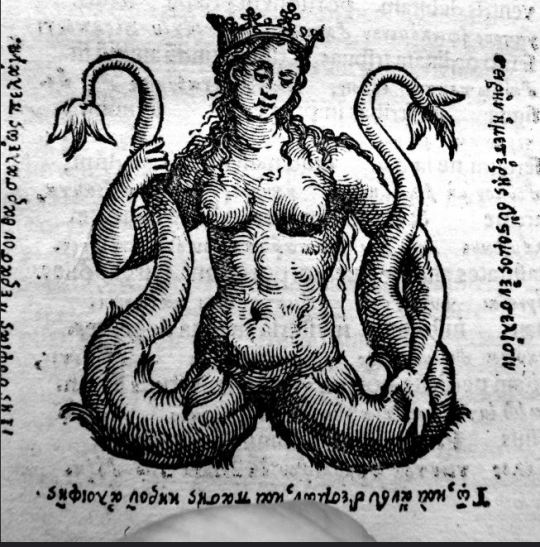
Medieval image of a Mermaid-Siren.
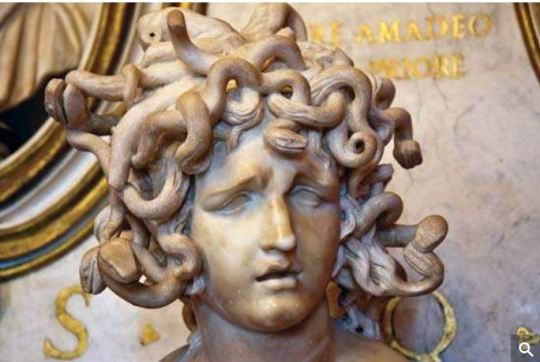
Sculpture of Medusa by Bernini (1630, Rome)
This meta links to, and elaborates further on, an earlier post of mine about queer subtext in 14x14 Ouroboros, “The Kiss of the Queer Gorgon”.
http://drsilverfish.tumblr.com/post/183323000224/the-kiss-of-the-queer-gorgon-in-14x14-ouroboros
Yockey has been playing with the Ouroboros form of Dabb’s narrative by having some of his episodes recall numerologically similar previous episodes in order to, additionally, illuminate them thematically. 14x10 Nihilism recalls 4x01 Lazarus Rising - Pamela Barnes appearing in Dean’s mind-bar wearing her Cas-referencing “To Hell and Back T-Shirt” and her silver winged-figure necklace, just as she first “introduced” Dean and Cas in 4x01. Yockey does it again in 14x14 Ouroboros, this time, recalling 4x14 Sex and Violence, via certain correspondences between Nick the Siren and Noah the Gorgon, not least their similar sounding names, Nick/ Noah...
The Siren and the Gorgon in Ancient Greek mythology are both feminine supernatural beings. One lured sailors (men) to their deaths on the rocks with sweet and deadly singing and the other (specifically Medusa, although there were two other Gorgons) turned men to stone with her snake-haired gaze.
I love both of them so much, because although we could understand them as representations of the monstrous feminine in a patriachal culture, I will always, always hold Guillermo del Toros’ beautiful quote (from his Shape of Water Golden Globes acceptance speech) to my heart:
“Since childhood I’ve been faithful to monsters — I have been saved and absolved by them. Because monsters, I believe, are patron saints of our blissful imperfection,”
https://www.hollywoodreporter.com/news/golden-globes-guillermo-del-toro-wins-best-director-shape-water-1072334
There is a lot of academic writing on the subject of the “monstrous feminine”. Here is a relatively accessible popular article on the “monstrous feminine” in the horror genre, titled “Medusa’s Gaze: The Monstrous Feminine”:
http://nickelodeon.org/7197-2/
In Supernatural, in 4x14 we see that the Siren’s “true” form is indeed monstrous-feminine:
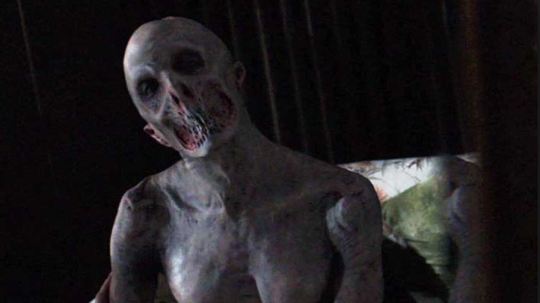
In 14x14 Ouroboros we get this shot of a lore text Treatise on Gorgons (not an actual book as far as I am aware, so one made specially by the props department):
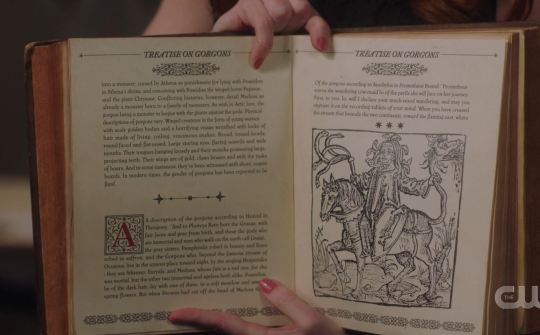
It reads (excerpt) “Physical descriptions of Gorgons vary. Winged creatures in the form of young women, with scaly golden bodies and a horrifying visage wreathed with locks of hair made of living, coiling venemous snakes. Broad, round heads, round-faced and flat-nosed. Large staring eyes, flaring nostrils and wide mouths. Their tongues hanging loosley and their mouths possessing large overhanging teeth. Their wings are of gold, claws brazen, and with the tusks of bears. And in some instances, they have been witnessed with short coarse beards. In modern times, the gender of Gorgons has reported to be fluid.”
So, SPN gender-queers both the Siren and the Gorgon we meet. Because, in going after Dean, the Siren famously appeared in the form of Nick Munroe, who we see here looking at his true!form reflection, although to other male vics, it had appeared in female form:
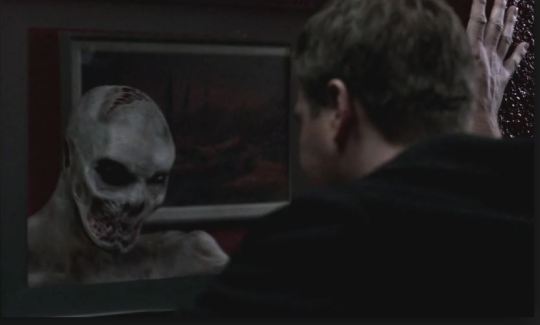
Noah the Gorgon also appears in male form (although the episode tells us via the lore book he too, like the Siren, may be somewhat “gender-fluid”).
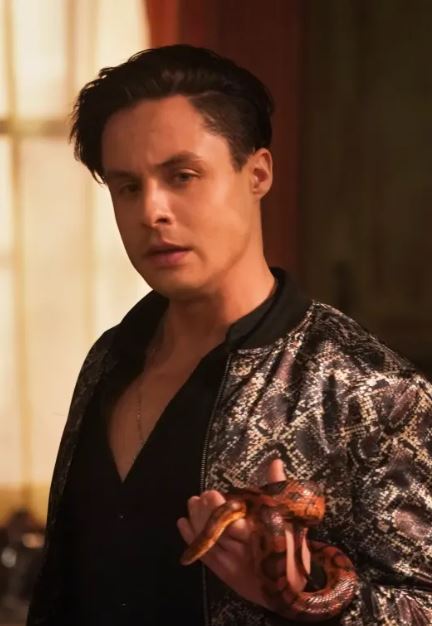
Yockey also uses Noah to comment on the earlier, less self-aware and more misogynistic, treatment of the monstrous feminine in Supernatural by making Noah a feminist:
VIC: “You’re just preying on helpless men?”
NOAH: “”Helpless men? That’s rich! No, I do eat ladies too, but women have become so cautious lately, must be all that finally waking up from centuries of misogynistic oppression. Good for them.”
(If you look at the Script for Sex and Violence, in old school SPN form, both “bitch” and “slut” are used about the strippers in the story, in the final confrontation between Dean, Sam and the Siren. I love Yockey.)
Whilst the Siren and the Gorgon are traditionally associated with the “monstrous feminine”, in SPN they are also mobilised in another narrative tradition, that of the “monstrous queer”.
“Since the earliest days of the moving image, the figure of the monster has been implemented as a way in which to mobilise ideological tensions and socio-cultural anxieties connected to particular time periods and historical moments. Within the horror genre (the monster’s native milieu), these ideological messages are mainly constructed and transmitted through the performance of the abject body and its sexually transgressive desires, both of which have been critically understood by some as an allegorical conduit for queerness – that is, non-heterosexual or non-normative desire (Benshoff 1997).”
from “There Is Some Thing Within Us All”: Queer Desire and Monstrous Bodies in Penny Dreadful by Jordan Phillips:
http://refractory.unimelb.edu.au/2017/06/14/phillips/
In other words, there is a long history of the monstrous being queer-coded in the gothic and horror genres SPN is contiguous with, both by queer people themselves, seeking affinity with the monstrous because of their outcast status (e.g. in closeted Bram Stoker’s Dracula, 1897) and by homophobes, or simply unthinking creators, who have used queerness as a shorthand for monstrosity because social norms have seen it as monstrous (e.g. in Hitchcock’s Rope, 1948).
Yockey makes Noah the Gorgon a more sympathetic figure than Nick the Siren, because we are given some of his interior loneliness:
NOAH: “Honestly, it’s not like I enjoy eating people. It’s a lonely way to live, and there’s only so many ways you can cook human. But sometimes fate is cruel and boring.”
This is is Yockey’s way of indicating which “side” of the mobilisation of the “monstrous queer” he is on (i.e. the queer creator sympathetic side).
In terms of queer seduction, I think there was a lot of argument, back in the day, about what exactly Nick the Siren was offering Dean - something erotic? The perfect brother-companion?
Here is Dean being seduced by Nick the Siren (talking about classic rock music with him, and indeed, Nick specifically mentions Zeppelin <3 <3 <3)
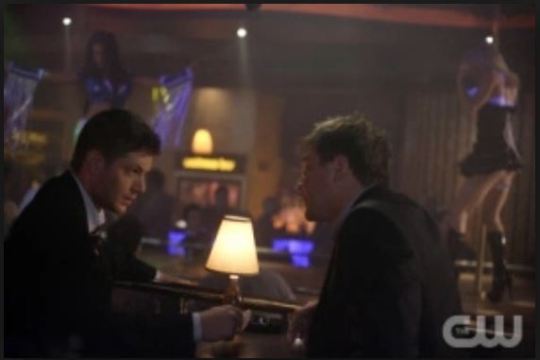
As Wincest subtext was a much more regular part of the show back then, there’s really no need to choose between them. All three readings are available - erotic, perfect brother companion, and erotic brother-companion.
The text of Sex and Violence does make it quite clear, however, that the Siren operates by sexual seduction. The victims, as Sam discovers talking to Cara, all had very high levels of Oxytocin (the “love hormone”) in their blood. Sam says, of the victims:
SAM: “It’s almost like they were under some kind of love spell.”
DEAN: “Sure seems that way.”
Later, this is added to in another conversation between the brothers:
DEAN: “So whatever floats the guy's boat, that's what they look like?”
SAM: “Yeah. You see, Sirens can read minds. They see what you want most and then they can kinda, like, cloak themselves. You know, like an illusion.”
The sexual element of that is emphaised by the Siren itself, in disguise as FBI agent Nick Munroe, who says of the previous vics:
NICK: “They were all banging strippers from the same club.”
The Siren was, in fact, disguising itself as female strippers for all the vics except Dean, for whom it chose a male FBI agent form.
In Sex and Violence, Sam and Cara are paired whilst Nick and Dean are paired, and Sam and Cara have sex (again, in subtext, emphasising the sexual element of the Siren’s seduction of Dean, via this mirroring). Yockey also makes use of a similar type of mirroring in Ouroboros, by having Sam and Rowena pretend to be a married couple, at the vets with puppy-Jack, at the same time that Dean and Cas are investigating the Gorgon crime scene together (in subtext, emphasing the “married couple” element of the Dean/ Cas contemporary partnership via this Sam/ Rowena mirror).
Just as Nick the Siren seduces Dean, Noah the Gorgon is also somewhat “seductive” towards Dean. He writes him a personalised note warning him off (addressed to Dean only, although Noah has seen that Rowena and Sam are part of the hunting team chasing after him, thanks to his eye-ball consuming visions). Dean himself picks up on something creepily erotic about Noah’s address (given they already know Noah is into cooking and eating dudes) when he says, in response to Cas’ query about why the Gorgon has failed to see Cas at Dean’s side in his vision:
DEAN: “Maybe you’re not his type.”
Later Noah does queer-target Cas (proving Cas is, in fact “his type” i.e. queer men) by giving the angel his seductive/poisoned kiss.
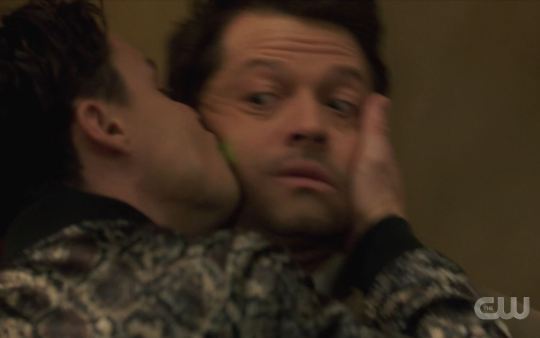
By linking the two episodes, narratively, numerologically and thematically, Yockey strengthens the queer reading of the earlier one, Sex and Viokence, by its mirroring in Ouroboros, by having Noah explicitly seduce male victims via poisoned kiss on camera (one of those kisses being on the lips):
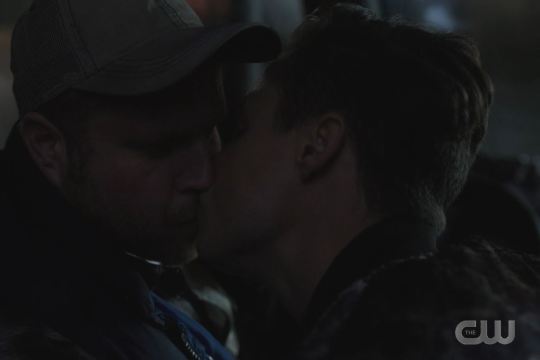
In Sex and Violence, we do not see a same-sex kiss. Instead, the Siren passes the poison, which is in his saliva, to Dean via a subtextual kiss (sharing swigs from Dean’s hip flask in Baby):
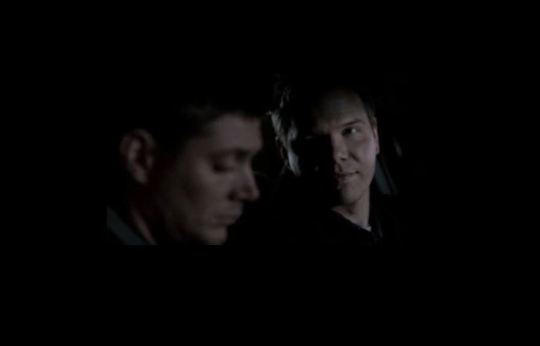
The Ouroboros narrative of Dean’s (and now Cas’) subtextual queerness has, in Yockey’s hands undertaken a tail-swallowing spiral, from male Siren to male Gorgon, but Yockey brings queerness more strongly into his text, via:
1) A more sympathetic “monstrous queer” character (yes, Noah the Gorgon eats people, but he’s lonely and miserable about it, whereas Nick the Siren was just gleeful about exerting eventual total power over his victims).
2) A monstrous character who’s more on the men-seducing end of the Kinsey scale. We don’t see Noah seduce any women (although he is seductively bisexual, as he tells us he eats women too) whilst see the Siren undertakes more hetero seduction, by approaching mostly men in female form (Dean being the exception).
2) An explicit M/M seductive kiss on screen (between the Gorgon and the trucker at the start of the episode) whereas there is only a sublimated exchange of M/M saliva, via the hip-flask, in Sex and Violence.
3) One of our queer-coded heroes himself (Castiel) does gets explicitly M/M kissed (albeit it is a monstrous, poisoned and non-con kiss).
I <3 everything about Ouroboros.
#Supernatural#14x14#Ouroboros#SPN meta#Meta#Dean is bisexual#Still subtext#But subtext IS part of narrative#4x14#Sex and Violence#All hail the queer Gorgon#Dean's male Siren#Mythological meta#The monstrous feminine#Queerness and the monstrous
141 notes
·
View notes
Text
TTDS: The Emerald Girl; Epilogue
Torture Tower Doesn’t Sleep: The Emerald Girl infomine under the cut
Scene 1
Hargain first learned of magic when he was twenty one. He’d discovered the “Ending Records” by chance, being an archaeologist. Most of them were destroyed, but through study of what little he could find he discovered miraculous techniques used by ancient peoples. He wanted to put those to use in the modern era.
Though he had people helping him early on, eventually the only person remaining was his childhood friend and fellow archaeologist, Thyful (who at some point became his wife).
Though he was widely mocked for his research in trying to create magic, he persisted. He and Thyful apparently spent close to ten years researching in a cottage far from people.
Finally, they reached a turning point. With no one to use as test subjects, Hargain used Thyful, who had only just given birth to their child recently. The experiment failed, and she died. Hargain was severely injured in the process.
However, the failed experiment somehow resulted in Hargain becoming a sorcerer himself. He disappeared, leaving his child abandoned. This child was later picked up by a traveling circus several days later. They named him Liam.
This all happened thirty years ago.
Scene 2
Pretty much all the top brass for Crossrosier and Hargain died at the mansion, which shocks the kingdom. Not only did this happen right next to the royal capital, but they have hardly any idea who did it. For a time the capital beefs up security in response to the people’s fear.
There are people glad for this—those in the government who oppose Crossrosier. With the leaders gone, they’ve lost their foothold both as a religion and an influence in politics.
Scene 3
In a bar in the capital city, Raymond and Liam are chatting over coffee (with Tsukumo drinking milk). Raymond is going to return to Romarius to report what happened, taking Tsukumo with him.
Upon being pressed by Raymond, Liam (who smokes, apparently, though he makes sure the smoke doesn’t reach Tsukumo) reveals that he is the son of Hargain and his first wife. He learned this himself when Hargain was married to his second wife. It was she who founded Crossrosier, not Hargain. Hargain only cared about his research into the Ending Records, but he needed money for that. So his wife made Crossrosier, using the disciples and believers who had already accumulated around him looking to get magic like he did.
That was why he fought against Beritoad with Romarius and Hank—to get the other Ending Records document that Beritoad had (he already had a piece of it himself but it wasn’t enough).
Liam learned this from Hargain himself, getting the story in bits and pieces as he worked with him as his servant. He never had the chance to tell him that he was his son—the timing never seemed right, and now he’s dead.
Hargain divorced his second wife, and married a third. She was a politician (from the house of commons, I think—Their country really is based strongly on the UK, as these are UK parliament political terms it looks like). She wanted to use Crossrosier to increase her political power. He married her similarly with the goal of increasing his wealth. She disappeared after losing in a political conflict (I’m a little vague on that but political defeat at least yes).
The next wife was a devout believer of Crossrosier—unfortunately, upon finding out that the organization was a sham, and that all the sorcerers outside of Hargain were unable to use real magic, she grew depressed. They did have a daughter born between them. Hargain had four children already (one from each of his wives), but this was the woman’s first child.
The little girl died in an epidemic before she reached three years old. The wife was distraught, walking around holding her corpse and crying. Hargain took the corpse away eventually, taking it to his lab. His wife ran after him, and saw that he’d put the baby in a giant tube of liquid.
Not just that one. The babies from his second and third wives too were all experimented on like that (which is why his wives all left him). Raymond has the horrifying suspicion that the children might have been murdered by Hargain specifically to experiment on (which Liam doesn’t confirm nor deny).
Anyway, the daughter from his fourth wife is what ended up becoming Tsukumo. This was not to revive his children, but a desperate bid to atone for what happened to Thyful, the only person he’d ever loved. Liam says seeing this hopeless goal made him lose both his anger at Hargain for abandoning him, and also his desire to be a family again—he just pitied him.
Scene 4
When they part, Raymond gives back the bracelet. It is what Hargain used to transmit his power to Tsukumo even as far away as Torcia Tower (transmitted to Liam, then from there transmitted to Tsukumo).
Liam has no real interest in using the bracelet anymore, so he hands it back. It might have more use for Raymond anyway—that he could convey his power to Tsukumo through it (Tsukumo is, again, an amplifier).
Back at the lake, Raymond had passed out in the lightning storm. When he awoke he, Liam, and Tsukumo were unharmed, and the wraiths were gone. He’s grateful that Tsukumo didn’t hurt him, not just for the obvious but because it serves as further proof that she sees him as human, instead of a wraith.
Liam does warn him to be careful—Hargain’s life was taken up by the strain of using it (though as a half wraith, Raymond’s probably more able to handle it). He also gives the Ending Records in Hargain’s possession to him, saying he can do what he likes with them.
Liam wants to go traveling and see the world now. Raymond has a lot to ask him, but he suspects Liam wouldn’t be forthright about it.
He does also think perhaps Hargain really did know that Liam was his son—Hargain is, after all, not a trusting man (hence why he never granted any of his followers real power). Yet, he’d trusted Liam with a great deal. But, there’s no way to know now.
Liam leaves. Raymond thinks on him a little more, on whether they’ll meet again and what Tsukumo is to him. In a way, she’s his half sister. But she was also created to atone for what happened to Thyful—Liam’s mother (it’s vague on if this means Hargain was directly trying to bring her back in a real sense or a metaphorical one).
Scene 5
Waiting for Raymond is a luxurious carriage and an old gentleman named Bateau (batoo), Romarius’ butler. He came because news reached them of Hargain’s death, and Romarius was too busy to come himself.
Raymond realizes that everything went pretty much according to Romarius’ plans. He got the records and Tsukumo in one fell swoop. Beritoad had never had half of Romarius’ Ending Records—he’d only given it up to Hargain knowing that it would cause his downfall, and that he would be able to quickly get it back.
He puzzles over whether to tell Romarius about the bracelet or not (basically, whether he should reveal Tsukumo can still fight using it). He tells Tsukumo whether they’re headed (she’s already forgotten about the mansion and Hargain). Ultimately, on thinking it over he decides not to tell Romarius—let him think that she’s been rendered a helpless little girl, so he won’t be inclined to use her.
Bateau makes a verbal slip—he implies that Romarius has another plan going on, and that he’s after more in Torcia Tower than just Beritoad’s alchemy magic. He refuses to elaborate when questioned on it.
Scene 6
It’s raining on Torcia Tower. Rabiah and Beritoad are talking in the chapel. Beritoad is grouchy, of course. Rabiah brings up Gibbet—they’re vague, but it’s implied that her going out so much brings risk of her memories coming back, but Beritoad had no choice because she’s the only one who could leave the tower. When Rabiah suggests she’s not needed anymore now that he’s back, Beritoad refuses, saying she’s more reliable than he is (which Rabiah thinks is a bit of a lie, but he’s not sure what Beritoad is hiding).
Gibbet comes in just then, unaware they were talking about her. She’s glad to see they’ve made up (she, I think, references how Rabiah claimed they fought over a woman, which judging by Beritoad’s reaction is not quite what happened).
Gibbet is there to report on another incident (I think perhaps the thing that happened way earlier in the novel with the town mayor being murdered? It’s vague). Beritoad orders her to have Rabiah look into it, while she continues luring prey to the tower.
Gibbet goes to have tea. Rack and Maiden are currently performing their duties cleaning and repairing the tower. They’re still injured and burned from the lightning—but the lightning didn’t strike Gibbet (I think it’s clear at this point that she isn’t a wraith, hence why it missed her, because Tsukumo only attacks wraiths). As the only one uninjured, she’d been the one to rescue the other wraiths. The horses had been hurt, but they were far enough away that they could still pull the carriage with all of them in it.
Gibbet feeds the horses, who are currently staying in the first floor.
She has to prepare to go out again to get more victims. The Torture Tower doesn’t sleep.
8 notes
·
View notes